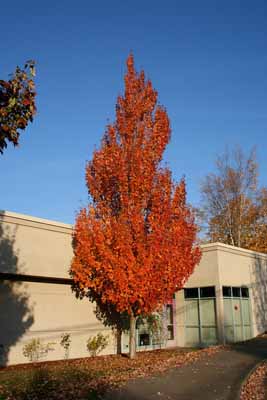
Acer freemani 'Armstrong'
Armstrong Maple
This large deciduous tree has a narrow, columnar form and glossy green leaves that turn brilliant yellow-orange in fall. An extremely showy specimen
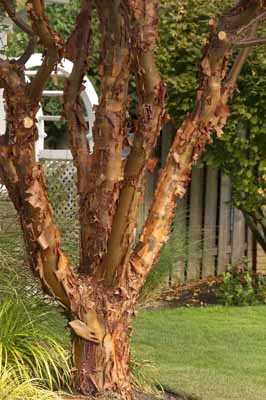
Acer griseum
Paperbark Maple
This attractive small- to medium-sized ornamental tree is excellent for a small area or for adding structure to a mixed perennial garden. Paper-barked maple is a great plant for four seasons: Winter and spring are highlighted with cinnamon-colored, exfoliating bark that is accentuated by light snow, while summer brings delicate leaves with a bluish cast that can turn bronze in fall.

Acer palmatum 'Bloodgood'
Upright Japanese Maple
Bloodgood' remains a tried and true landscape favorite. It is a hardy, vigorous problem - free tree with symmetrical, round branching. A multi - stemmed small tree that shows off its silvery bark, crimson stems, and burgundy star shaped leaves. For best performance provide afternoon shade and keep its roots cool.
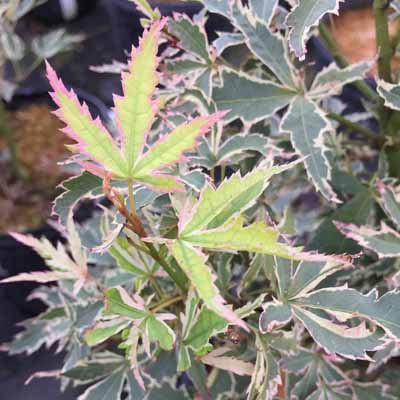
Acer palmatum 'Butterfly'
Butterfly Japanese Maple
Butterfly has been around for a long time, but is still one of the most underused Japanese Maples and one of the best for giving you outstanding bang for the buck. One look at its incredible foliage will have you hooked right from the start as its emerging foliage is spectacular in the spring with pink margins surrounding deeply cut, small delicate leaves that mature as spring progresses to a soft blue-green shade with a cream colored, pink tinged variegated edge. This color, along with the texture and the fact that the mature leaves curl, give Butterfly a unique and very attractive look that you ll love. Butterfly is one of the slowest growing, smallest scale Japanese Maples with its upright, vase shape being perfect for smaller spaces in sun or partial shade.

Acer palmatum 'Orido Nishiki'
Orido Nishiki Japanese Maple
Prized for colorful foliage. Excellent Specimen Tree. Dense, Rounded form. Pink, green, and cream foliage.
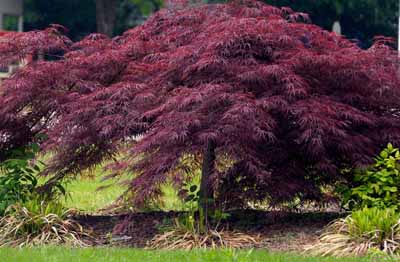
Acer palmatum dissectum 'Crimson Queen'
Crimson Queen Japanese Maple
A low-branching, dwarf tree with a delicate, weeping form. The foliage holds its beautiful crimson color throughout summer and can turn bright scarlet in autumn. Sun-tolerant in cooler regions, where sunlight intensifies the foliage color. Site in a bright dappled shade setting elsewhere.
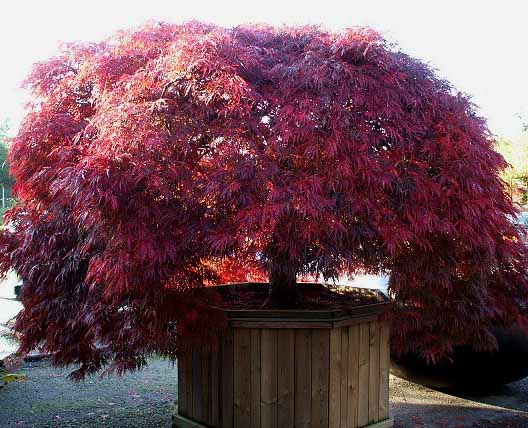
Acer palmatum dissectum 'Garnet'
Weeping Japanese Maple
With a dense, spreading, cascading form, this plant will become a staple in your landscape. Its large, broadly dissected threadlike foliage begs to be touched. The foliage emerges in early spring bright red then matures to a stunning purple - garnet red color.
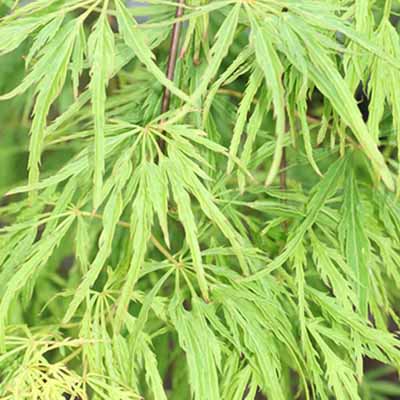
Acer palmatum dissectum 'Green Mist'
Japanese Maple
A beautiful, rounded, small ornamental tree. Graceful, weeping branches clothed in feathery, finely cut, light green foliage that turns yellow-red in fall.
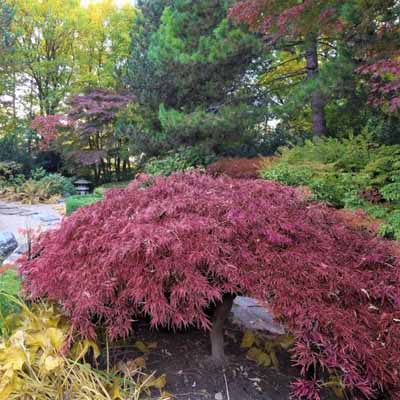
Acer palmatum dissectum 'Inaba Shidare'
Weeping Japanese Maple
This selection is one of the more vigorous growing dissected leaf types and one of the most hardy. Lacy, deeply cut foliage can be up to 6 long and wide with striking purple - red color providing great landscape texture on a rounded, flowing plant that turns a crimson red in the fall.
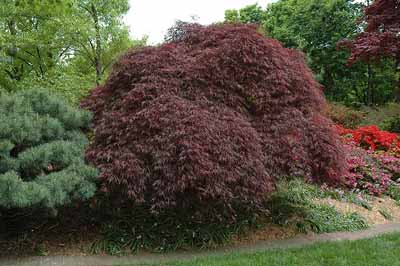
Acer palmatum dissectum 'Red Select'
Weeping Japanese Maple
A vigorous, weeping small tree with lacy purple-red foliage throughout the summer. Fall foliage ranges from crimson to yellow and orange. A beautiful small specimen or accent that provides great contrast to green-leaved plants. Works well for containers. Deciduous.
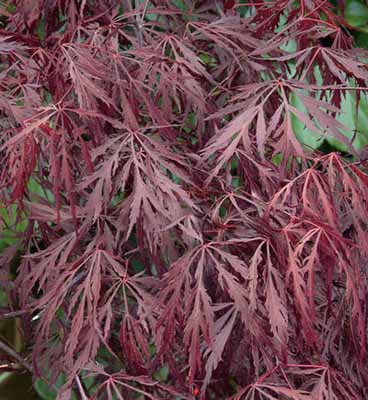
Acer palmatum dissectum 'Tamukeyama'
Weeping Japanese Maple
Great texture and great leaf color combine to make this one of the most desired threadleaf Japanese Maples. With a low, spreading form this plant's highly cut foliage holds its deep purple color all season and makes a perfect specimen for any landscape.

Acer palmatum dissectum 'Viridis'
Japanese Maple
Vivid green, finely cut leaves change to beautiful shades of gold and crimson in the fall. Small tree with graceful weeping habit and excellent branching architecture. An excellent accent under larger trees, near a water garden or in container. Thrives in dappled sun. Deciduous.

Acer palmatum dissectum 'Waterfall'
Weeping Japanese Maple
This bright green leaved selection of weeping maple creates a flowing landscape form with layers of pendulous branches covered with deeply lobed, threadlike leaves producing superb texture. This plant is stunning when used near a water garden and in the fall when its leave turn a bright yellow.
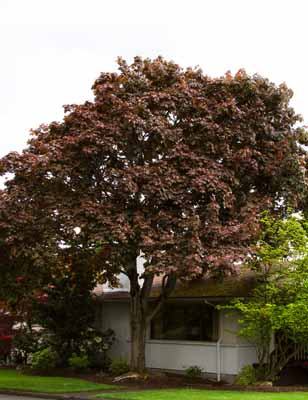
Acer platanoides 'Crimson King'
Crimson King Norway Maple
This bold landscape tree creates dense shade with its large, deeply lobed leaves. The maroon-purple foliage makes a distinctive and dramatic statement alongside green-leafed conifers. Foliage develops a reddish-bronze color in the fall. An excellent lawn or park tree. Slower growing than others of its species. Deciduous.
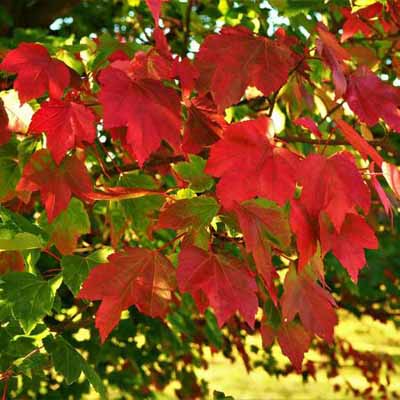
Acer rubrum 'October Glory'
Red Maple
Outstanding, reliable, bright orange to deep, reddish purple fall color - even in warmer climates. A tall form with a dense, rounded crown and large, medium green leaves in spring and summer. Foliage is held on the tree later into fall than with most cultivars. A superb choice as a high profile shade tree for larger landscapes. Deciduous.
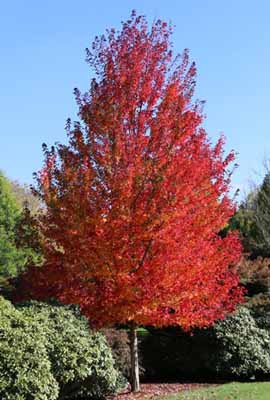
Acer rubrum 'Redpointe'
Red Maple
Beautiful pyramidal maple with a relatively carefree growth habit, narrower than others, making it an excellent large shade tree for more compact landscapes. Highly adaptable, pest and disease-free, and resistant to leaf chlorosis. Dark green, heat resistant foliage turns a brilliant red in early autumn. Excellent cold hardiness. Deciduous.

Acer saccharum
Sugar Maple
Large, upright maple tree. Green foliage on spreading limbs. Brilliant fall leaf colors. Excellent landscape tree.
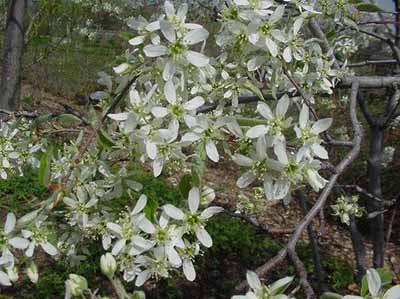
Amelanchier canadensis
Shadblow Serviceberry
The flowers yield deep-purple fruits that are enjoyed by birds and wildlife. In fall, the leaves change to brilliant shades of yellow to re
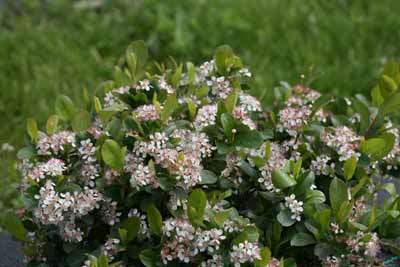
Aronia 'Low Scape Mound'
Chokeberry
Low-growing groundcover shrub, providing beauty from spring through frost. Low Scape Mound aronia is a tough, tolerant, tidy little mound of glossy green foliage. In spring, it's covered in hundreds of dainty white flowers, and in autumn, the leaves turn brilliant red to contrast with dark purple-black fruit. The unique low-growing, mound-shaped habit of this new variety makes it perfect for mass planting as a ground cover or edging plant. Best of all, it thrives almost anywhere: cold climates and hot ones, wet soils and dry ones, sun and part shade. This native shrub will gracefully handle just about any landscape challenge you can throw at it!
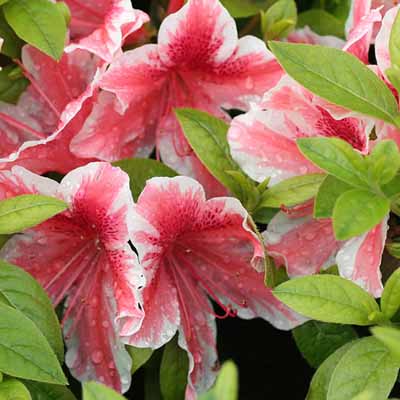
Azalea 'Ben Morrison'
Azalea
Upright evergreen shrub. Orange and pink flowers with white stripes cover the plant in spring. Later blooming variety. Attractive shrub even when not in bloom.

Azalea 'Blaauw's Pink'
Azalea
Soft salmon peach-pink blooms emerge in abundant small, funnel shaped flowers in mid April to early May. Dark green foliage throughout the summer. This slow growing evergreen azalea stays compact and semi-upright. Pleasant to the eye, a great choice for brightening a partly shady patio or courtyard garden.
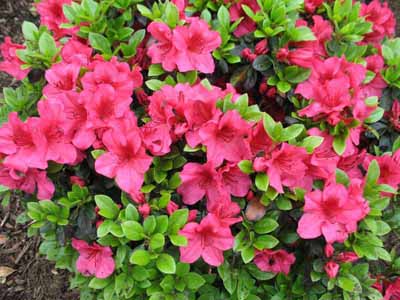
Azalea 'Girard's Crimson'
Azalea
Dense and spreading, the selection is very hardy and one of the most dependable bloomers of any of the azaleas grown. Shiny, deep green foliage keeps well through the winter and serves as a backdrop for big, 2.5 crimson - red flower in early May.

Azalea 'Girard's Fuchsia'
Azalea
Exceptional reddish - purple flowers in early to mid - May, along with dark glossy foliage really make this selection stand out! Very hardy with excellent winter leaf retention.

Azalea 'Girard's Hot Shot'
Azalea
A prolific bloomer displaying single, reddish-orange flowers. Remains evergreen in milder climates, semi-evergreen elsewhere. Terrific effect used in mass for a colorful show. Orange-red fall foliage. Semi-evergreen.
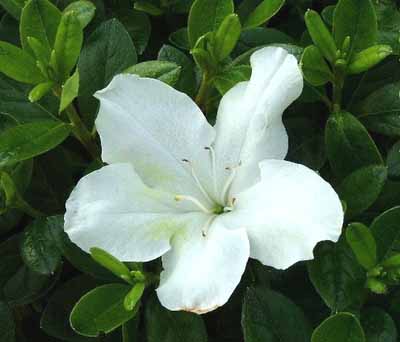
Azalea 'Girard's Pleasant White'
Azalea
The single, rounded white flowers which appear in late May are up to 3" across on this Girard hybrid Azalea. It's large, spreading habit makes it a great landscape Azalea. The green foliage is lighter than most other Girard types.
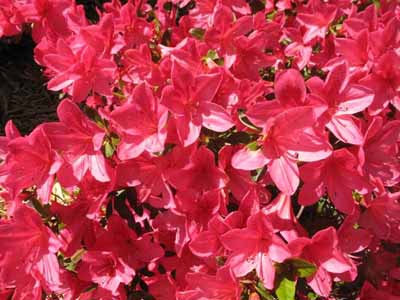
Azalea 'Girard's Renee Michelle'
Azalea
Very deep pink, ruffled flowers have a dark pink-spotted throat. The profusion of blooms creates a thrilling spring specimen, excellent for use as a hedge, in borders or in a mass planting for an impressive color display

Azalea 'Gumpo Pink'
Azalea
Dwarf evergreen shrub displays extremely showy single light pink flowers late in the season. Lush foliage on dense twiggy branches. A lovely accent and welcome addition to the landscape.
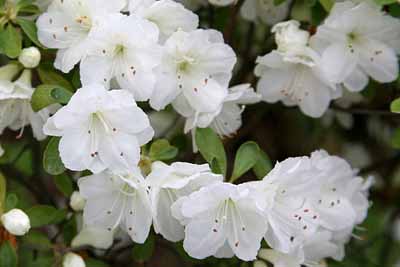
Azalea 'Gumpo White'
Azalea
Dwarf evergreen shrub displays extremely showy single white flowers late in the season. Lush foliage on dense twiggy branches. A lovely accent and welcome addition to the landscape.
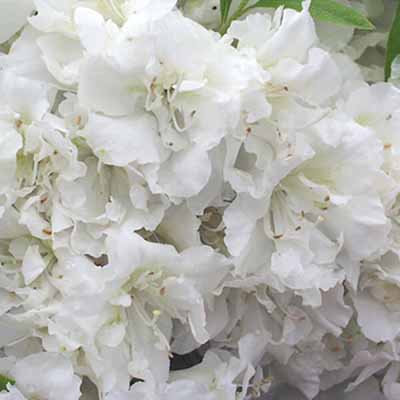
Azalea 'Helen Curtis'
Azalea
Blooms in spring. Nice in color accent border. Low growing, rounded shrub. Semi Double, white flowers
.jpg)
Azalea 'Hino Crimson'
Azalea
An excellent choice for an azalea. Clusters of deep red blooms in spring, followed by wonderful bronze foliage in winter.
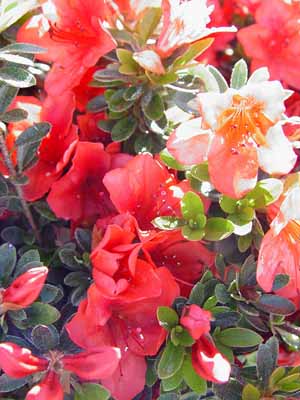
Azalea 'Joseph Hill'
Azalea
Native,bright red flowers make it a must! Dark, true evergreen foliage makes this hardy selection an excellent groundcover.
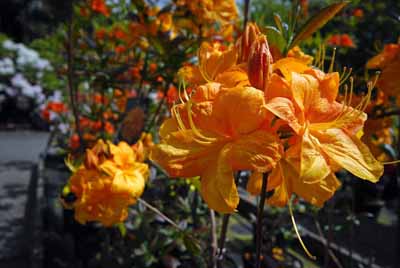
Azalea 'Klondyke'
Azalea
Spectacular decidious shrub covered with golden orange blooms. Flowers generally occur before leaves emerge
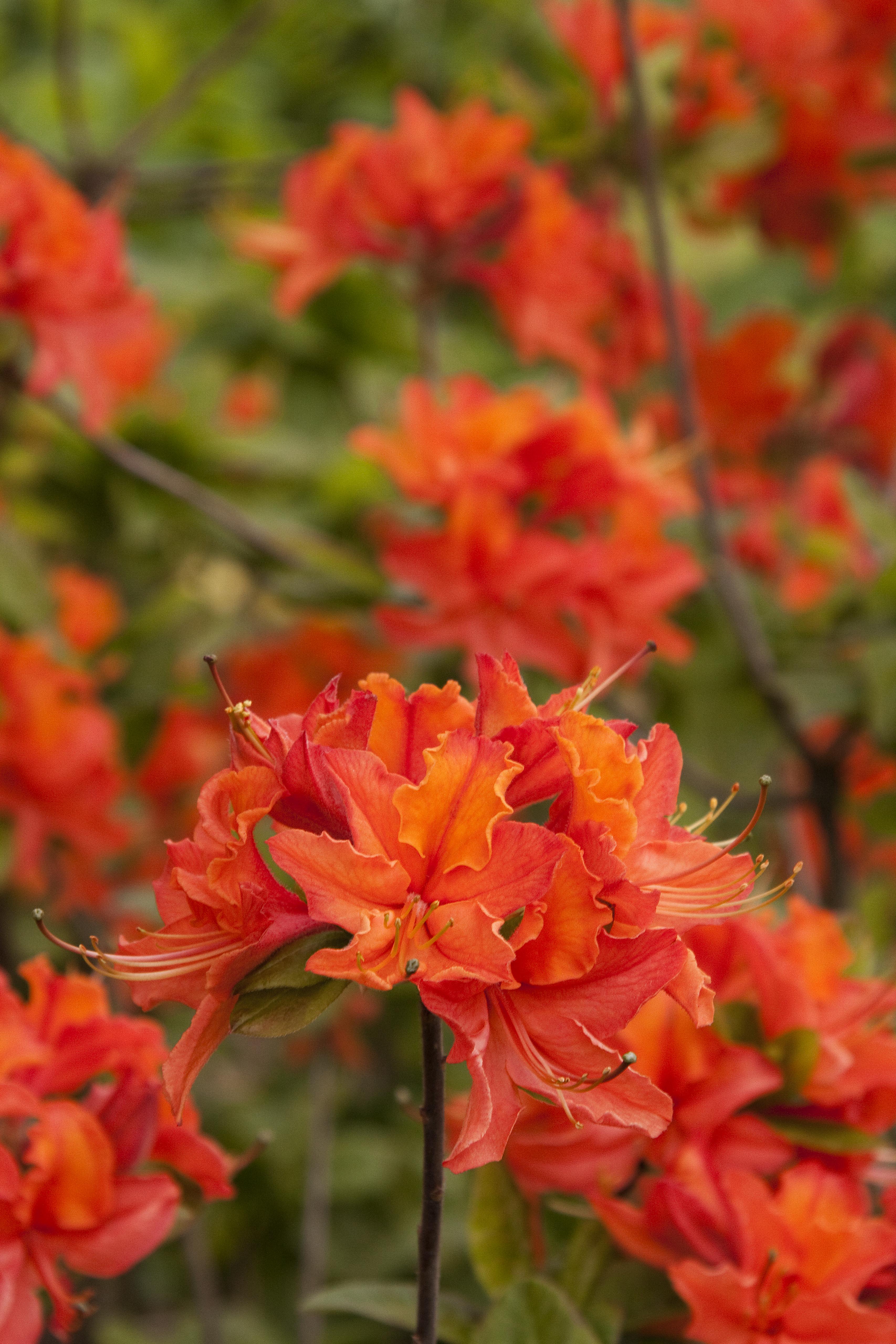
Azalea 'Mandarin Lights'
Azalea
An extremely hardy selection that provides a massive display of bright, mandarin orange blooms in the spring before the foliage emerges. The small mounding form with lustrous green foliage is excellent for use as an accent plant, or for mass plantings and shrub borders. Deciduous.
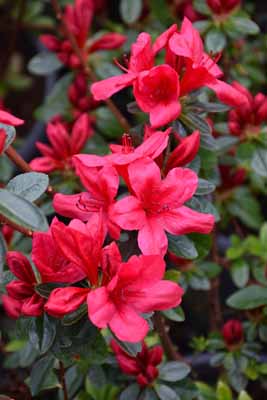
Azalea 'Red Red'
Azalea
Red Red Azalea is covered in stunning clusters of lightly-scented red trumpet-shaped flowers at the ends of the branches in mid spring before the leaves. It has olive green foliage throughout the season. The small glossy narrow leaves turn an outstanding yellow in the fall.
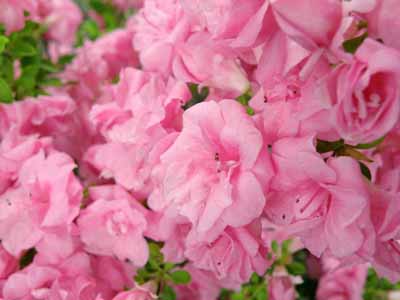
Azalea 'Rosebud'
Azalea
This longtime favorite is true to its name, with blooms recalling the classic beauty of roses. Shell pink rosebuds open to rosy pink double flowers in spring. This selection is characterized by slow spreading growth and remains neat and tidy in the landscape. Evergreen.
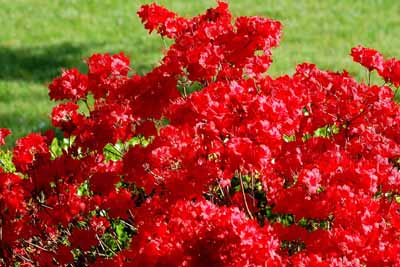
Azalea 'Stewartstonian'
Azalea
Makes for a great hedge or accent. Has beautiful vivid red flowers which attract butterflies.
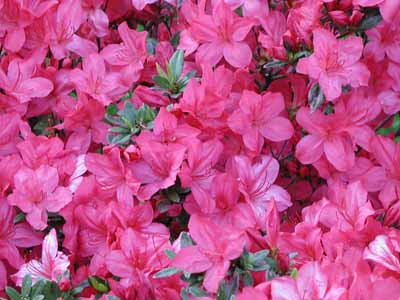
Azalea 'Tradition'
Azalea
Very heavy bloomer with medium pink flowers that make a wonderful spring show. Flowers are backed by tiny evergreen foliage on a low spreading form

Azalea `Arctic Rose`
Azalea
The deep green foliage edged in white color add a crispness throughout the growing season, forming a dense, round, spreading shape in the landscape that is at home in any wind - shielded partly shady spot. In May rose red flowers open by the hundreds keeping the foliage in the background for up to 3 weeks at a time.

Azalea Encore 'Autumn Fire'
Encore Azalea
This dwarf azalea packs a powerful punch of rich, true red color with semi-double velvety blooms. Its glossy, dark green foliage deepens to a saturated purple bronze in winter adding year round appeal to gardens.
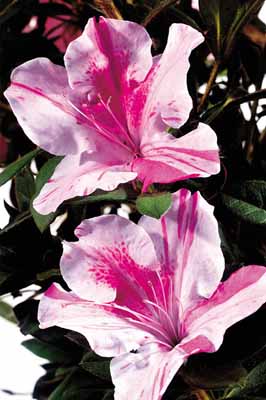
Azalea Encore 'Autumn Twist'
Encore Azalea
This fast growing variety boasts large bi-color and occasional solid purple blooms. Rebloomer.
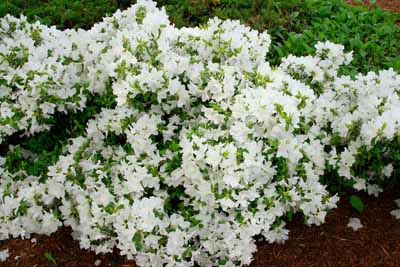
Azalea indica 'Delaware Valley White'
Azalea
Pure white, single 2 to 4 in. flowers cover the vigorous, upright, evergreen shrub with lush green foliage. Makes a lovely accent, border or hedge.

Azalea kaempferi 'Johanna'
Azalea
Reliable performer is great in the landscape. Winter foliage turns from rich green to bronzy purple. Full shade tolerant. Great seasonal color is followed by outstanding fall foliage.
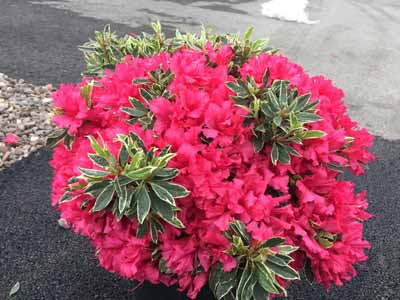
Azalea kaempferi 'Silver Sword'
Azalea
Vivid bright pink flowers age to red and practically smother the variegated foliage in early spring. Unique deep green leaves have narrow creamy yellow margins.
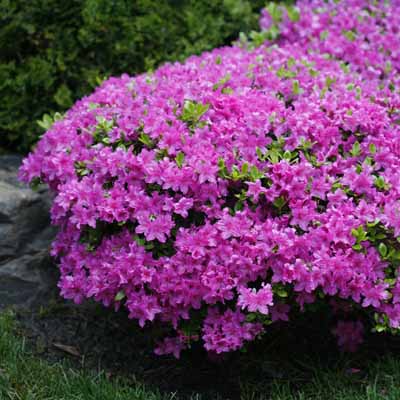
Azalea poukhanense 'Compacta'
Azalea
A hardy semi-evergreen shrub valued for its abundance of charming lavender-pink flowers in early spring. The handsome, deep green foliage is held on dense branches. A great choice for use as a hedge, in borders or in a massed planting

Berberis 'Crimson Pygmy'
Dwarf Japanese Barberry
A dwarf, densely branched form displaying deep crimson colored foliage all season long. Best color when planted in full sun. Excellent color contrast against green or gold-leafed plants. A great choice for mass plantings, particularly as a low hedge or border plant. Deciduous.
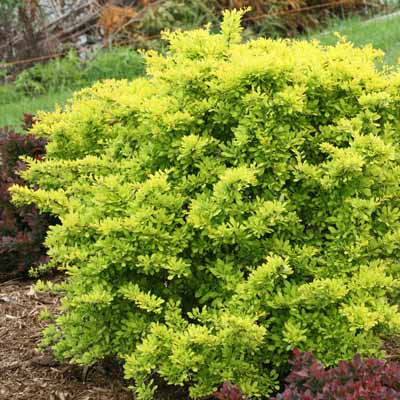
Berberis 'Sunjoy Citrus'
Barberry
Golden barberry just got better! This bright barberry has a neat, rounded habit that results in a uniformly ball-shaped plant. It makes an excellent low-maintenance hedge, needing little if any pruning to maintain its shape. This plant was evaluated for over five years in full sun to ensure excellent burn-resistance, so it will perform better in full sun than other yellow barberries.

Berberis 'Sunjoy Gold Pillar'
Barberry
This is an easy way to add both vertical lines and bright color to your home landscape. Similar in shape to 'Helmond Pillar' barberry, but with orange-red new growth that matures to vivid gold. Autumn brings stunning orange-red color. Proven to be burn resistant in side by side tests with other yellow leaf barberry. Plant Sunjoy Gold Pillar barberry as a low-maintenance hedge or edging, or add it to a border as an specimen plant.
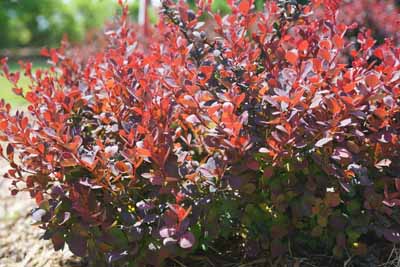
Berberis 'Sunjoy Mini Maroon'
Barberry
This sterile barberry is not invasive! Finally, a colorful, care-free barberry that won't make a nuisance of itself: Sunjoy Mini Maroon . It took Dr. Tom Ranney over ten years to develop, but the results were worth it. Sunjoy Mini Maroon barberry offers sumptuously deep purple-red foliage on a dense, nicely shaped mound. It needs no pruning to stay small and lush, and like all barberry, it is highly resistant to damage from deer and rabbits. And it does it all without producing the seeds which have made other varieties so problematic. Simply put, it's a better choice.

Berberis 'Sunjoy Mini Saffron'
Barberry
Looking for an easy-to-grow, small plant that's colorful all season? This is it! Sunjoy Mini Saffron barberry has bright yellow foliage that shows hints of orange in the new growth. It will turn orange-red in the fall. Unlike other yellow-leafed barberry, it is very burn-resistant, and does well even in the heat of the summer.
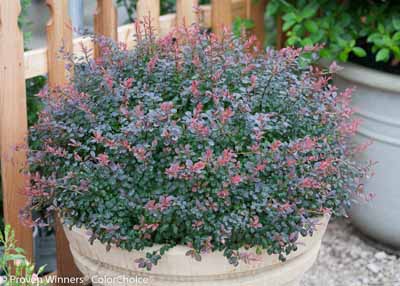
Berberis 'Sunjoy Mini Salsa'
Barberry
An improved version of the popular 'Crimson Pygmy' with vivid, dark red foliage that looks great from spring to fall. This is an excellent plant for adding low-maintenance, season-long color to landscapes. Use it for edging beds and borders, or as a mass planting. It does not revert as does 'Crimson Pygmy' so is consistently compact and colorful.
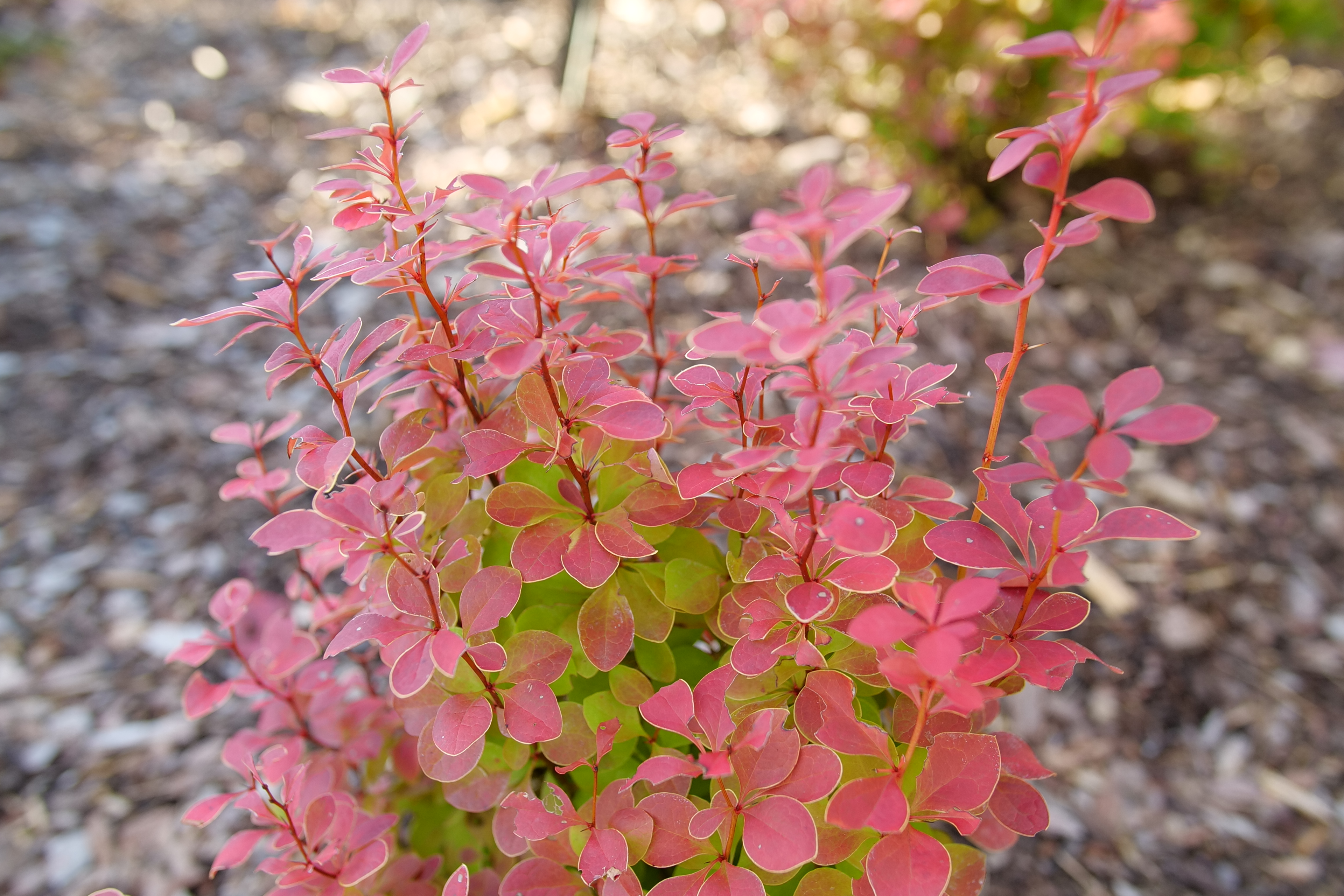
Berberis 'Sunjoy Orange Pillar'
Barberry
The same incredible neon orange foliage as Sunjoy Neo barberry, but with the useful, versatile habit of best-selling Sunjoy Gold Pillar barberry. Developed by Dr. Tom Ranney and his team at NCSU. Top reasons to grow Sunjoy Orange Pillar barberry:- Versatile, appealing shape adds drama and flair- Vibrant, persistant neon orange coloring. Very deer resistant.
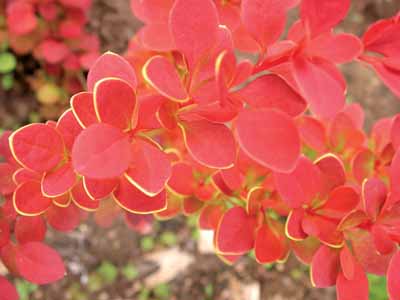
Berberis 'Sunjoy Tangelo'
Barberry
A zingy accent to spice up your landscape! Bright and cheery, this new barberry has vivid orange new growth that develops a distinctive chartreuse margin as the season goes on. Stronger growing than other variegated cultivars, it is colorful in the landscape from spring to fall. Deer resistant.
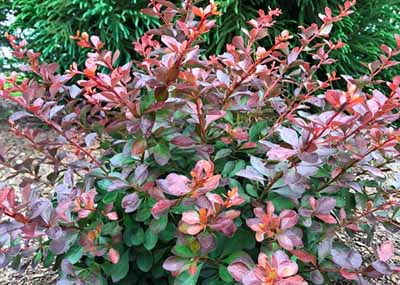
Berberis 'WorryFree Crimson Cutie'
Barberry
At last! A seed free version of compact Barberry that IS NOT invasive! This UConn bred selection will grace the landscape with dense, compact form and deep, purplish-red foliage that will shine. Easy to grow, colorful and deer resistant.
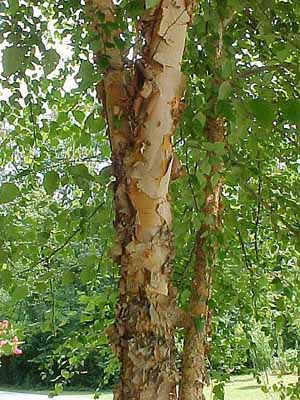
Betula nigra 'Cully' Heritage
Heritage River Birch
Vigorous, clump- forming decidous tree. Papery, reddish-brown, peeling bark. Glossy green foliage turns yellow into fall. Excellent focal point in the landscape
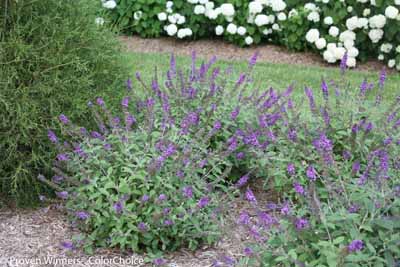
Buddleia 'Lo & Behold Blue Chip Jr.'
Butterfly Bush
This Butterfly Bush variety is compact, reblooming, non-invasive, drought-tolerant with frangrant flowers. Deadheading is not necessary. Attracts pollinators.
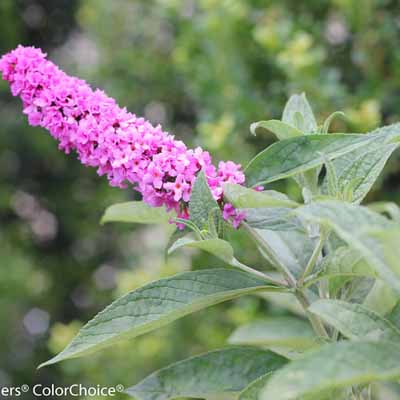
Buddleia 'Lo & Behold Pink Micro Chip'
Butterfly Bush
Lo & Behold 'Pink Micro Chip' is the smallest member yet of this series of award-winning dwarf butterfly bush. It's a tiny and tidy mound of orchid-pink flower spikes, with a cute pincushion-like habit that makes it perfect for including in perennial gardens. Earlier blooming than other butterfly bush, which means you get non stop color from early summer clear through frost. Highly deer and rabbit resistant, too! Fragrant flowers!
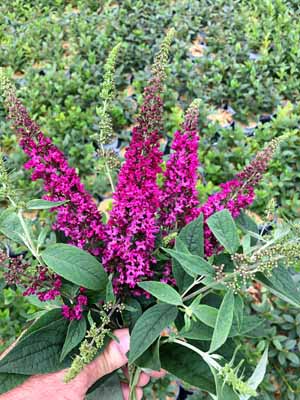
Buddleia 'Lo & Behold Ruby Chip'
Butterfly Bush
Finally - a butterfly bush with the neat habit of the Lo & Behold series, with the jaw-dropping color intensity of the "Miss" series! Lo & Behold Ruby Chip butterfly bush brings together the best of both, with a tidy 2.5'/.76m size and dozens of magenta-ruby flower spikes. Fragrant and long-blooming, it keeps putting out fresh flowers without the need to deadhead (i.e., remove old brown flowers). Perfect for flower gardens or landscapes. Deer resistant.
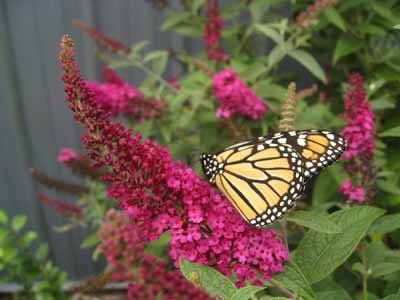
Buddleia 'Miss Molly'
Butterfly Bush
Enjoy the reddest color of any butterfly bush. With its intensely colored blooms and refined habit, 'Miss Molly' is the queen of the summer garden. Its fragrant flowers are the closest to red of any butterfly bush and appear for months every summer without deadheading. Unlike older varieties of butterfly bush, 'Miss Molly' reaches just 4-5'/1.2-1.5m tall, so it's easy to work into any sunny landscape. This non-invasive variety thrives in hot climates. Butterflies and hummingbirds will find it as irresistible as you do!
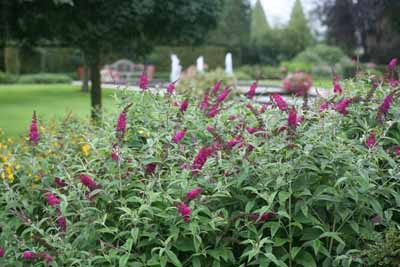
Buddleia 'Miss Ruby'
Butterfly Bush
Brilliant rich pink summer blooms unlike any other variety. Attracts butterflies and hummingbirds. Fragrant. Deer resistant. Like all of the "Miss" series, 'Miss Ruby' butterfly bush is non-invasive.

Buddleia 'Miss Violet'
Butterfly Bush
Just like her sisters, 'Miss Molly' and 'Miss Ruby', 'Miss Violet' is a compact plant with vibrant flower color, but with loads of dark purple-violet summer flowers. Seedless and non-invasive; deer resistant, too! Winner of a Green Thumb award from the Direct Gardening Association.
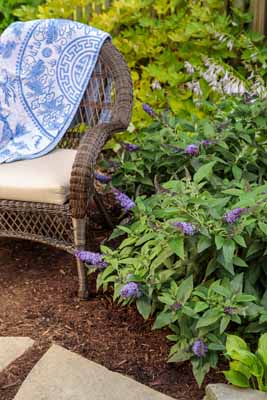
Buddleia 'Pugster Blue'
Butterfly Bush
Full sized flowers on a dwarf plant! Meet Pugster Blue - it's a whole new look for butterfly bush. This compact plant reaches just 2'/.6 m tall and wide but has the large, full flowers normally seen on a much larger plant. It blooms non-stop from early summer through frost with true-blue flowers, each with a tiny yellow-orange eye in the center. Thanks to thick, sturdy stems, the Pugster series offers vastly improved hardiness and winter survival over other types of dwarf butterfly bush.
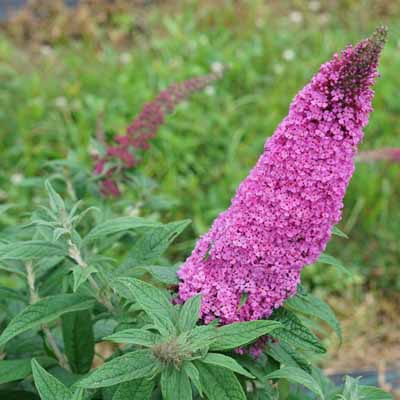
Buddleia 'Pugster Pinker'
Butterfly Bush
Full-sized flowers on a dwarf plant! Meet Pugster Pinker butterfly bush - the newest member of a unique series that offers full-sized flowers on dwarf plants. This compact butterfly bush reaches just 2'/.6 m tall and wide but has the large, full flowers normally seen on a much larger plant. It blooms non-stop from early summer through frost with very rich pink flowers, each with a tiny bright orange eye in the center. Thanks to thick, sturdy stems, the Pugster series offers vastly improved hardiness and winter survival over other types of dwarf butterfly bush.

Buddleia davidii 'Bicolor'
Butterfly Bush
The bi-color variety of butterfly bush has frangrant peach, purple, and pink flowers. Foliage is silvery green on this deciduous summer flowering shrub.
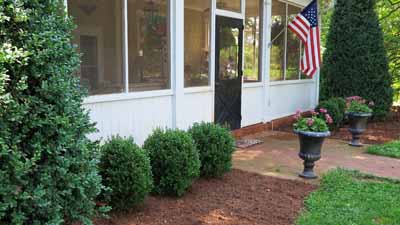
Buxus 'NewGen Freedom'
Boxwood
NewGen Freedom is an excellent boxwood. It was selected due to its better resistance to Boxwood Blight and resistance to Boxwood Leafminer. Its vigor helps it create an attractive plant quicker than many cultivars but it also makes annual pruning a must. With annual pruning, this plant makes a fabulous specimen. Grows 3-6 inches per year. NewGen Freedom is a relatively vigorous, rounded cultivar that is slightly taller than wide. It has beautiful glossy medium green foliage. Its habit is more uniform and tighter than Buxus microphylla Wintergreen or Buxus microphylla Winter Gem thus making it an excellent choice for many formal and residential landscapes. Deer resistant!

Buxus 'NewGen Independence'
Boxwood
NewGen Independence was chosen based on its better resistance to Boxwood Blight as well as its good performance in Boxwood Leafminer trials. It's growth is similar to Buxus microphylla Green Beauty but has much better Boxwood Leafminer resistance and the leaves are slightly more elongated. Grows 2-4 inches per year. NewGen Independence was a chance seedling found in the Williamsburg, Virginia area. NewGen Independence is a very deep green medium sized cultivar that holds excellent color throughout the winter. It has a rounded habit that is nearly as tall as wide. NewGen Independence can be used in formal plantings where a medium sized round plant is desired. Would be a replacement for Buxus sempervirens Suffruticosa (English Boxwood) for foundational plantings. Branching structure is very strong allowing it to withstand most moderate to heavy snow loads. Deer resistant.
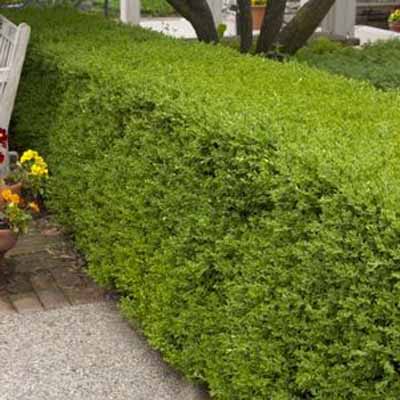
Buxus 'Winter Gem'
Boxwood
We talk a lot about "winter interest" ? let's talk now about spring, summer, autumn AND winter interest, because that's what you get when you plant 'Winter Gem'. Let's start in the spring, when lime-green new growth explodes in a burst of chartreuse on stunning yellow young stems. This vigorous grower quickly becomes blanketed with fresh green, delightfully shiny foliage for the warm summer months. Late summer brings deep green, glossy, sun tolerant leaves that will delight you as they transition into autumn with their light golden bronzing to mark the descending temperatures. 'Winter Gem' is one of the easiest of the Boxwoods to grow and as easy to prune as the rest. In fact, a couple of light trims in season will encourage a neat compact form that will serve it well, whether it is being used as a specimen or it is grouped in sun or partial shade to produce a hedge or border planting.
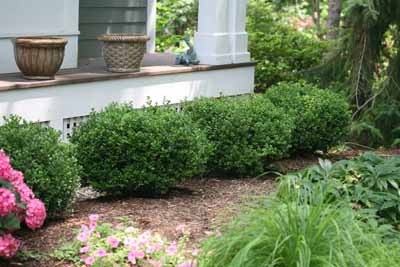
Buxus microphylla 'Sprinter'
Boxwood
Evergreen. Deer-resistant. Fast-growing. Salt tolerant. Popular low hedge featuring interest in all seasons.
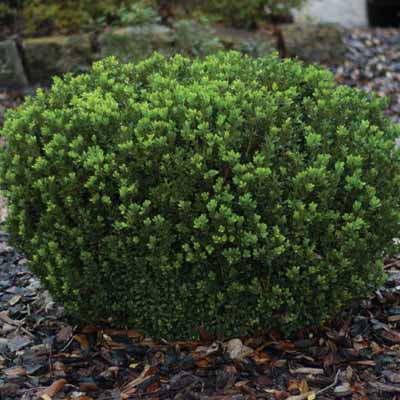
Buxus microphylla japonica 'Baby Gem'
Boxwood
Great, compact growing Boxwood is both heat and drought tolerant with year round dark green foliage color. Holds color in winter cold. Low maintenance evergreen is great for foundations, edging or border uses.
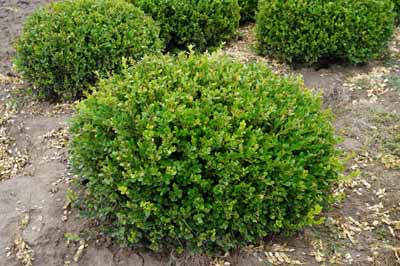
Buxus microphylla japonica 'Winter Gem'
Boxwood
Popular evergreen shrub which is among the hardiest boxwoods. Beautiful dark green foliage makes it a good choice for low hedge.
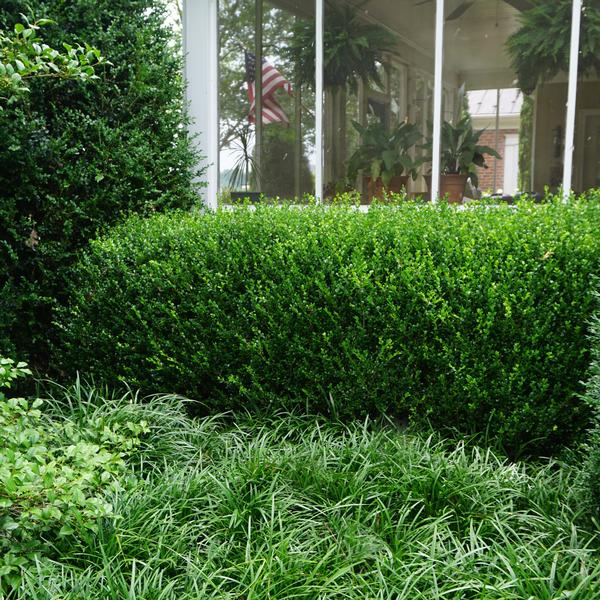
Buxus microphylla japonica 'Wintergreen'
Boxwood
Wintergreen is a vigorous, winter-hardy cultivar that is ideal when a medium to large foundation plant is desired. It is great for use in medium-sized hedges and is very tolerant of pruning or shearing. It has a tendency to bronze when exposed to direct winter sun but the bronzing will quickly disappear as temperatures rise in spring and as new growth emerges. It is very similar to Winter Gem and Faulkner . Deer resistant.
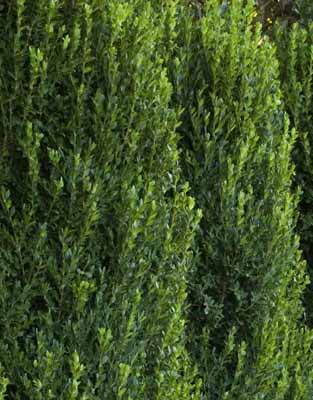
Buxus sempervirens 'Green Mountain'
Boxwood
Distinctly upright and conical with a broad base, this cultivar has a large range of landscape uses from specimen to hedging. Great green color has year - round staying power.
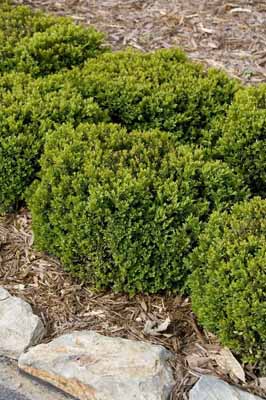
Buxus sempervirens 'Green Velvet'
Boxwood
The foliage on this low, rounded evergreen will stay luxuriously green whether in the blazing sun or in winters up to - 20F. This is the plant for you if you want a low - maintenance evergreen easy - keeper to shape or let grow naturally.
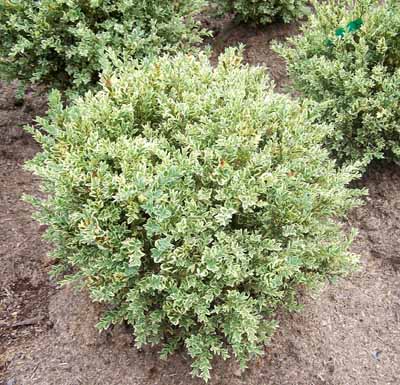
Buxus sempervirens 'Variegata'
Variegated English Boxwood
Eye appealing varigated foliage makes it a beautiful choice for foundation planting. Dense growing evergreen.
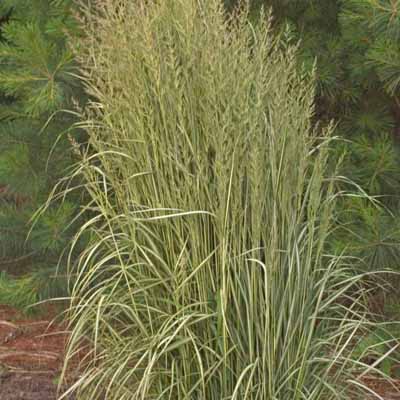
Calamagrostis acutiflora 'Avalanche'
Variegated Feather Reed Grass
Avalanche' has the same narrow upright habit as 'Karl Foerster' but has an added bonus - variegated foliage! Deep green foliage carries a wide band of white down the middle of the blade bringing even more interest to an already superb grass. Plant it in full to part sun.

Calamagrostis acutiflora 'Hello Spring'
Feather Reed Grass
This cool season grass has stunning, crisp variegation in green and white. White blooms in summer through fall. Refined growth habit, reaching 3 to 4 feet tall and wide. Excellent when planted in mass.

Calamagrostis acutiflora 'Karl Foerster'
Feather Reed Grass
The only grass to ever have been voted Perennial Plant of the Year. This outstanding grass adds a wonderful vertical element to the garden. One of the first ornamental grasses to flower, its June blooms fade to a tawny brown and are attractive throughout the winter.

Calamagrostis acutiflora 'Lightning Strike'
Feather Reed Grass
Foliage features broad central stripes of creamy white, edged in green.
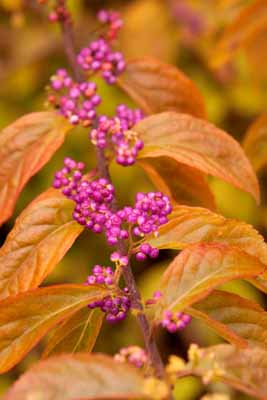
Callicarpa dichotoma 'Early Amethyst'
Beautyberry
Massive quantities of small, ornamental, amethyst-colored fruits appear along the slender, arching branches, following the clusters of small, pinkish lavender summer blooms. Green foliage gives way to gold fall color. An easy to grow hedge or foundation plant. Deciduous.
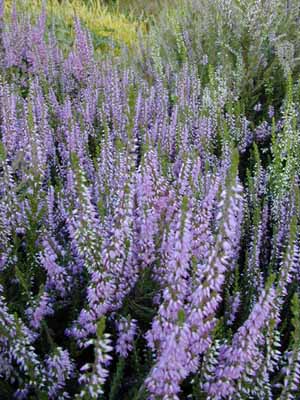
Calluna vulgaris 'Spring Torch'
Heather
This heather is one of the best for a stunning colorful spring show. The dark green stems erupt with glowing red, orange new growth that fades to a brilliant primrose yellow. Gradually this bright spring color will deepen to a rich dark green in early summer. In late summer pale lavender spires of flowers cover the upright mounding plant.
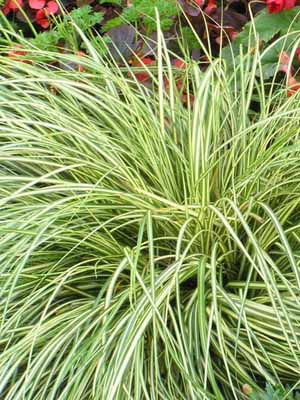
Carex 'Evergold'
Japanese Sedge
Brightly variegated foliage in yellow and green of Carex Evergold features a tight fountain-like habit, even in the shade. Try planting with Astilbe and Fern to provide a contrast in textures. Maintains a good appearance in summer and winter.
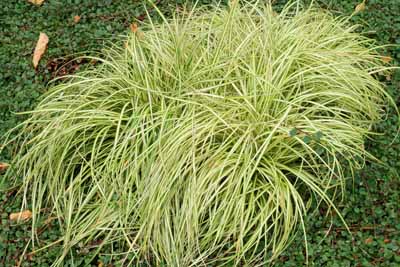
Carex morrowii 'Evergold'
Evergold Carex
Butter-yellow-striped leaves with dark green-edges remain attractive throughout the season. Forms a low tufted mound, perfect at pond's edge, in dappled shade borders or as a container accent. Evergreen in mild winter areas.

Carex oshimensis 'Evercolor Everillo'
Japanese Sedge
Award winning variety whose chartreuse foliage turns to gold as it matures forming a stunning, arching display.

Carex oshimensis 'Evercolor Everlime'
Japanese Sedge
Gracefully flowing, glossy green blades are flanked by lime green margins. Fine-textured foliage maintains a neat habit, the perfect accent for container plantings and living walls.

Caryopteris 'Beyond Midnight'
Bluebeard
Dark and dreamy! You'll love this new caryopteris - it has extremely dark, glossy foliage, a compact habit, and deep blue flowers. It adds much-needed color to the late summer landscape and makes a handsome companion with perennials. A great favorite with pollinators of all types! Long blooming, heat and drought tolerant.

Caryopteris x clandonensis 'Dark Knight'
Dark Knight Caryopteris
A compact, mounding shrub with dense, fragrant, silver-gray foliage and deep purplish blue flowers.Valued for late summer to fall flowers, when little else is in bloom. Use en masse to create a wonderful border for perennial beds, or along walks and entryways
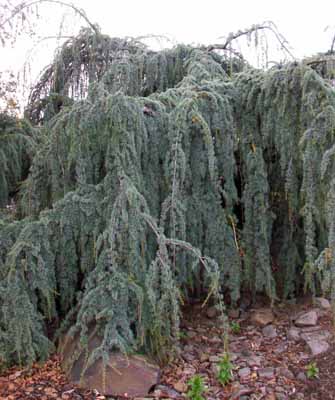
Cedrus atlantica 'Glauca Pendula'
Weeping Blue Atlas Cedar
This dramatic, weeping evergreen makes a special addition to any landscape. Superb specimen for minimal-care gardens. Naturally slow-growing pendant branchlets display icy-blue needles, creating a graceful, waterfall-like effect.
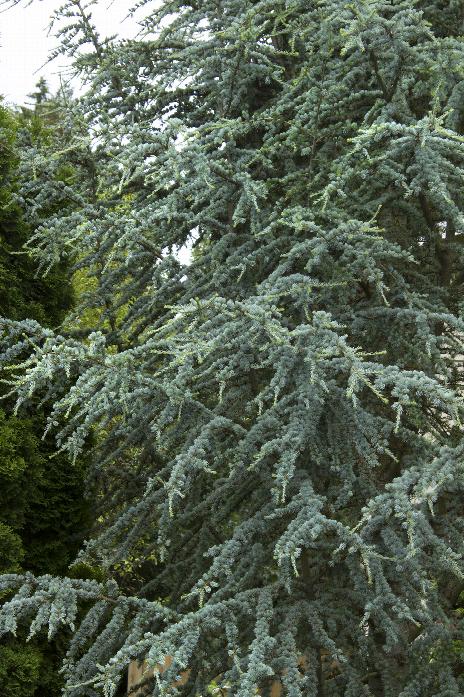
Cedrus atlantica 'Glauca'
Atlas Cedar
A bold, pyramidal form with sparkling silvery blue foliage that drapes from the expansive branches. One of the most popular evergreen conifers. A spectacular specimen for large landscape areas that increases in character as it ages. Drought tolerant, when established.
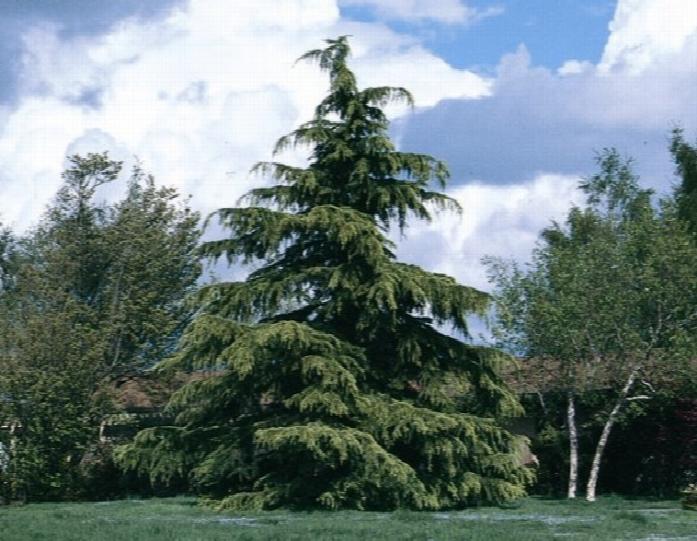
Cedrus deodara
Deodar Cedar
A large, pyramidal form with attractive gray-green foliage and graceful, arching branches. Makes a wonderful living Christmas tree! Allow plenty of room in the landscape to best display this stately tree. Heat and drought tolerant when established. Evergreen.
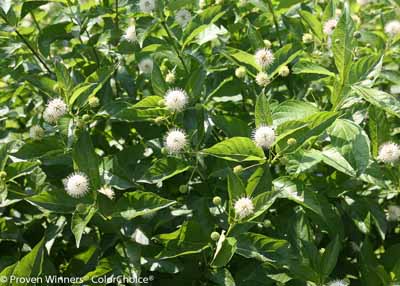
Cephalanthus 'Sugar Shack'
Buttonbush
Native to North America, featuring fragrant white flowers followed by red fruit. Dwarf variety, attracts pollinators.
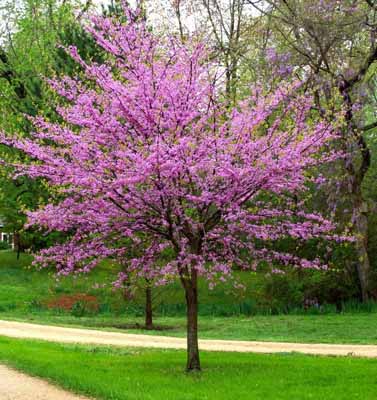
Cercis canadensis
Eastern Redbud
A beautiful garden tree valued for its profusion of rosy pink flowers that cloak the bare branches to bridge the gap between winter and spring! Heart-shaped foliage emerges as the blooms fade and turns yellow in autumn before dropping

Cercis canadensis 'Flame Thrower'
Eastern Redbud
Commonly known as Eastern Redbud, this cercis is full of colors. The leaves emerge reddish burgundy and mature to yellow and green, giving a fabulous, multicolor effect to the foliage. The pink, pea-shaped blooms appear on the stems before the foliage. This is a striking small tree - a must-have if you love color.
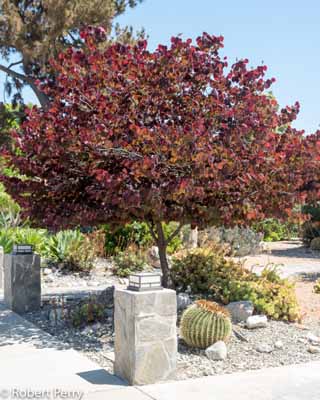
Cercis canadensis 'Forest Pansy'
Forest Pansy Redbud
Beautiful landscape tree valued for its brilliant scarlet-purple color to new foliage, maturing to maroon. Rosy-pink flowers on bare branches bridge the gap between winter and spring! Deciduous.
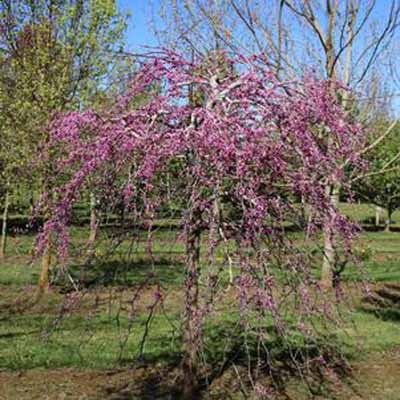
Cercis canadensis 'Pink Heartbreaker'
Redbud
The bloom, like all Cercis, is fantastic with hoardes of small, lavender-pink buds that are held tightly to branches opening in late April before the foliage emerges. Its a unique look that lasts until mid-May when its rounded foliage emerges red before maturing to deep green as summer approaches. Plant 'Pink Heartbreaker' in full sun in a place where it is protected from the harshest of the winter winds.
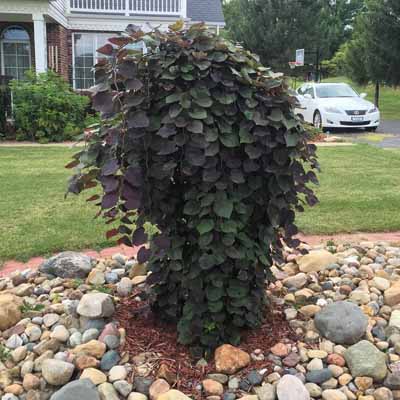
Cercis canadensis 'Ruby Falls'
Ruby Falls Redbud
A lovely compact redbud tree with a weeping canopy that is perfect for a smaller-sized landscape. An excellent specimen plant with clusters of lavender-red, sweet pea-like blooms in spring. Small, semi-glossy, heart-shaped leaves turn yellow in fall.
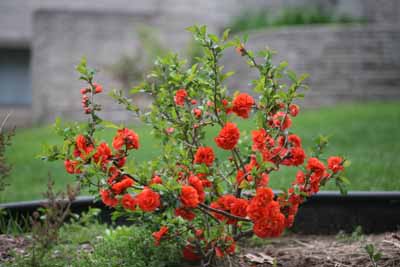
Chaenomeles 'Double Take Orange'
Quince
It's so beautiful you may overlook its survivalist skills! Heat and drought tolerant, this plant will delight you each spring with candy colored blooms. Double Take Orange puts on a spectacular spring display of large double flowers with intense orange color - you'll do a double take! More than just pretty flowers, the Double Take Quinces are easy to care for, having neither thorns or fruit. Once established, they are extremely drought tolerant. Developed by Dr. Tom Ranney and his team at the Mountain Crops Research & Extension Center in beautiful North Carolina, Orange Storm and the other Double Take Quinces are sure to brighten spring gardens across the United States.
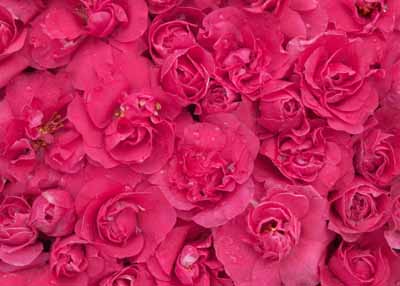
Chaenomeles 'Double Take Pink'
Quince
You'll do a double take when you see this quince that looks like a camellia. Double Take Pink puts on a spectacular early season display of pink blooms. The large, double flowers are excellent in cut flower arrangements. Bright spring flowers are only the beginning of the Double Take quince's appeal: they're also thornless, and do not produce fruit. Extremely drought tolerant once established, these early spring charmers are excellent landscape plants and real survivalists in tough climates. Developed by Dr. Tom Ranney and his team at the Mountain Horticultural Crops Research & Extension Center in beautiful North Carolina, they are sure to brighten spring landscapes across the United States.
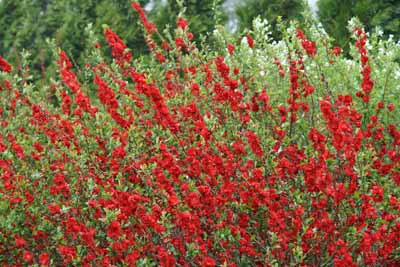
Chaenomeles 'Double Take Scarlet'
Quince
Double Take Scarlet puts on a spectacular early spring display of large red, double flowers. The Double Take quinces are more than just pretty spring flowers: thornless and deer-resistant, they do not produce fruit, and once established, are drought-tolerant survivalists. Developed by Dr. Tom Ranney and his team at the Mountain Horticultural Crops Research & Extension Center in beautiful North Carolina, the Double Take quinces are sure to brighten spring landscapes across the United States.
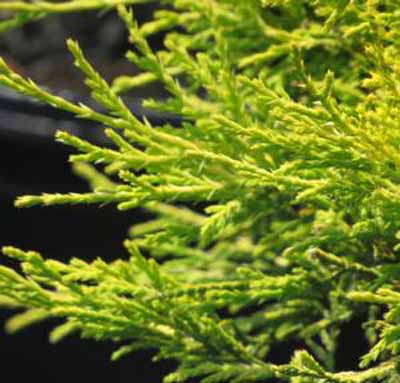
Chamaecyparis 'Gold Thread'
Gold Thread False Cypress
A compact conifer with interesting, thread-like needles that weep and drape over the entire shrub. Bright, golden yellow new foliage, even in full sun. An excellent semi-erect, mop-headed landscape specimen or accent plant that makes a nice background border or small hedge. Slow growing; size can be maintained with minimal pruning. Evergreen.
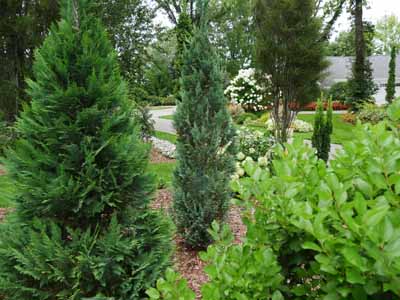
Chamaecyparis lawsoniana 'Pinpoint Blue'
False Cypress
One look at Pinpoint Blue false cypress is all it takes to fall in love with its lush color and soft, feathery texture. It's a fantastic accent for any place in your landscape, but is particularly striking as a specimen. You'll love the way its unique color looks with your home - especially with tricky-to-match red or orange brick! Pinpoint Blue false cypress naturally grows as a narrow column, so it takes up little space in the landscape. A memorable choice for planting on either side of your front door!
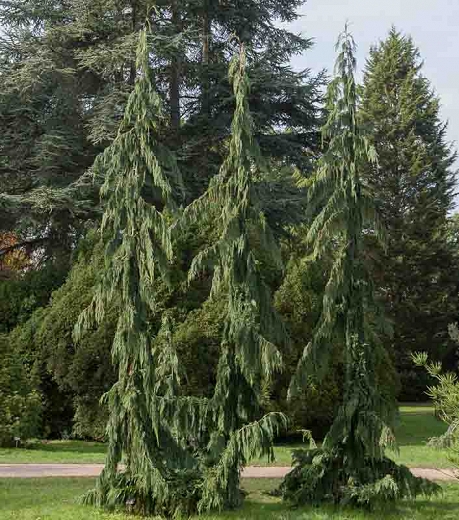
Chamaecyparis nootkatensis 'Green Arrow'
Weeping Alaskan Cedar
Extremely narrow growth habit makes a vertical statement in the garden. Fast growing selection has weeping branches that hang closely to the truck.
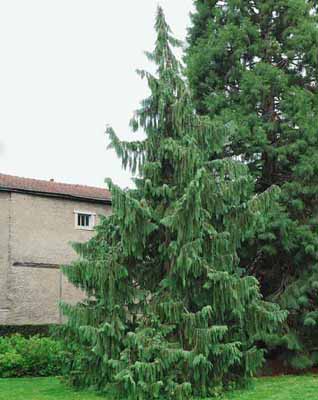
Chamaecyparis nootkatensis 'Pendula'
Weeping Alaskan Cedar
Deep green - blue foliage and a stately, cascading, weeping form make this plant an ideal specimen in the landscape. Rapid growth and low maintenance make this adaptable tree and increasingly popular selection.
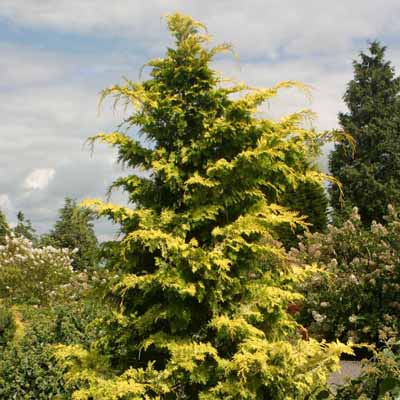
Chamaecyparis obtusa 'Crippsii'
Hinoki, False Cypress
Distinctive bright golden yellow fern - like foliage all year grace this small tree. Wide growing when young, it becomes conical when older. Best in combination with darker foliaged evergreens. Requires full sun for brightest color.
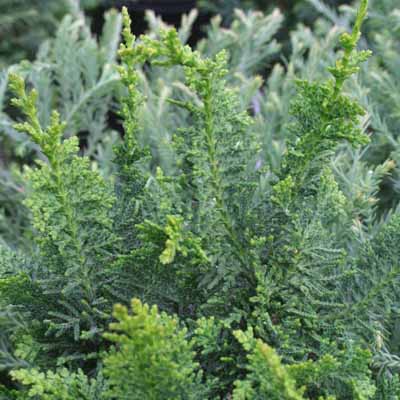
Chamaecyparis obtusa 'Filicoides'
Hinoki, False Cypress
A wonderful specimen with moss green, almost stringy, strikingly different foliage gets a bronzed cast in winter. Slightly curved orange - stemmed branches form an almost contorted figure as it grows. Moderately growing, in upright, semi conical shape.

Chamaecyparis obtusa 'Golden Whorl'
False Cypress
This unusual selection resembles a dwarf form of C. o. Torulosa but in bright gold. It is an intermediate-growing shrub with long contorted foliage tipped with fasciations. An absolute must for the conifer garden. Useful in the rock garden, shrub border or as an accent plant.
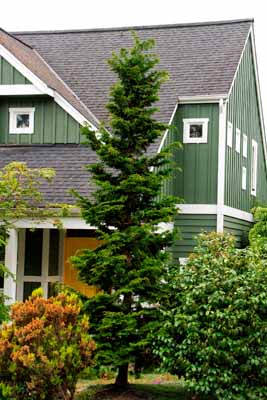
Chamaecyparis obtusa 'Gracilis'
Compact Hinoki Cypress
Deep green, fan - shaped foliage and winning pyramidal form make this dependable evergreen a perfect plant for a small specimen or grouping to form a border hedge. Textured foliage gives a touchable look and this selection is easy to grow and tolerant of most part to full sun locations.

Chamaecyparis obtusa 'Nana gracillis'
Minature Hinoki False Cypress
Very attractive selection of Hinoki cypress that has stood the test of time for well over a century. Typical rate of growth in most areas is 3 to 6 inches

Chamaecyparis obtusa 'Nana Lutea'
Hinoki False Cypress
This dwarf evergreen conifer feaures golden yellow fan-like foliage and an irregularly globe-shaped, upright habit. Excellent for use in rock gardens, beds or borders to bring a unique look to the landscape.

Chamaecyparis obtusa 'Split Rock'
Hinoki False Cypress
Split Rock' is a broadly conical small tree form of Hinoki cypress with dense structure and very Blue foliage that grows as a combination of mature and juvenile type. After 10 years of growth, a mature specimen will measure 4 feet (1.3 m) tall and 3 feet (1 m) wide, an annual growth rate of 4 to 5 inches (10 - 12.5 cm). It makes for an interesting subject for a mixed conifer border in sun or partial shade.

Chamaecyparis obtusa 'Torulosa'
Twisted False Cypress
This pyramidal, upright tree distinguishes itself from the pack with its deep green, fanlike foliage that twists and turns to give it a signature look that is hard to match. Adding to the texture even more are the little cockscombs of foliage that form on new growth. 'Torulosa' is easy to grow in any sunny to partly sunny location.
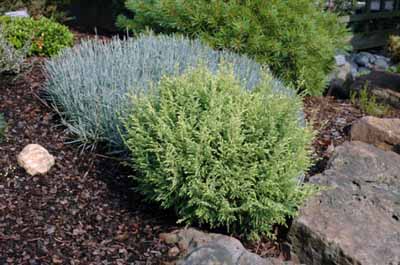
Chamaecyparis pisifera 'Cream Ball'
Sawara Cypress
Chamaecyparis pisifera 'Cream Ball' is a compact dwarf, globose selection of Sawara cypress with cream-colored, and finely textured semi-juvenile foliage. It grows in the form of a very tight ball when young and is sometimes vulnerable to sun scald. It is a great choice for Rock gardens and troughs. After 10 years of growth, a mature specimen will measure 18 inches tall and 2 feet wide, an annual growth rate of less than 2 inches.
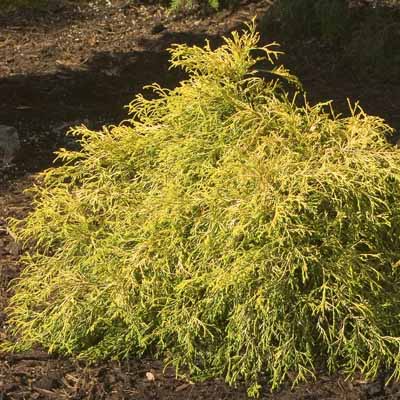
Chamaecyparis pisifera 'Gold Mop'
Sawara Cypress
Gold Mop Sawara cypress is a popular evergreen with a relatively low, semi-weeping habit. Thread-like yellow foliage covers the thin pendulous stems, creating memorable texture. Holds its golden yellow color well when sited in full sun.
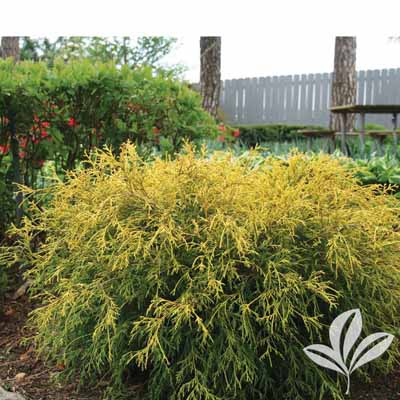
Chamaecyparis pisifera 'King's Gold'
Threadleaf False Cypress
King's Gold Falsecypress is a compact, mounding, dwarf, threadleaf variety with golden yellow foliage. Matures at 3 to 5 feet tall with an equal spread. Excellent choice for mass plantings.

Chamaecyparis pisifera 'Soft Serve Gold'
Gold False Cypress
Soft Serve Gold false cypress is the perfect plant for adding year-round color to your landscape. It naturally grows as a dense pyramid so is especially nice for planting near your front door or any place you'd like a formal accent. Easily grown in sun or shade for maximum versatility.
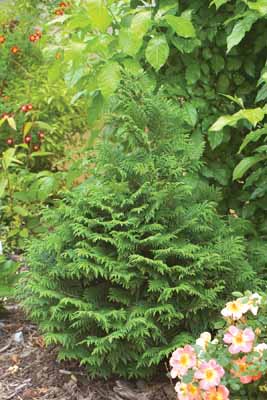
Chamaecyparis pisifera 'Soft Serve'
False Cypress
You'll want to reach out and touch this compact, conical, slow growing evergreen with its dense yet graceful foliage and soft, fernlike branching. The foliage is bright green on top and flecked with silver - blue on the underside. It requires little pruning and thrives in full sun to partial shade. It prefers moist well - drained soil and some protection from winter winds to look its best.
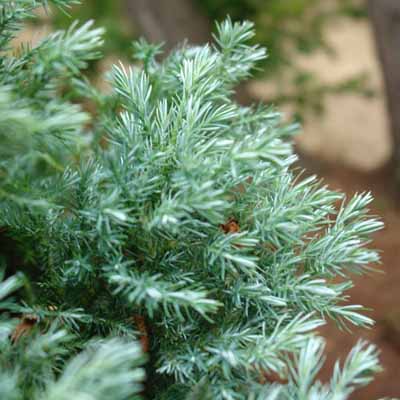
Chamaecyparis pisifera 'True Blue'
True Blue False Cypress
This dense growing pyramidal shrub provides sweet texture and foliage color as blue needles provide year round color and 'fluffy' look that is one of a kind in the garden! Dense rounded, slow growing form is ideal in rock gardens, foundation plantings under windows, banks, slopes or large scale groundcover. Easy to grow. Great foliage color and texture.

Chamaecyparis pisifera 'Vintage Gold'
Vintage Gold Cypress
You'll be dazzled by both the amazing golden color of this plant and its fabulous form. It has a dense rounded form that is easy to use in any half to full sun area. It will brighten up any area with its striking gold fernlike foliage that keeps its blazing color throughout the summer.

Chamaecyparis pisifera filifera 'Aurea'
Gold Mop Cypress
This variety of this popular plant is stunning with year - round yellow color that stands up to the summer sun without scalding. Combine this with its slow growth and tight habit, and it's obvious why this plant is in such demand.

Chamaecyparis thyoides 'Top Point'
Dwarf White Cedar
A superior compact selection with interesting texture and a narrow habit, this upright conifer displays two types of foliage, both needle - like and scale - like. Muted green in summer, the versatile tree takes on a rich purple blush in winter. It's an easy keeper that tolerates winds, partial shade, and moist to wet soils on top of being a Native.
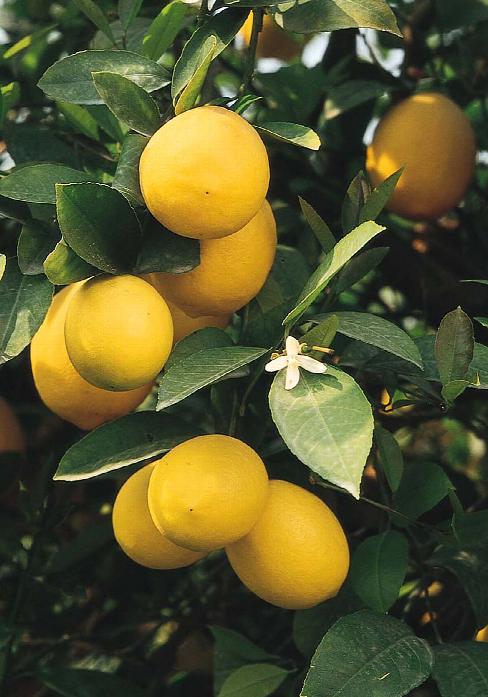
Citurs limon 'Meyer'
Lemon
Excellent foliage is displayed on this medium to large shrub or small tree. Fragrant flowers produce thin skinned, juicy lemons year round. Makes an attractive accent. Protect from frost. Evergreen. Handsome foliage, fragrant flowers and year-round fruit make this an all-round excellent plant for container or tropical bed close to the patio. It can be grown indoors in the sun or taken in during winter in colder climates.

Clethra alnifolia 'Ruby Spice'
Summersweet
Summersweet is a carefree shrub with glossy, deep - green leaves that turn vibrant yellow in fall. 'Ruby Spice' has bottlebrush - like clusters of tiny, fragrant, bell - shaped, reddish - pink flowers that appear in late summer, making this shade - loving native shrub a must have.
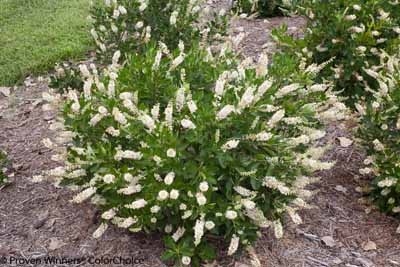
Clethra alnifolia 'Vanilla Spice'
Summersweet
A delightful deer resistant native plant that attracts butterflies and hummingbirds. The attractive, glossy dark green leaves set off the pure white summer flowers. Selected for its extra large flowers - individual florets can be 4 - 6 long - they will open in early July and draw you in with their sweet, spicy fragrance Plant in a shady location for a shot of late season color.
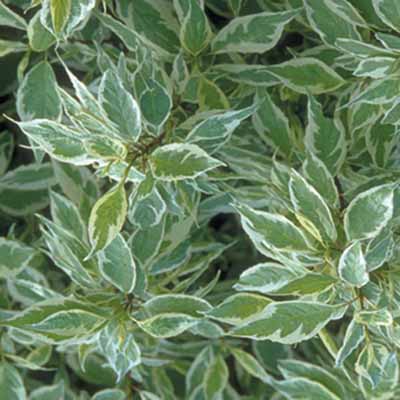
Cornus alba 'Ivory Halo'
Red Twig Dogwood
A more compact form of shrubby dogwood, this selection has beautiful cream - edged variegated foliage and bright red erect unbranched stems that really enhance the winter landscape. Flowers give way to clusters of blue - white drupes in summer. Fruit is quite attractive to birds. Prune in spring for best stem color.
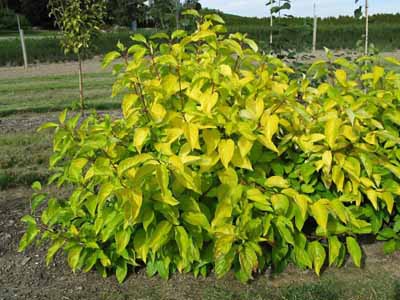
Cornus alba 'Neon Burst'
Red Twig Dogwood
Attractive chartreuse leaves keep their color in the sun and through the heat of the summer. New leaves are tinged with bronze and the stems have a rich red hue early in the season. In the fall, foliage becomes a rainbow of purple, red, yellow and orange with stems turning glossy scarlet red in the winter. Beautiful, compact habit.
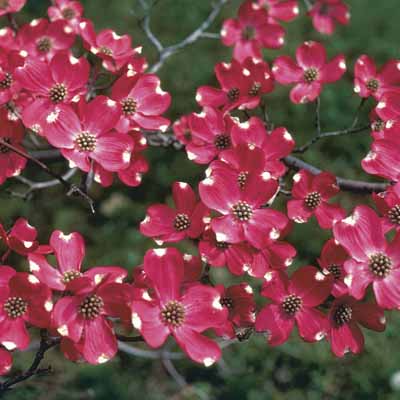
Cornus florida 'Cherokee Brave'
Dogwood
This specimen brings four season interest to your landscape. In spring, you ll watch this king of ornamental trees blanket itself in coral-pink to white flowers, Summer brings lush green foliage, deep red foliage in fall,then glossy red fruit in winter.
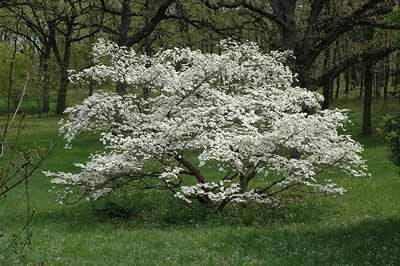
Cornus florida 'Cherokee Princess'
Dogwood
Cherokee Princess Flowering Dogwood features showy clusters of white flowers with white bracts held atop the branches in mid spring. It has forest green foliage which emerges burgundy in spring. The pointy leaves turn an outstanding brick red in the fall. It produces red berries from early to late fall. The warty gray bark adds an interesting dimension to the landscape.
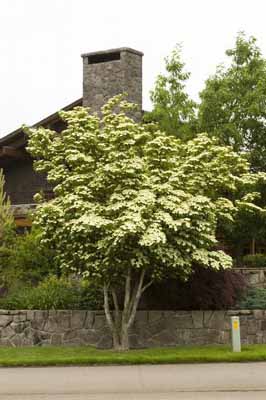
Cornus kousa chinensis
Kousa Dogwood
Attractive horizontal tiers of branches help make this small deciduous tree popular. Splendid white bracts followed in fall by hanging red fruit. Autumn leaves have red-scarlet tints. Special accent.
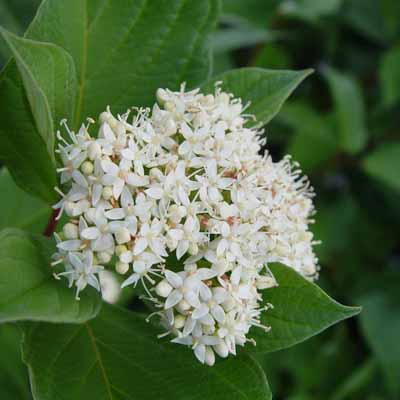
Cornus sericea 'Baileyi'
Red Twig Dogwood
A beacon in the winter landscape with its bright red stems, this selection is easy to grow and tolerant of poor soils, wet areas and the coldest climates. Great for massing, this selection has good red - purple fall color, and should be trimmed yearly for the best winter color.
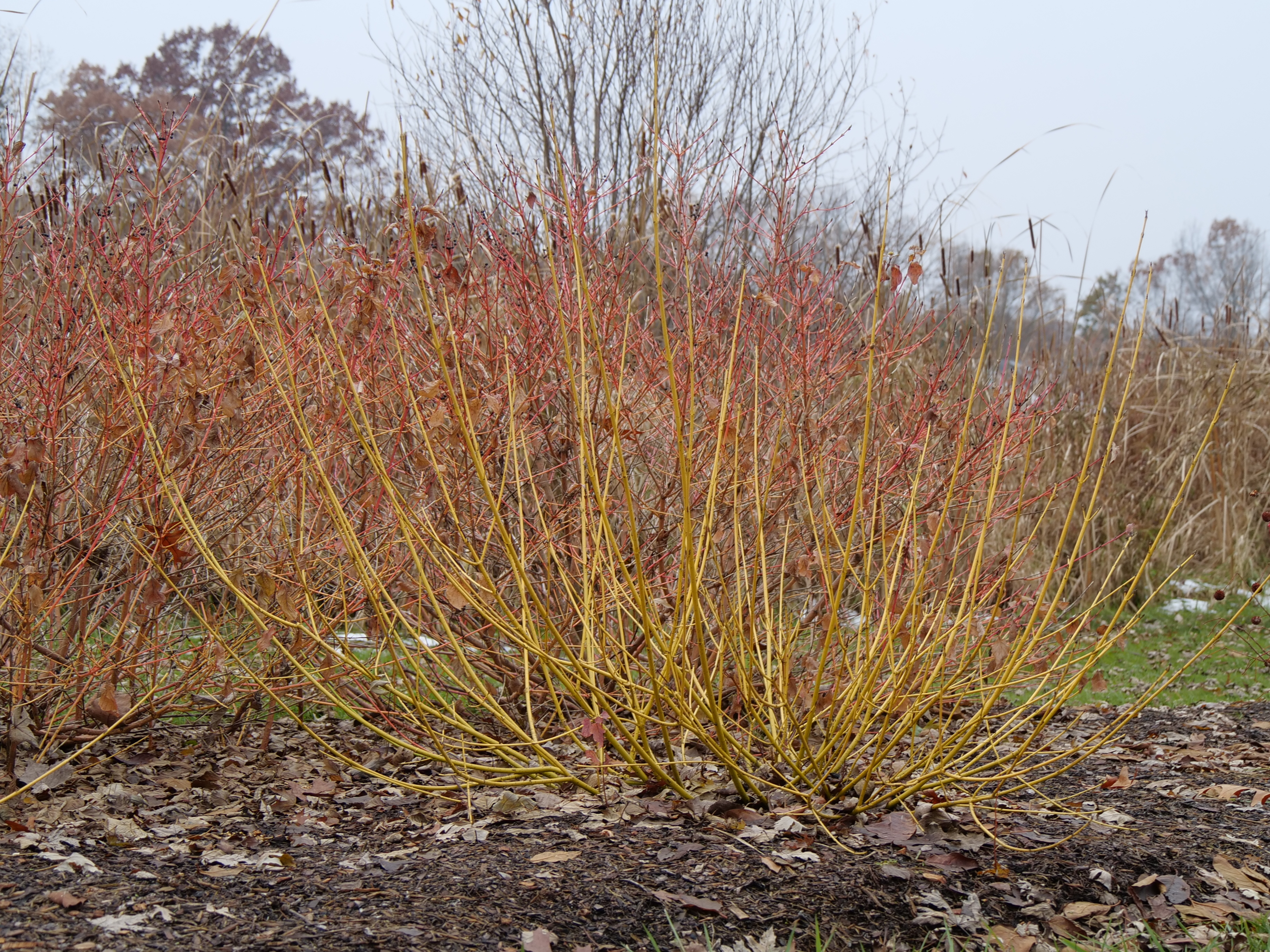
Cornus stolonifera 'Arctic Fire Yellow'
Red Twig Dogwood
A ray of winter sunshine for your landscape! Arctic Fire Yellow dogwood offers the same legendary durability as red-twig dogwood, but brings a cheerful yellow option. Stunning on its own, or planted with Arctic Fire Red dogwood, it also brings a nice option for cutting for winter and holiday arrangements. Native to North America. Top reasons to grow Arctic Fire Yellow dogwood:- one of the most shade-tolerant ornamental shrubs- Tolerant of a wide range of soil conditions- Bright yellow stems in winter add color to the landscape. Produces berries. Deer resistant. The best yellow color appears on one and two year old stems; older stems will turn corky and brown. To maintain a colorful display, you can do one of two things: one, cut the whole plant back to short stubs every other year. Two, cut out one-third of the oldest stems every year. This option is recommended if you planted your Arctic Fire dogwood to provide coverage. Early spring is the best time to prune.

Cornus stolonifera 'Arctic Fire'
Red Twig Dogwood
More compact and dense than 'Baileyi', this Dogwood will find a home in the smaller landscape. This selection gives up about half of 'Baileyi's' size but none of the fantastic, bright fiery red winter stem color. This plant is perfect for smaller spaces. The best red color appears on one and two year old stems; older stems will turn corky and brown. To maintain a colorful display, you can do one of two things: one, cut the whole plant back to short stubs every other year. Two, cut out one-third of the oldest stems every year. This option is recommended if you planted your Arctic Fire dogwood to provide coverage. Early spring is the best time to prune.
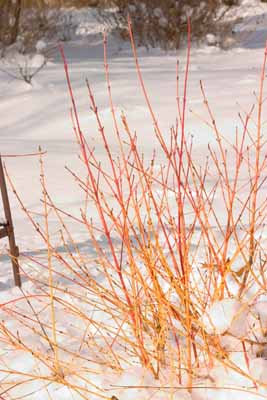
Cornus stolonifera 'Arctic Sun'
Red Twig Dogwood
Keep your landscape lively even in winter with the glorious yellow, orange, and coral stems of Arctic Sun dogwood. It performs like the familiar red-twig dogwoods but with unique color that positively glows in the landscape. Tolerant of a very wide range of soil conditions and one of the best ornamental shrubs for shade, Arctic Sun dogwood is an easy choice for nearly effortless color. The best color appears on one and two year old stems; older stems will turn corky and brown. To maintain a colorful display, you can do one of two things: one, cut the whole plant back to short stubs every other year. Two, cut out one-third of the oldest stems every year. This option is recommended if you planted your Arctic Sun dogwood to provide coverage. Early spring is the best time to prune.

Cotinus 'Velveteeny'
Smokebush
Velveteeny offers the same silky smooth, deep burgundy foliage with large feathery plumes of dove gray to pink blooms as it's big brother 'Royal Purple', but in a petit, dwarf form. Maturing at a mere 4', 'Velveteeny' is as versatile as it is exquisite, with its compact, rounded shape and brilliant color a dazzling addition to any sunny landscape.
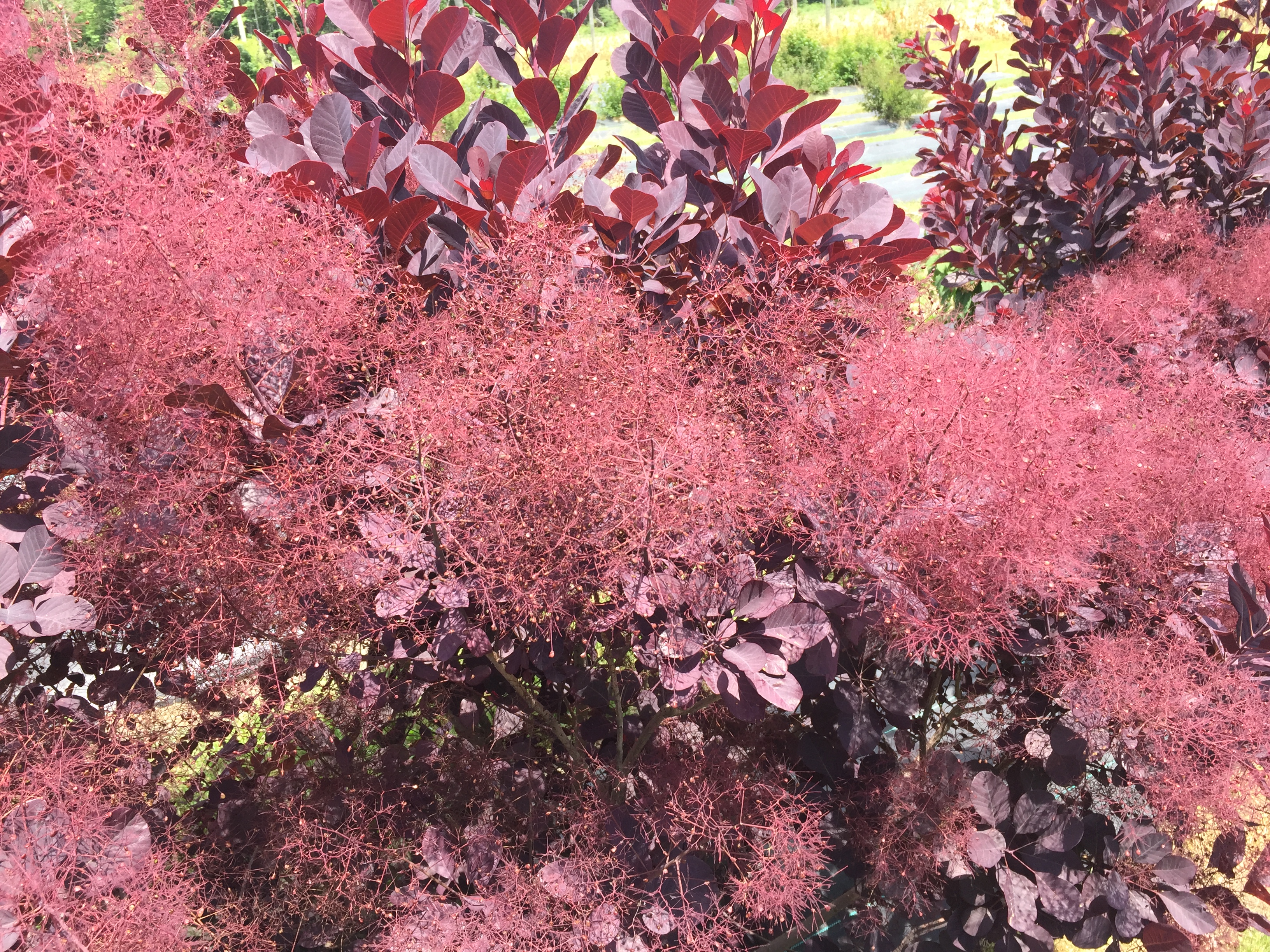
Cotinus 'Winecraft Black'
Smokebush
A feast for the eyes from spring through autumn! Winecraft Black is the first Proven Winners smokebush, so you know it must be special. In spring, round leaves emerge rich purple but as summer's heat comes on, they turn a deep near-black tone and finally light up in an array of reds and oranges in fall. In early summer, large, soft panicles of bloom appear that become the misty "smoke" that makes this such a popular landscape plant. Unlike other smokebush, it naturally has a rounded, dwarf habit which means that finally, every landscape has room for this unique plant. Winecraft Black smokebush is very easy to care for and requires little to nothing in the way of regular maintenance. Plant in full sun for best color and flowering. Pruning will rarely be required but may be done in spring. Deer and rabbit resistant.
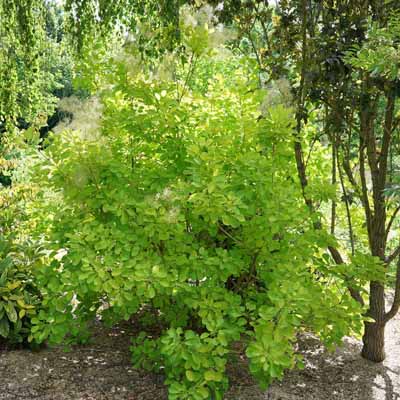
Cotinus 'Winecraft Gold'
Smokebush
Bold, bright, and beautiful: that's Winecraft Gold smokebush. Round, waxy leaves emerge a sunny orange, soon take on a golden hue, then mature to a cheerful chartreuse for the season. In early summer, cloud-like green flower clusters cover the plant, and these turn into the pink "smoke" plumes that earn the plant its name. Naturally grows with a dense, oval shape that's ideal for adding a spot of bright color to partially shaded or sunny areas. Smaller and more dense than conventional smokebush.
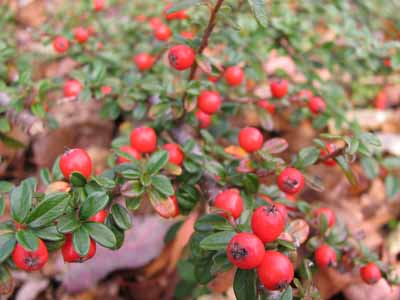
Cotoneaster dammeri 'Coral Beauty'
Cotoneaster
An outstanding groundcover with dense prostrate branches covered with shiny green, finely textured foliage. White blooms in spring are later followed with highly ornamental berries.Evergreen.
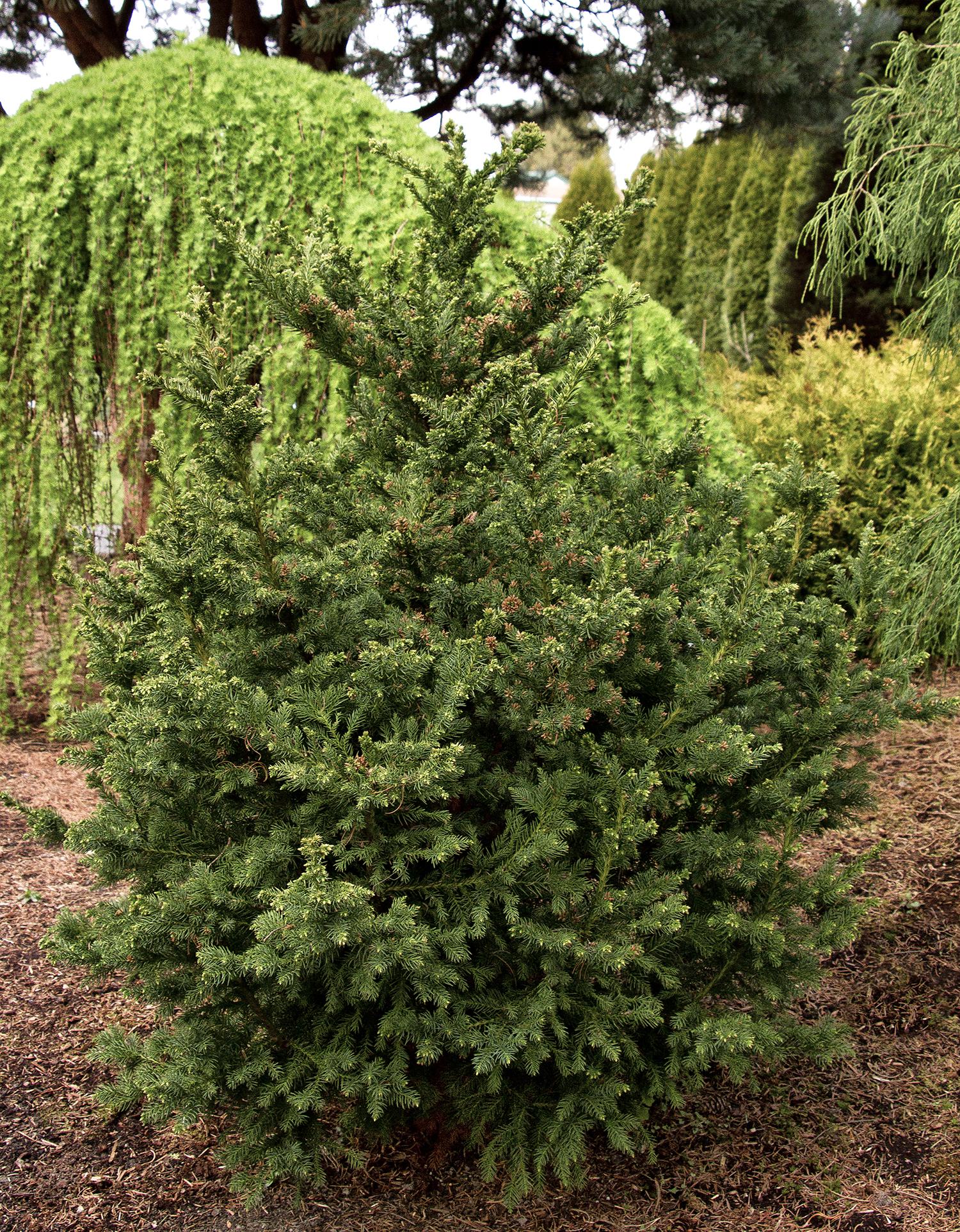
Cryptomeria japonica 'Black Dragon'
Japanese Cedar
Light green spring growth matures to deep black-green in summer and forms a dense, irregular pyramid. An interesting evergreen specimen suitable for a wide range of landscape styles including Asian and formal English gardens. Works well as a small, highly textural tree in smaller spaces and large container plantings. Slow grower.

Cytisus 'Allgold'
Scotch Broom
Lovely, long sprays of pea-like flowers make this an excellent choice for mass plantings. A beautiful specimen as well when singly planted, with a beautiful, rounded habit of dense, green branches with tiny green leaves. A great plant for sunny, dry hillside plantings. Deciduous.

Cytisus 'Sister Disco'
Scotch Broom
Sister Disco Scotch broom is a far-out burst of color for your spring garden. Each pea-shaped bloom is screaming yellow dabbed with bright red. This spring bloomer is especially when paired with colorful spring blooming bulbs like daffodils, tulips, and crocus. Sister Disco Scotch broom loves sunny, dry conditions. After blooming, wiry green stems are covered in tiny leaves, which provide a unique textural effect.

Cytisus 'Sister Rosie'
Scotch Broom
Sister Rosie Scotch broom brings more to your garden: more color, more flowers, more texture! In spring, the plant springs back to life with hundreds of pea-shaped flowers in dusky pink with red and yellow lips. Nothing else looks quite like it, and it is especially when paired with colorful spring blooming bulbs like daffodils, tulips, and crocus. Scotch broom loves sunny, dry conditions, which these bulbs also like, so pairing them together works visually as well as horticulturally! After blooming, wiry green stems are covered in tiny leaves, which provide a unique textural effect.

Cytisus scoparius 'Burkwoodii'
Scotchbroom
A plant that stands out in the landscape due to its unique angled crayon green stems and its tremendous display of garnet - red flowers in mid - May. The blooms of 'Burkwoodii' begin bright red and then darken to maroon and purple - burgundy. Prune after flowering for best flowering results next year.

Cytisus scoparius 'Lena'
Scotchbroom
The maroon buds of 'Lena' open to dazzling lemony - yellow to orange flowers in late May to June over wispy, grass - like foliage. This variety is slightly more compact than its counterparts, but still has the same unique angled stems and a need for well drained soil.
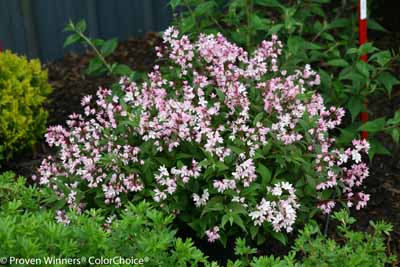
Deutzia 'Yuki Cherry Blossom'
Deutzia
Perfectly pretty pink flowers on a deutzia. A shower of elegant pink flowers creates a carpet of color. Great for mass plantings because of its neat, mounded habit and burgundy-purple fall color, this tough, adaptable plant makes an excellent groundcover, especially on a sunny slope. Deer resistant.
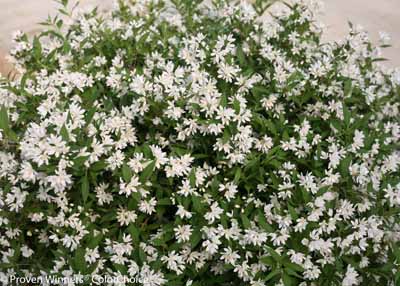
Deutzia 'Yuki Snowflake'
Deutzia
If you like 'Nikko', you'll love this extra-heavy blooming variety. Elegant white spring flowers appear at the perfect time for spring gardens, and its neat, mounded habit and attractive fall color make it a great landscape plant, too. Deer resistant.
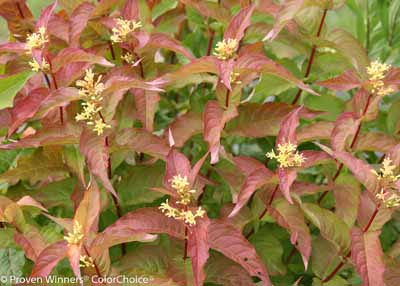
Diervilla 'Kodiak Orange'
Bush Honeysuckle
Looking for a durable native plant that will thrive in sun or shade, and is drought-tolerant? Deer-resistant, too? You've got it! This shrub pushes fall color to the limits with its glowing orange fall foliage. It lights up the fall landscape, making it an ecofriendly alternative to burning bush. Bright yellow flowers in early summer add to its appeal. A durable native plant that thrives in sun or shade, its is drought-tolerant, deer-resistant, and can even grow in dry shade. This is an excellent landscape plant that will succeed in even challenging sites.
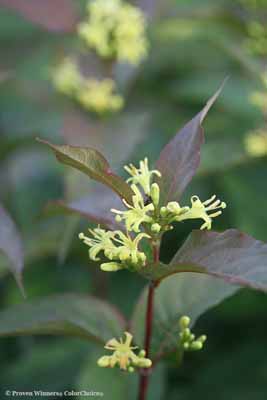
Diervilla 'Kodiak Red'
Bush Honeysuckle
Rugged beauty for the toughest spots in your landscape. Kodiak Red diervilla is a native flowering shrub that looks great while shrugging off shade and problem soils. New growth emerges in spring with a deep burgundy tone, and turns vivid red in fall. During summer, leaves have a red edge and clusters of small yellow flowers appear all season. It's a simple but beautiful way to add low-maintenance color to parts of your yard that have been difficult to landscape. Deer resistant
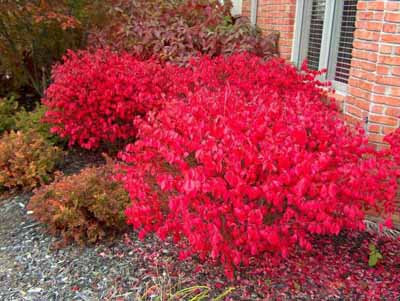
Euonymus alatus 'Compactus'
Dwarf Burning Bush
This shrub is one of the great beauties of the autumn season. It is distinguished by vibrant scarlet foliage and small red - orange fruit in the fall as well as unusual corky "wings" which can flare out along its branches. A versatile, hardy shrub that makes and excellent shrub or hedge.

Euonymus alatus 'Fire Ball'
Burning Bush
Outstanding bright red fall foliage. May be pruned in late winter. Hardier than other varieties. Adaptable. Excellent for landscaping. There are few problems with this shrub. It is low maintenance, has nice bark, and isn't prone to pest problems. However, to maximize the fall red foliage color, the plants should be placed in full sun. Plants placed in areas with too much shade will color up much later in the fall and will often lose their leaves before they have a chance to turn bright red. Tolerant of most soils except extremely wet conditions. pH adaptable. Prefers medium moisture. Deciduous shrub. Fertilize in early spring by applying a slow release fertilizer specialized for trees and shrubs. Follow the label recommended rate of application. Fertilizer will prime the plant to have a good growth flush in spring to its maximum potential. Withstands heavy pruning. Can be done whenever, but best done in late fall.
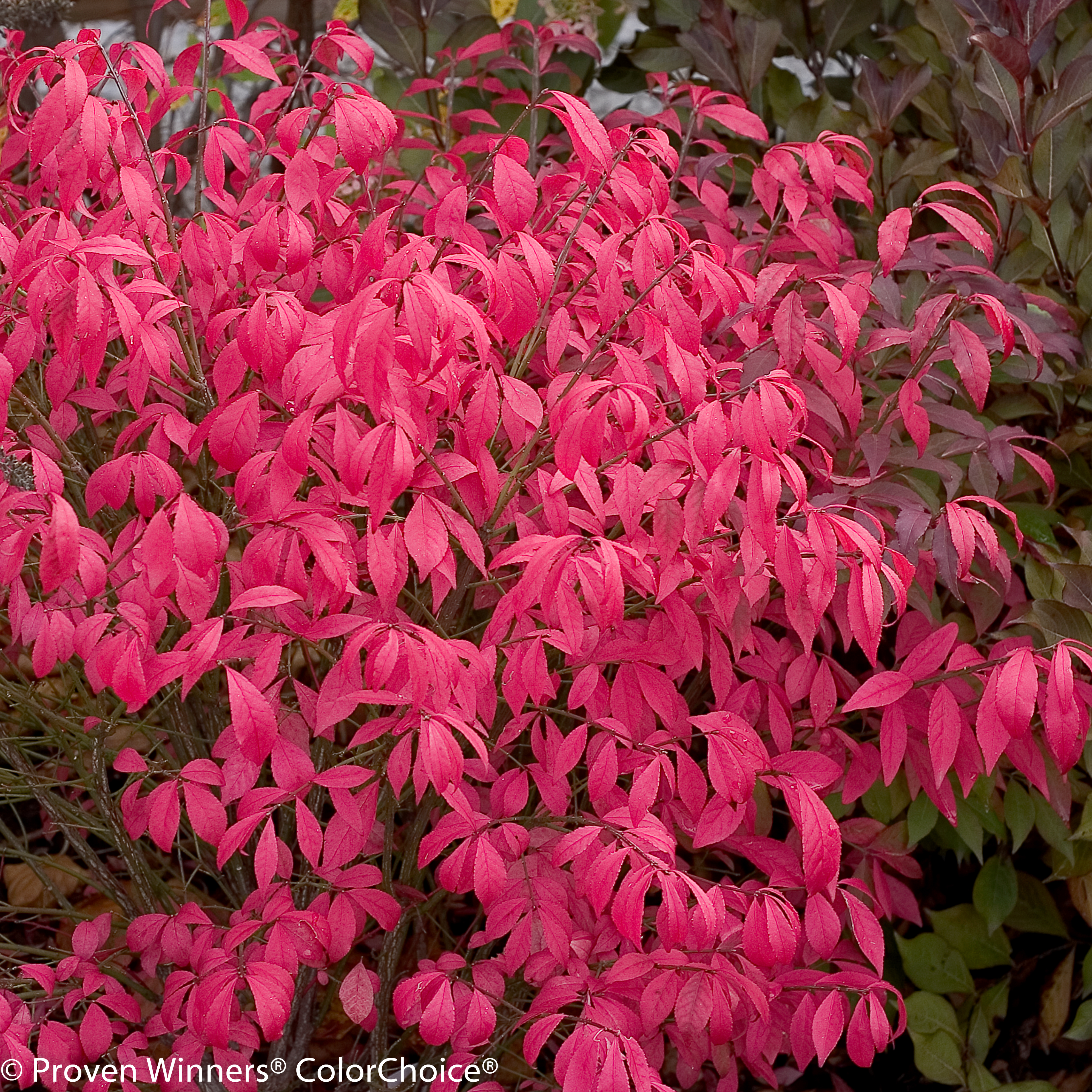
Euonymus alatus 'Unforgettable Fire'
Burning Bush
Unforgettable Fire burning bush differs from conventional types, thanks to its dense, fine branching and smaller leaves. This is a very good choice for residential landscapes. It has outstanding fall color. Developed by Michael Hayman of Louisville KY. Like other burning bush, Unforgettable Fire is low maintenance, has nice bark, and isn't prone to pest problems. To maximize the red fall color, the plants should be placed in full sun. Plants in too much shade will color up later in the fall and may lose their leaves before they turn bright red. Tolerant of most soils except extremely wet ones. pH adaptable. Fertilize in early spring. Tolerates pruning- if pruning to trim or shape, do so in late spring, after the new growth has emerged but before it hardens off. If doing major pruning, late winter is preferable.
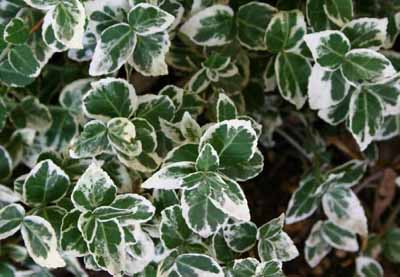
Euonymus fortunei 'Emerald Gaiety'
Wintercreeper
The landscape fun lasts all year long with this playful broadleaved evergreen. Distinct white margins adorn the round, deep green foliage of this Asian transplant giving it more than enough glorious color to make it a focal point in the garden throughout the year, wowing you even more all winter as the white edges turn distinctly pink as the temperatures plummet. Known to be slower growing than the species, this Wintercreeper requires little maintenance and will be a steady climber if given the opportunity to grow up against any structure. Full sun or part shade and any well-drained soil will keep this beauty happy all year long in a multiplicity of uses from specimen to climber to low hedge or border to a group planting, beautifully massed on a slope.
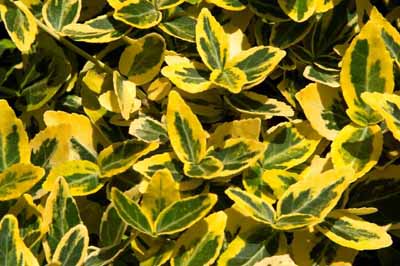
Euonymus fortunei 'Emerald N Gold'
Wintercreeper
This colorful evergreen shrub sports bright green leaves with gold edges, turning pinkish red in fall and winter. Spreads by creeping stems that root where they touch the ground. Dense mounding form makes an excellent small hedge or border plant. Gently climbs with support, making a nice background or foundation planting.

Euonymus fortunei 'Gold Splash'
Wintercreeper
A real improvement in Euonymus! The big, round leaves of this selection have bright, bold variegation. It has far more impact in the landscape than other, older varieties. The variegation is very consistent, and the plant has excellent disease resistance.
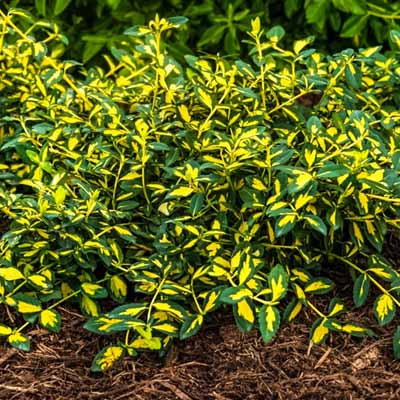
Euonymus fortunei 'Moonshadow'
Wintercreeper
A slow growing cultivar that spreads as it grows and forms a low mound as it matures. Distinctive for its wavy, medium size yellow leaves with narrow dark green margins. Stems turn red, and foliage becomes pink - toned in winter. Tolerant of most soil conditions and light.
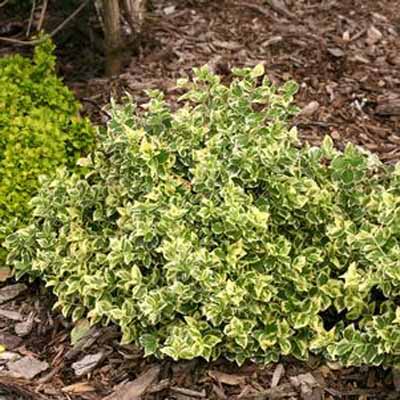
Euonymus fortunei 'White Album'
Wintercreeper
This is a new and improved form of 'Emerald Gaiety' with superior leaf spot resistance and a consistent growing habit. Landscapers and gardeners will appreciate the bright leaves that set it apart from older varieties. The stable variegation has a large, cream-colored border around the perimeter of the large evergreen leaves.
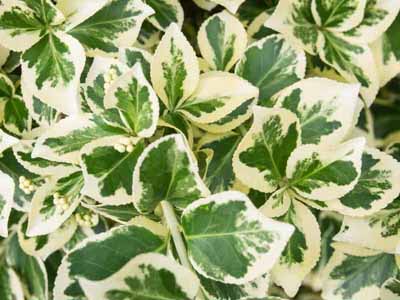
Euonymus japonica 'Silver Queen'
Silver Queen Euonymus
Rounded, metallic green leaves sport a creamy border that provides instant and year round color to the landscape. Aggressive growing, this selection is the perfect, easy to grow foliage color plant. Colorful foliage year round. Easy to grow and maintain. Perfect for foundation use or for grouping to form a colorful hedge
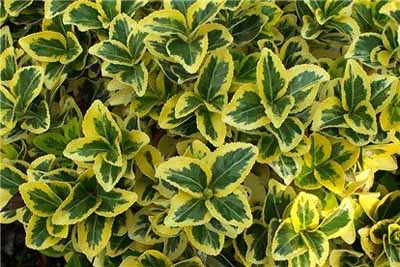
Euonymus japonicus 'Aureo-marginata'
Golden Euonymus
An excellent choice for a colorful hedge, this evergreen shrub displays dense, bold green and gold variegated foliage on an upright growth habit. This tough shrub is adaptable to adverse conditions and tolerates poor, lean soils. Versatile and easy to care for, it requires minimal attention once established, but takes well to regular pruning.
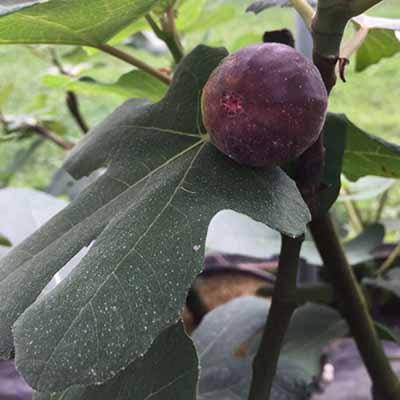
Ficus carica 'Chicago Hardy'
Fig Tree
A hardy edible fig! 'Chicago Hardy' is one of the most cold-resistant figs on the market. Though it may die back to the ground in the colder ends of its range, it resprouts from the roots and will still bear sweet edible figs in autumn. Can grow in warmer parts of USDA zone 5 in protected sites; it should be mulched well in these areas for best results. Site in a protected area and mulch well in colder areas. Loves sunny, dry conditions. Plants can also be grown in pots and stored on the dry side over winter. Figs are ready to harvest when they are soft and sweet.
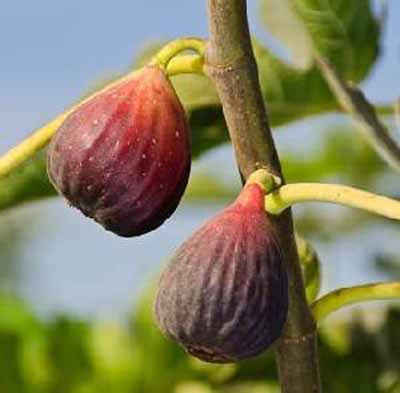
Ficus carica 'Italian Everbearing'
Italian Fig
This ethnic favorite is a staple in many of the yards of Mediterranean immigrants but is found far more rarely growing in other yards. One taste of this sweet fruit will change that! You won't want to miss out on this easy, self-pollinating, everbearing Fig as it produces loads of reddish-brown fruit that are even larger than the old stand by, Brown Turkey Fig, containing juicy, sweet pink flesh that is wonderfully delicious either fresh or dried. This small, rounded tree will be an attractive addition to the landscape along with being oh so dependable in the fruit production department. Colossal 9" lobed leaves add a distinctly tropical flavor to the landscape on this tree that should be grown in full sun and heavily protected, just like your Mediterranean neighbors do, to make sure it makes it through the winter to fruit like crazy next year..
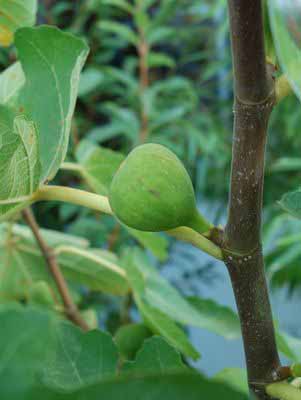
Ficus carica 'Vern's Brown Turkey'
Common Fig
The best Fig available for the northeast, 'Vern's Brown' is the standard for the home garden for good reason! Its year to year reliability is outstanding producing a large crop of sizable, deep brown figs with sweet, seductive amber colored flesh that will have you popping them into your mouth right off the tree. This tasty treat keeps well with refrigeration and is perfect for a container on a deck or anyplace in the ground that you can provide winter protection.

Forsythia 'Show Off Starlet'
Forsythia
Show Off Starlet forsythia is a bright ball of yellow flowers in spring! If your older forsythia takes up too much room and has a weak flower display, try this new, improved variety. It has the same fabulous flower display you get with Show Off forsythia, but in a smaller package. This new dwarf forsythia is a mass of bright yellow spring flowers from base to tip. Prefers a good, loose soil, but is very adaptable. pH adaptable, air pollution tolerant, withstands city conditions. Pruning is seldom needed; if necessary, prune immediately after flowering. Old stems can be cut to the ground. Fertilize in spring.
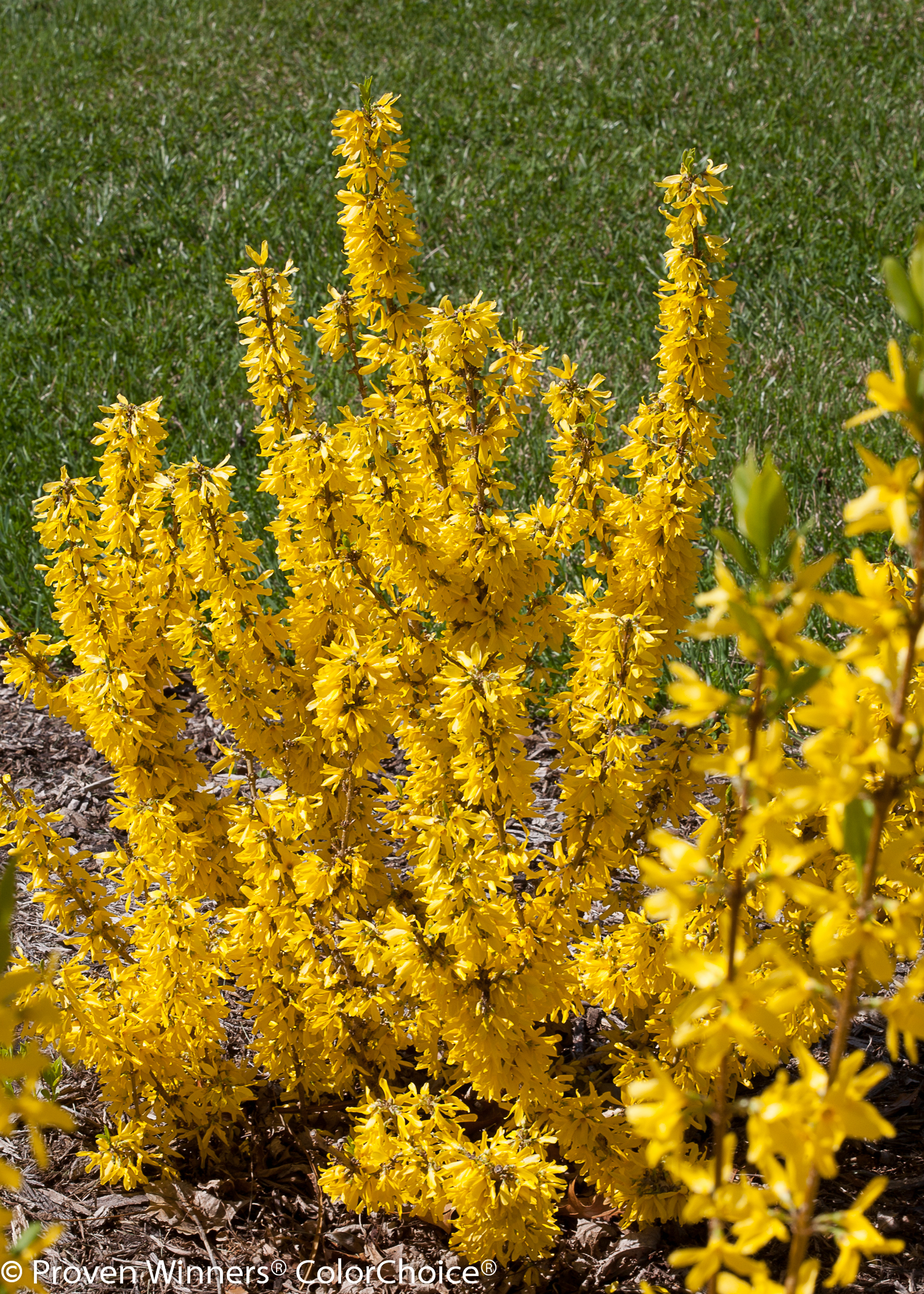
Forsythia 'Sugar Baby'
Forsythia
Bright yellow early spring flowers. Dwarf habit. Outstanding flower display. Deer resistant. Prefers a good, loose soil, but is very adaptable. pH adaptable, air pollution tolerant, withstands city conditions. Does not need heavy pruning. Pruning is best done immediately after flowering. Old stems can be cut to the ground. Fertilize in spring. Great for erosion control.
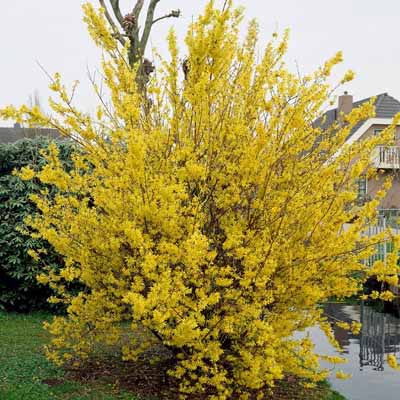
Forsythia intermedia 'Lynwood'
Lynwood Gold Forsythia
Carefree Forsythia Lynwood Gold lights up the spring with its golden yellow blooms. The whole shrub produces an abundance of blooms! When colors fade, dark green foliage forms. Great for privacy and shaping.

Fothergilla 'Mt. Airy'
Fothergilla
Dense and upright with cool, dark, blue-green foliage and an abundant early spring show of stamened, cone-like, white flowers that fill the air with their light fragrance. Superb summer foliage turns a striking yellow-orange-red in the fall. Truly a plant for all seasons!
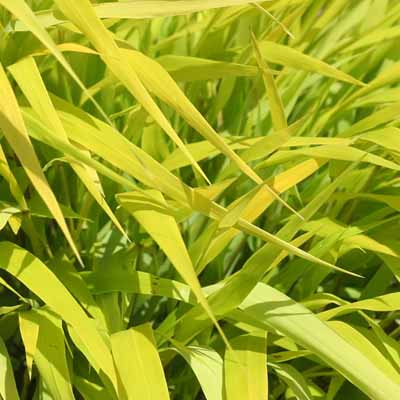
Hakonechloa macra 'All Gold'
Japanese Forest Grass
Graceful arching golden leaves form dense, cascading mound. Deer resistant.
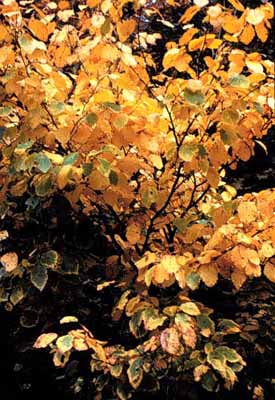
Hamamelis virginiana
Witch Hazel
A large shrub with open branched rounded form. Flowers have ribbon-like petals
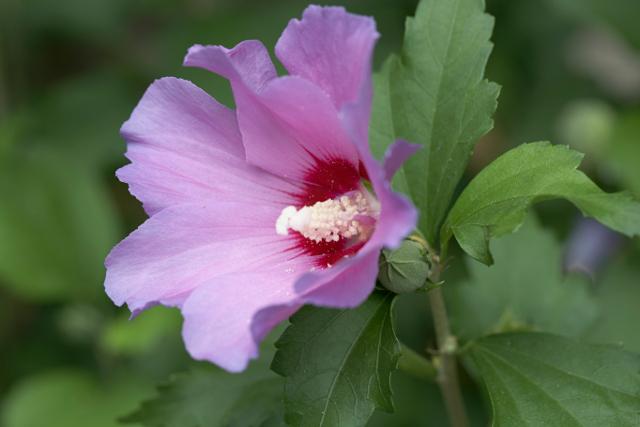
Hibiscus syriacus 'Aphrodite'
Rose of Sharon
An eye-catching deciduous shrub that produces little to no seed, which means an abundance of nearly continuous, exceptional flowers over a long bloom season. The heavily ruffled, clear pink blooms have a deep red eye. The densely branched habit with thick, deep green foliage is perfect for a hedge or screen, and is easily trained as a small tree.

Hibiscus syriacus 'Dark Lavender Chiffon'
Rose of Sharon
The newest member of the incredible CHIFFON rose of Sharon series! Honestly, we just got lucky with this one. It was growing by its parent Lavender CHIFFON and since then it has proved it's out and out a richer color. Gardeners who prefer a luscious, rich colored flower will be happy to see Dark Lavender CHIFFON as a hedge, specimen, or within a border. Long blooming. Heat, drought, salt tolerant. Attracts pollinators. Deer resistant.
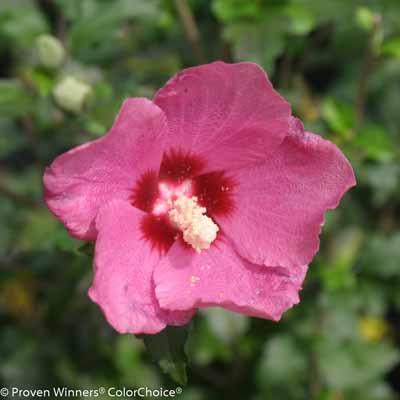
Hibiscus syriacus 'Lil Kim Red'
Rose of Sharon
This newest addition to the Lil' Kim series has a compact habit and rich, deep rosy-red flowers. The unique color looks good with many summer flowering perennials, and is a great choice for container gardens. Deer resistant.
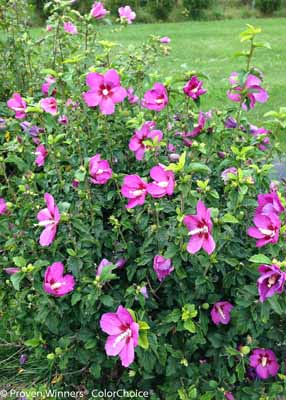
Hibiscus syriacus 'Lil Kim Violet'
Rose of Sharon
This purple form of the dwarf Lil' Kim rose of Sharon is perfect for containers and smaller gardens. It has the same compact habit but with plum-violet flowers accented by a red eye. The large - up to 3" across - flowers are very striking against the dark, glossy foliage and are held up by very strong stems. Deer resistant.
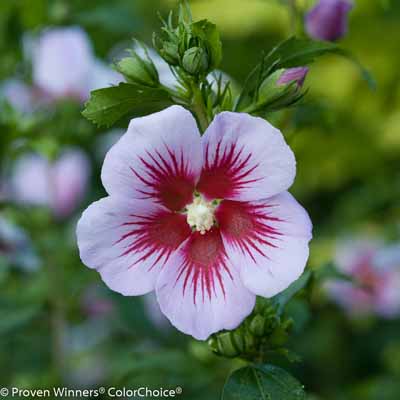
Hibiscus syriacus 'Orchid Satin'
Rose of Sharon
Seedless rose of Sharon means less work and more enjoyment! Exceptionally large pink single blooms are accented by a dramatic red eye. The graceful branches of this non-invasive new variety make it a very appealing addition to the mixed border. Deer resistant.
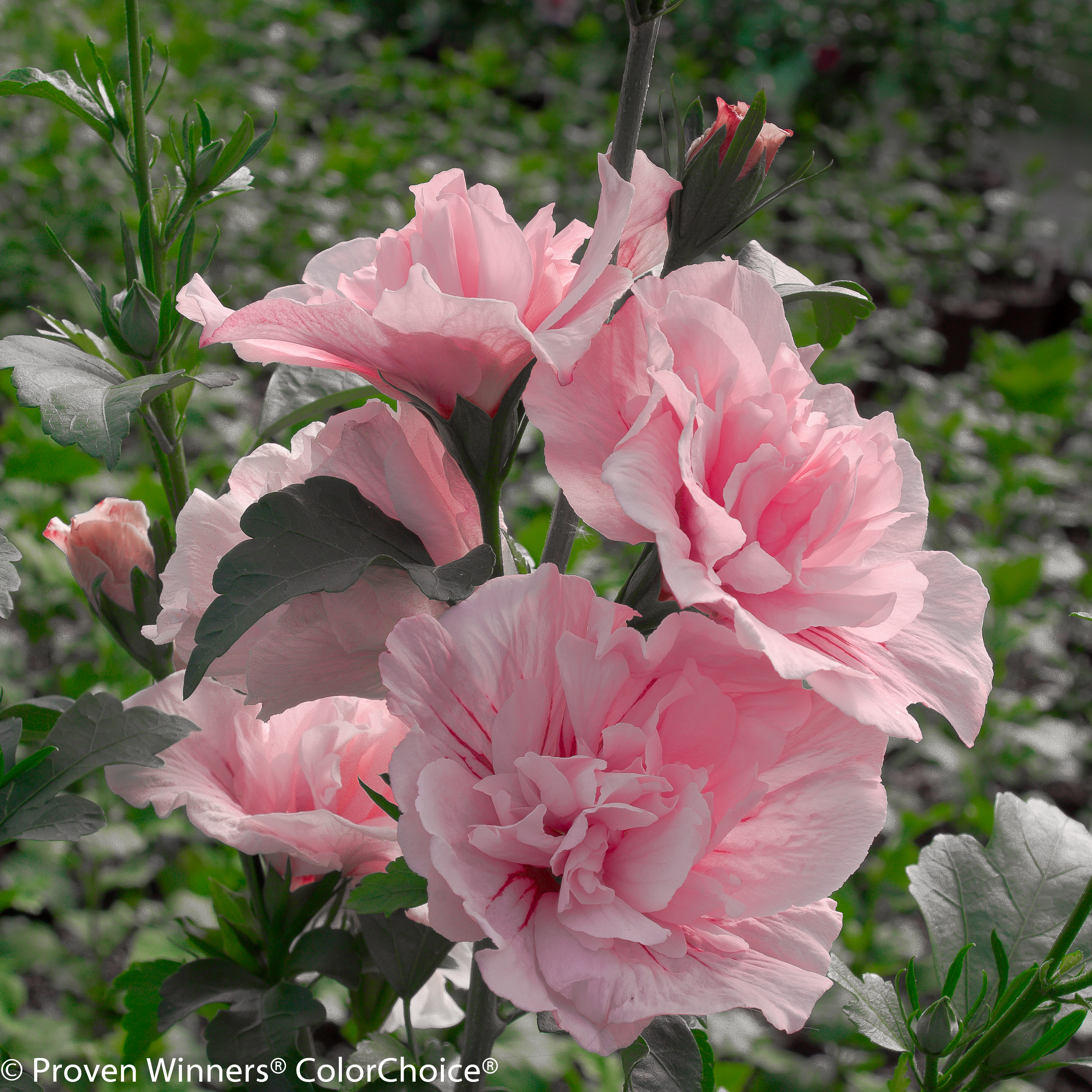
Hibiscus syriacus 'Pink Chiffon'
Rose of Sharon
Unique, clear pink color! This beautiful new rose of Sharon has the same flower power and soft, graceful stems of other Chiffon varieties, but with large, soft pink flowers. You'll fall in love with the distinctive, clear pink blooms. Long blooming. Heat and salt tolerant. Attracts pollinators. Deer resistant.
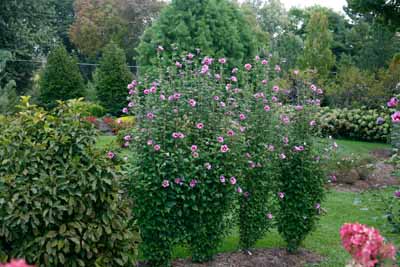
Hibiscus syriacus 'Purple Pillar'
Rose of Sharon
Purple Pillar is a totally unique rose of Sharon: it naturally grows as a narrow column instead of a wide, spreading plant. It gets to be just 2-3' (.6-.9 m) wide and 10-16' tall! Think of what you could do with that: screens, hedges, patio containers. Anywhere you need a little privacy and/or color in a narrow space, this plant is a great choice. Like most all hibiscus, it will do best in full sun. In summer, each stem is packed along its entire length with purple blooms. This unusual columnar habit makes it a real space saver - if you thought you didn't have enough space to grow rose of Sharon, Purple Pillar is perfect for you. Try it in containers, or flanking your front door, or simply as a quirky accent in your landscape.
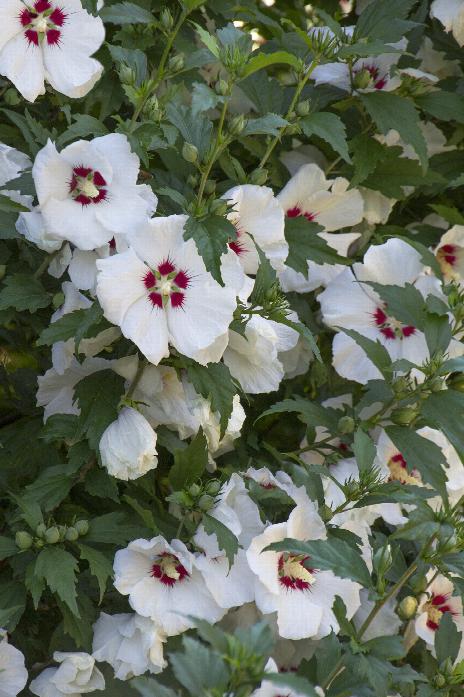
Hibiscus syriacus 'Red Heart'
Rose of Sharon
A delightful flowering deciduous shrub with slender, upright branches and bright green foliage. The outstanding large white flowers with red centers provide a welcome color accent in summer landscapes. A beautiful accent or container specimen. Works well as a foundation plant, hedge, or privacy screen. Tolerates air pollution well.
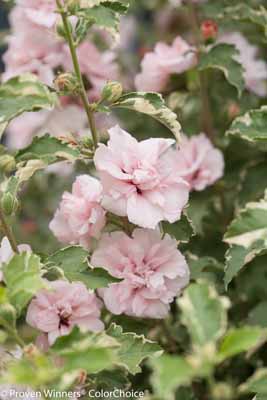
Hibiscus syriacus 'Sugar Tip'
Rose of Sharon
Colorful foliage all season, and fluffy pink blooms in summer! Fabulous and eye-catching from spring to fall, Sugar Tip rose of Sharon offers unique brightly variegated creamy-white and bluish-green foliage. It produces loads of clear pink, double flowers and does not produce seed. This is a beautiful semi-dwarf rose of Sharon that saves space and looks great all summer.

Hibiscus syriacus 'White Chiffon'
Rose of Sharon
Beefy single flowers are adorned with a lacy center to create clouds of anemone - like blooms. Wow! Blooms begin in August through September. Strong growing and long blooming, this plant will draw attention from everyone who sees it.

Hibiscus Syriacus `Lavender Chiffon`
Rose of Sharon
Wow! You're going to love this addition to your landscape.'Lavender Chiffon' sports big, single lavender flowers with lacy, frilly centers from early August through September creating a unique, new look for hibiscus flowers. Strong growing and long bloom time add loads of color to your late season garden.
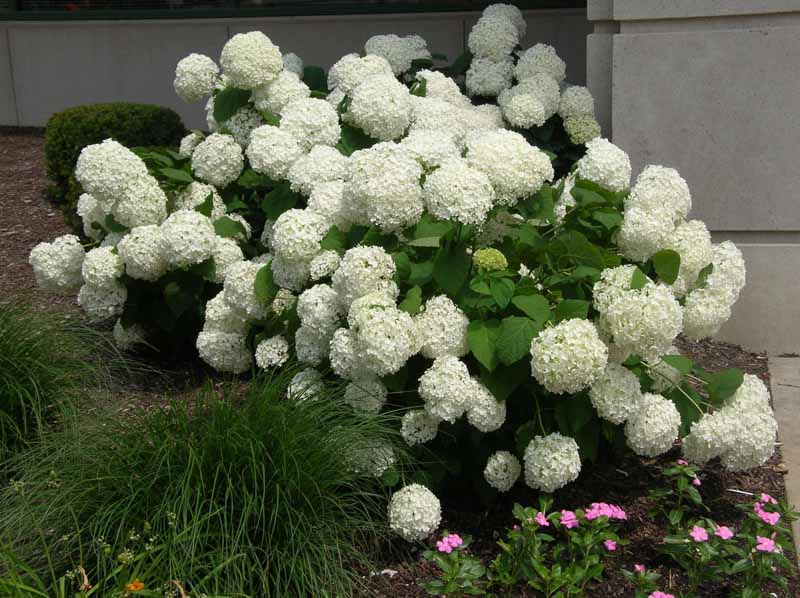
Hydrangea arborescens 'Annabelle'
Smooth Hydrangea
Mammoth snow white blooms of up to one foot in diameter last from June to September and actually get larger as the season progresses on this old fashioned, durable favorite. In fact, the blooms are so colossal that the stems may not always be up to the task of supporting them. They should be planted where they can support each other or caged.

Hydrangea arborescens 'Incrediball'
Smooth Hydrangea
This adaptable native plant produces huge flowers (as much as 12" across) and is both reliable and beautiful. Flowers open green, then mature to white before turning green at the end of their life cycle. Very cold hardy Incrediball blooms on sturdy new growth so no hoops or staking is required.
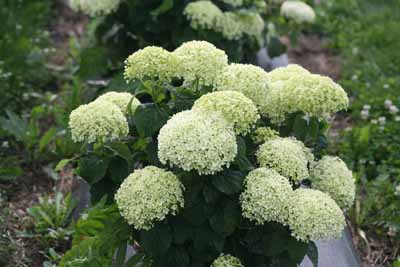
Hydrangea arborescens 'Invincebelle Limetta'
Smooth Hydrangea
Invincibelle Limetta hydrangea is the easy way to experience refreshing summer color every year. It's as reliable as the classic 'Annabelle,' but offers big-time improvements, like strong stems that hold the blooms upright all season, and a dwarf, rounded habit that makes it perfect to plant anywhere, from foundations to flower gardens. In early summer, spheres of lime green flowers appear. They lighten to a soft green-white before turning jade green for the rest of the season. They last clear through frost for a persistent show that takes practically no effort on your part - they are great for both fresh and dried cut flowers.
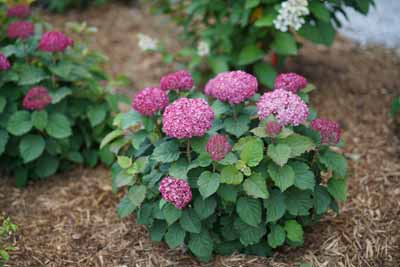
Hydrangea arborescens 'Invincebelle Mini Mauvette'
Smooth Hydrangea
Cold climate gardeners, rejoice: there's finally a purple hydrangea for you! Introducing Invincibelle Mini Mauvette hydrangea - it's unlike anything that's ever come before. Why? Well, it blooms every single year, even in cold climates and is impervious to bad pruning. It's the same type of hydrangea as the classic and much-loved 'Annabelle' but instead of plain white blooms, the flowers are a deep pink-mauve, and they're held up on strong, sturdy stems that don't flop. The show begins in early summer and because Invincibelle Mini Mauvette is a rebloomer, it continues clear through frost for an endless supply of flowers for the landscape or vase (both fresh and dried!).
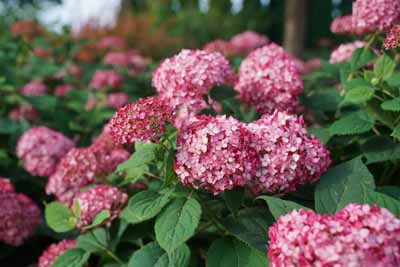
Hydrangea arborescens 'Invincebelle Ruby'
Smooth Hydrangea
The dark burgundy red flower buds of Invincibelle Ruby open to a two-toned combination of bright ruby red and silvery pink. The foliage is extra dark and stems are strong, making this new hydrangea a gem in any garden. It is a strong rebloomer that will be an excellent addition to any garden. Like other smooth hydrangeas, it flowers on new growth and so blooms every year without fail.
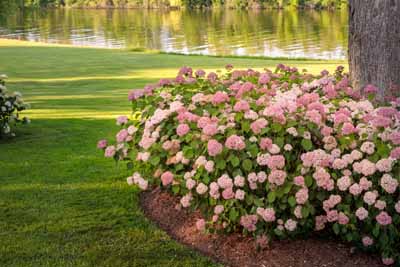
Hydrangea arborescens 'Invincebelle Spirit II'
Smooth Hydrangea
Invincibelle Spirit II hydrangea represents the best in full-sized pink 'Annabelle' hydrangeas. It offers handsome, dark green foliage, sturdy, strong stems that prevent flopping, and large blooms of deep pink that age to an attractive green. Plus, it reblooms, delivering waves of fresh flowers through autumn. This North American native hydrangea grows over a huge range of the US and Canada, thriving in chilly USDA zone 3.

Hydrangea arborescens 'Invincebelle Wee White'
Smooth Hydrangea
Invincibelle Wee White hydrangea is positively ground-breaking: it's the first dwarf 'Annabelle' type hydrangea in the world! This cute little landscape plant ensures that any landscape can enjoy the reliability, low-maintenance, and season-long beauty of hydrangeas. It reaches just 1-2.5' (.3-.7 m) tall and naturally grows as a tidy, rounded mound. Each flower emerges a soft, blush pink before changing to white, and is held up on a strong, supportive stem for a display that looks more like a bouquet of flowers than a landscape plant. Blooming begins in early summer and continues through frost, with new flowers appearing the whole time. Versatile and floriferous, it just might be the solution to your landscape problems. Long blooming. Native to North America.
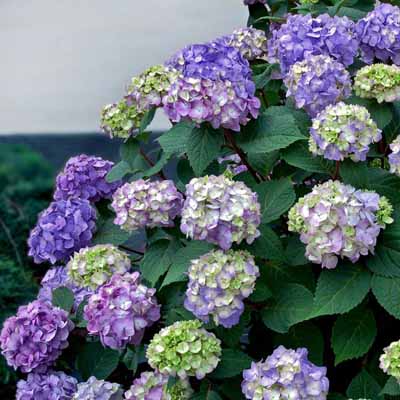
Hydrangea mac. 'Endless Summer Bloomstruck'
Mophead Hydrangea
Dense and compact with deep green foliage, this selection is a reblooming beauty with deep blue, mophead flowers starting in June and continuing all summer. Heavier blooming than Endless Summer The Original.

Hydrangea mac. 'Endless Summer Blushing Bride'
Mophead Hydrangea
The name of this new Hydrangea macrophylla says it all. Pure white blooms with semi - double florets gradually mature to a sweet, pink blush. The foliage is an attractive dark green, providing a striking background for the emerging white flowers.
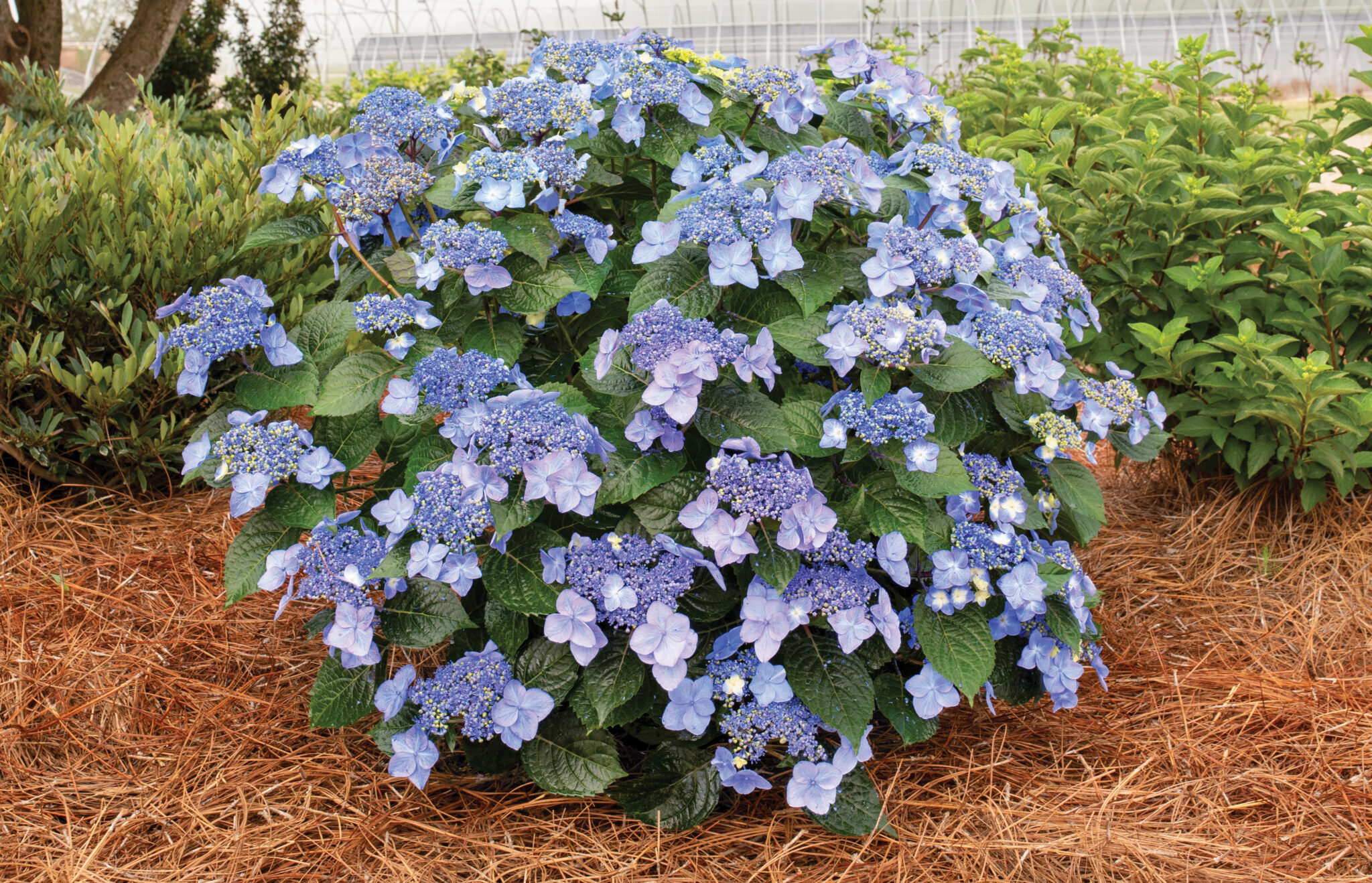
Hydrangea mac. 'Endless Summer Pop Star'
Lacecap Hydrangea
Genetically compact and incredibly floriferous, Pop Star Hydrangea is a lacecap variety that is a standout in the landscape or decorative container. With strong bud hardiness and reliable rebloom, Pop Star is a blooming powerhouse. Its short stature makes this a strong border or short hedge plant that doesn t need pruning to keep its size and is great for year-after-year color on your deck, patio, or porch. The dark green leaves against the blue or pink blooms give the classic hydrangea look, while the lacecap flowers add extra texture and interest to the garden.
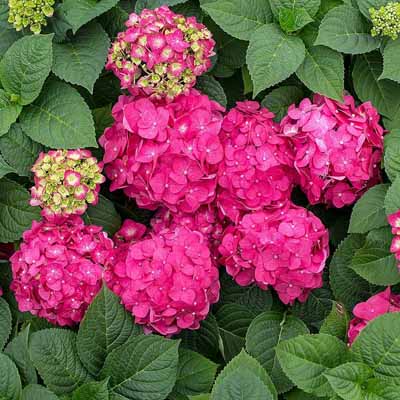
Hydrangea mac. 'Endless Summer Summer Crush'
Mophead Hydrangea
With a profusion of big raspberry red or neon purple blooms, Summer Crush brings floral quality blooms to your garden or patio container. Not only is it drop-dead gorgeous, but it is compact so you get a neat, tidy look throughout the summer
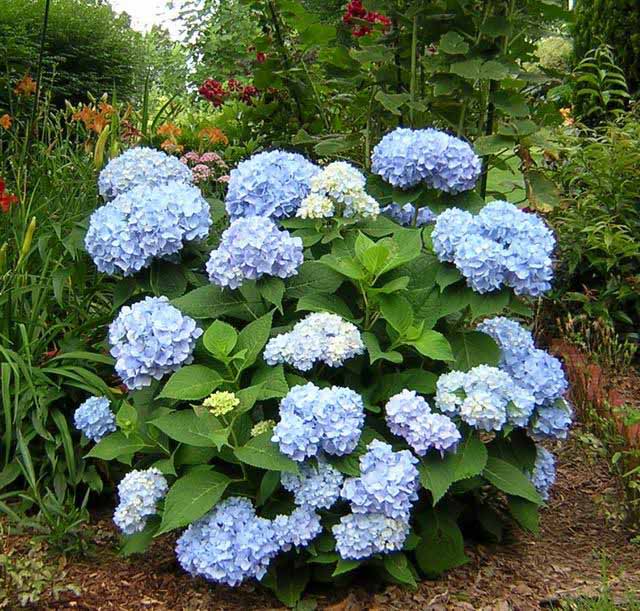
Hydrangea mac. 'Endless Summer The Original'
Mophead Hydrangea
Another first a Bigleaf Hydrangea plant with flowers that form on the current year's growth as well as on old wood. 'Endless Summer' will bloom from early July through late summer, especially if deadheaded regularly, and the flower heads - blue in acid soil - will be up to 6 across.
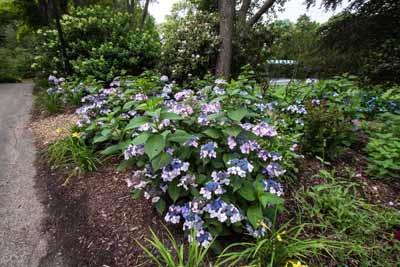
Hydrangea mac. 'Endless Summer Twist-N-Shout'
Lacecap Hydrangea
Like the Endless Summer hydrangea, 'Twist n Shout' is zone 4 hardy, blooms on new wood and blooms repeatedly throughout the season. This variety differs by offering a big, beautiful lacecap blossom and a bi - color mixture of deep pink and startling blue offset by maroon - red stems. The dark foliage then turns a deep maroon in the fall.
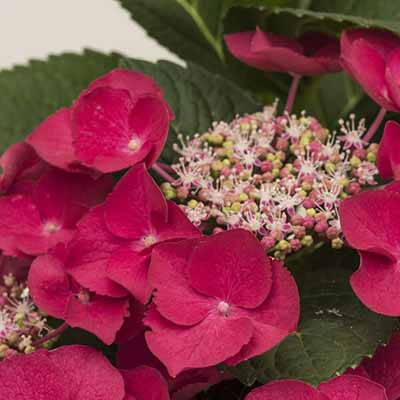
Hydrangea macrophylla 'Cherry Explosion'
Lacecap Hydrangea
Hardy and a bloomer on new wood, this selection will give you scads of color even after the roughest winter. Burgundy fall stems and foliage complete a long season of outstanding color. Acid soils will add purple to its cherry red color.
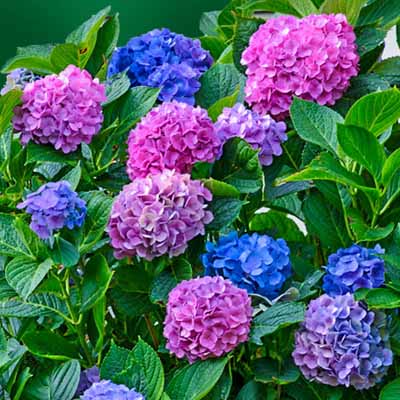
Hydrangea macrophylla 'L.A. Dreamin'
Mophead Hydrangea
L.A. Dreamin' Hydrangea is one of the most impressive big leaf hydrangeas we've seen. It produces pink, blue and lavender blooms all on one plant, regardless of your soil's pH. You no longer have to worry about supplementing your soil to achieve a certain hydrangea color. You'll just delight in the color show as it blooms and blooms again from early summer until fall. Its large flower heads are borne on sturdy, upright stems, and they rebloom strongly, flowering heavily on both old and new wood; this means you will have an abundant show from early summer through hard frost. Plant in humusy soil, ideally in a spot that gets morning sun and a little afternoon shade. This variety holds up better in heat than older ones, but it benefits from extra water when first planted. Named in honor of the breeder's daughter. This outstanding new Big Leaf Hydrangea grows a compact 4' tall and wide, a nice size for most any garden. It's impressive when planted near entryways, along walkways or as a focal point. The flower heads make striking fresh bouquets and can be dried for year-round enjoyment.

Hydrangea macrophylla 'Let's Dance Big Band'
Mophead Hydrangea
Let's Dance Big Band' combines bodaciously big mophead flowers with pure, true colors (pink in neutral/basic conditions, blue in acidic conditions) on a plant that survives winter better and reblooms better. That means more flowers, from the beginning of hydrangea season until the snowflakes fly! Pruning: big-leaf hydrangeas cannot be pruned at any point in the year without negatively impacting the flowering. As such, it's best to avoid pruning this type of hydrangea altogether. If portions of the plant were damaged from winter weather, they can be removed in spring when it is clear where the new growth is emerging.

Hydrangea macrophylla 'Let's Dance Blue Jangles'
Mophead Hydrangea
The reblooming hydrangea that really does! Let's Dance Blue Jangles is a big-leaf hydrangea that blooms on both old and new wood, with a tight, compact habit that is unusual among reblooming hydrangeas. Large, full flower heads will readily go heavenly blue in acid soils; in alkaline soils, they'll be vivid pink. This proven performer will bloom reliably even in zone 5. Salt tolerant.

Hydrangea macrophylla 'Let's Dance Rhythmic Blues'
Mophead Hydrangea
Let's Dance Rhythmic Blue hydrangea will make you feel like the head honcho of hydrangeas. This easy-to-grow, no prune hydrangea was developed in Michigan for superior cold climate performance. Each perfectly formed floret has a distinctive rectangular shape. They combine into dozens of lush, full, mophead flowers that are pink in alkaline soils and a fabulous blue in acidic conditions. An outstanding rebloomer, Let's Dance Rhythmic Blue hydrangea will provide you months of flowers. Blooms on both old and new wood.
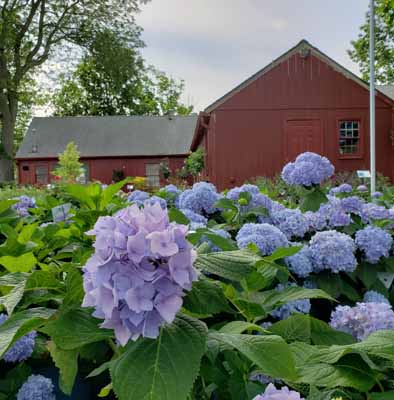
Hydrangea macrophylla 'Nantucket Blue'
Mophead Hydrangea
Selected for prolific blooming, vibrant bloom color and compact growth habit, this repeat blooming Hydrangea features an abundance of summertime flower clusters until frost. Flowers are blue in acidic soil and pink in alkaline soil. This vigorous grower reaches 4 to 6 feet tall and wide.
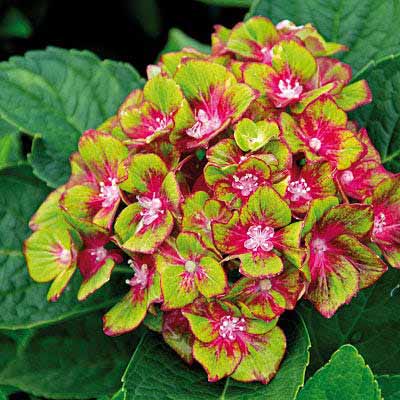
Hydrangea macrophylla 'Pistachio'
Mophead Hydrangea
This eye-catching, compact rebloomer boasts wide mophead flowers filled with an exciting and unique color combination for hydrangeas - lime green accented with a deep rosy pink. Blooms continuously from spring until frost. A stunning accent in the landscape or in a container used to dress up a patio. Wonderful cut or dried flowers. Deciduous.
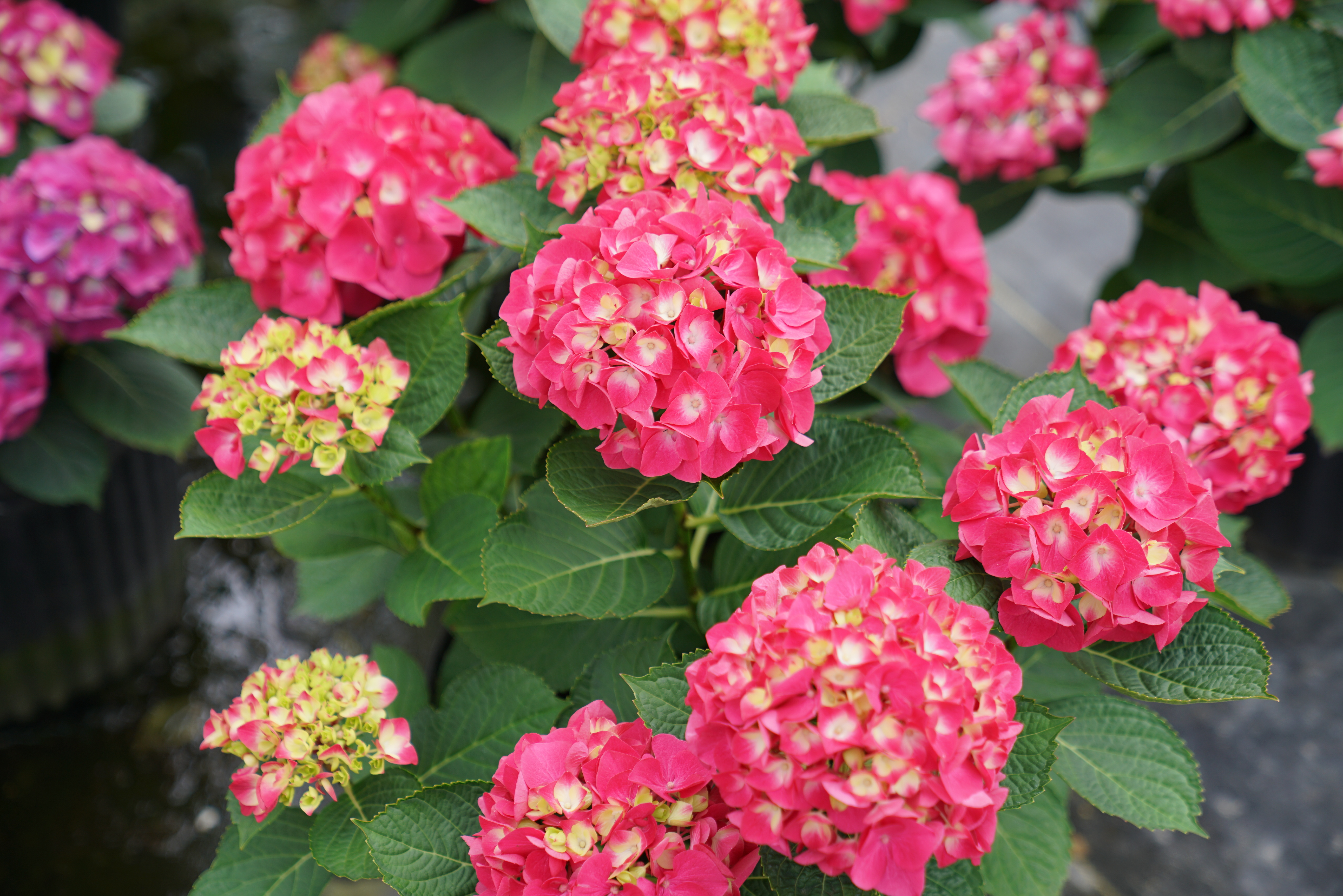
Hydrangea macrophylla 'Wee Bit Giddy'
Mophead Hydrangea
Wee Bit Giddy hydrangea will put a smile on your face - not just because it's absolutely beautiful (though it is!), but because this durable, handsome plant was developed specifically for improved performance in your garden. You might think of it as an improved version of our best-selling Cityline Paris hydrangea, as it shares its same intense red flower color and neat, dwarf habit; however, it adds in the robust durability of Let's Dance Rave hydrangea, which imbues it with outstanding performance in the landscape, even in USDA zones 5 and 6.

Hydrangea macrophylla 'Wee Bit Grumpy'
Mophead Hydrangea
Don't be fooled by its curmudgeonly name: Wee Bit Grumpy hydrangea will put a smile on your face! Like its sister plant, Wee Bit Giddy hydrangea, it was selected for its combination of pure, intense, saturated flower color and outstanding landscape performance. And its color is really something you must see to believe: in acidic soils, its big, full blooms take on a moody, dramatic deep purple-blue. They appear amid a neat, tidy mound of compact foliage that resists disease and stands up better to cold weather than conventional hydrangeas.
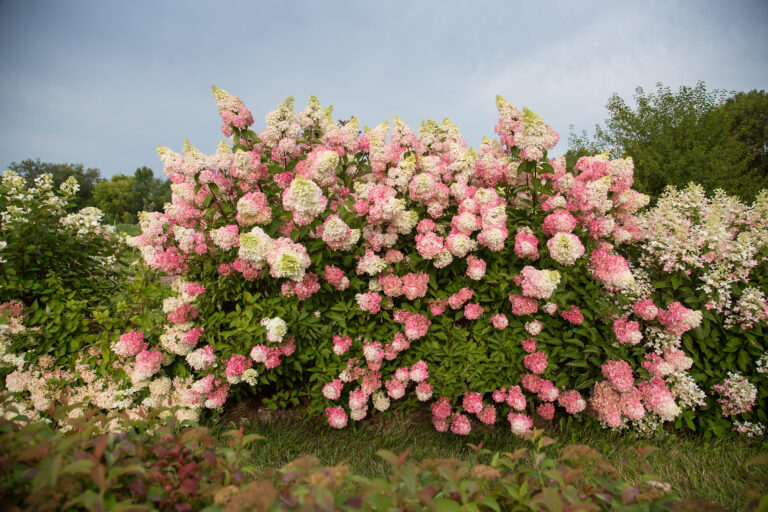
Hydrangea paniculata 'Berry White'
Panicle Hydrangea
Strong, upright stems and large cone-shaped flower panicles that stay upright make Berry White Hydrangea an impressive summer stunner. The flower color starts out white in July then progresses to a jaw-dropping dark pink, beginning at the bottom and developing up to the top of the panicle. The color on Berry White is truly remarkable, especially in cooler climates with a gradual decrease in fall evening temperatures.
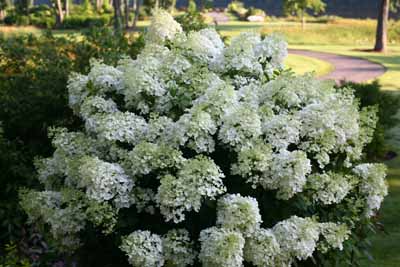
Hydrangea paniculata 'Bobo'
Panicle Hydrangea
Loads of flowers on a tiny plant! This dwarf panicle hydrangea will turn heads! Bobo hydrangea is engulfed by large white flowers in summer. The flowers are held upright on strong stems, and continue to grow and lengthen as they bloom. No flopping, unlike some panicle hydrangeas! As blooms age, they turn pink. It is compact and dwarf in habit, and the flowers cover every inch of the plant right down to the ground. This plant was developed by Johan Van Huylenbroeck, the same breeder that developed Pinky Winky hydrangea.
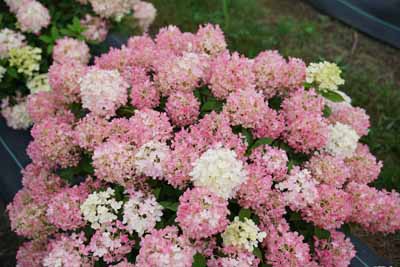
Hydrangea paniculata 'Fire Light Tidbit'
Panicle Hydrangea
If you thought you didn't have enough space to grow a beautiful, reliable panicle hydrangea, Fire Light Tidbit hydrangea is here to help! This innovative new development is the tiniest, tidiest panicle hydrangea yet: it reaches just 2-3'/.6-.9m tall and wide, yet it packs in tons of easy-care beauty into its small size. Big, lush panicles of white mophead flowers appear in early-mid summer, nearly obscuring the textured green foliage. As the summer progresses, they begin to develop bright pink and red tones, which keep it colorful right on up to the first frost, especially combined with its colorful autumn foliage, an unusual trait in panicle hydrangeas. Thick, sturdy stems help to create a neat, mounded plant that's fantastic in landscapes, flower gardens, even in containers! We absolutely love this little beauty paired with the legendary Supertunia Vista Bubblegum petunia.

Hydrangea paniculata 'Fire Light'
Panicle Hydrangea
Fire Light is the standard to measure all panicle hydrangeas! We developed this easy-to-grow, reliable panicle hydrangea in Michigan, selecting it for its huge, full flower heads and sturdy, strong stems. Blooms emerge creamy-white and age to a vivid red for lots of summer color. It makes a great cut flower, fresh or dried, and can be used as a hedge, specimen, or incorporated into flower gardens and foundation plantings.
.jpg)
Hydrangea paniculata 'Limelight Prime'
Panicle Hydrangea
The next generation of 'Limelight' is here! Introducing Limelight Prime hydrangea. In a very short time, Limelight hydrangea became one of the most popular plants ever - but that doesn't mean that there wasn't room for improvement. So we've spent years developing this new selection that does everything better than the original, from bud to bloom and beyond. Here's how Limelight Prime hydrangea is different: Blooms much earlier, creating a longer display. This is especially valuable in colder climates, where 'Limelight' might not bloom until late August. bolder, brighter color. As the green blooms age, they develop pink and red tones that are far more vivid and showy than conventional panicle hydrangeas. stronger stems. Though strong stems is a crucially important factor in the panicle hydrangeas we select for Proven Winners ColorChoice Shrubs, you can count on Limelight Prime to hold its big blooms up all summer long. useful smaller size. Limelight Prime reaches a very garden- and landscape-friendly 4-6'/1.2-1.8m tall and 4-5'/1.2-1.5m wide.

Hydrangea paniculata 'Little Lime Punch'
Panicle Hydrangea
You'll be drinking in the beauty Little Lime Punch hydrangea serves up all season long. Similar to Little Lime , its blooms emerge lime green, but they mature a little differently. Flowers change progressively from the bottom up in a gorgeous array of white, light pink, and rich Hawaiian Punch red! As it reblooms throughout the summer you'll see these four colors mix to create a truly memorable show. With a compact habit and strong stems, you'll find that it's as useful in the landscape as it is beautiful.
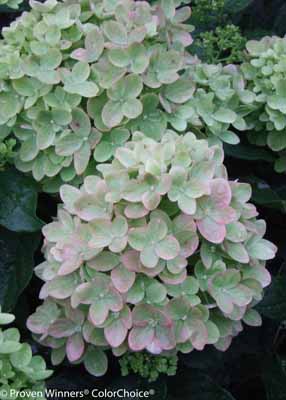
Hydrangea paniculata 'Little Lime'
Panicle Hydrangea
Dwarf 'Limelight' hydrangea! Compared to its famous sibling Limelight , Little Lime hardy hydrangea (Hydrangea paniculata) may seem like a pipsqueak. Don t let this petite shrub fool you. While maintaining its short stature of 3-5 tall and wide, it really packs a visual punch in the garden. In summer, lime green blooms open on strong stems no drooping here. As it ages, rich pink coloring emerges to prolong the show through fall. Little Lime hydrangea is small enough to grow in containers and also stands out as a bold mass planting. Its bright bloom coloration makes it an excellent choice for cut flower gardens and can be used fresh or dried. This reliable performer blooms on new wood, so a quick trim in late winter or early spring will encourage fresh growth and an abundance of buds. Like most hardy hydrangeas, it is hardy to Zone 3 and does best in full sun or part shade.
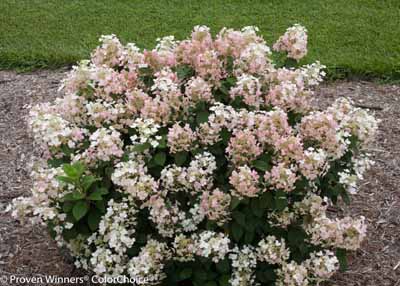
Hydrangea paniculata 'Little Quick Fire'
Panicle Hydrangea
Dwarf form of the popular Quick Fire hydrangea! Like Quick Fire, it is early blooming, flowering about a month before other hydrangeas. White flowers transform to pink-red as summer progresses. This dwarf plant fits easily into any landscape, including container gardens. Add it to your existing hydrangea garden to extend the blooming season.
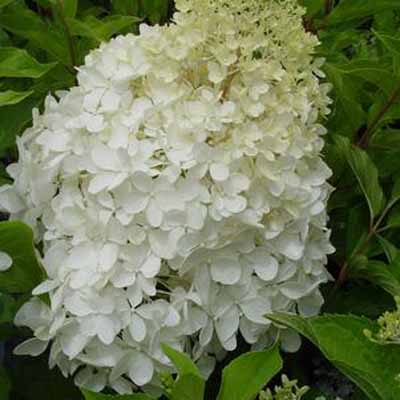
Hydrangea paniculata 'Phantom'
Panicle Hydrangea
If you are looking for huge Hydrangea blooms, there is nothing that holds a candle to 'Phantom' with mammoth flower cones that can be up to 15" tall!! You may rub your eyes when you first see the size of these early to mid August flowers but you can believe it and rest assured that the thick, heavy duty stems that hold them aloft are up to the task of keeping them upright and not floppy, unlike many other paniculata varieties. And, just because they are huge, it doesn't mean they are here and gone. 'Phantom's' flowers last well into the fall taking on a pink shade as they age and they dry well for use in arrangements for inside. 'Phantom' loves full sun or partial shade and will make one of the showiest border plantings ever when grouped.
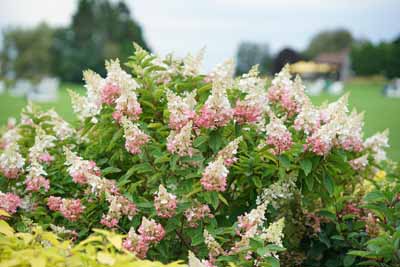
Hydrangea paniculata 'Pinky Winky'
Panicle Hydrangea
Pinky Winky has an unusual name, and an even more unusual flower. The large white panicles open in mid to late summer, and as summer turns to fall the florets at the base of the panicles turn pink. The flower panicles continue to grow, producing new white florets at the tip. The result is spectacular two - toned flower panicles that can reach up to 16 inches in length!

Hydrangea paniculata 'Quick Fire Fab'
Panicle Hydrangea
Quick Fire Fab panicle hydrangea shares the same super-early bloom time, rock-solid reliability, and easy-going nature of the original Quick Fire hydrangea, but adds big, full, showy mophead blooms to the mix. How fabulous is that? It's the best way to get the earliest possible panicle hydrangea flowers, expanding the seasonal display by two weeks or more every year. If you look closely at the lush blooms, you'll see each floret has an unusual cruciform shape which gives them a textural effect you won't find in other panicle hydrangeas. As the blooms age, they turn blush pink, then bright pink, then red, from the bottom up, making each one look like a big delicious ice cream cone that goes from vanilla to berry as the summer progresses. Quick Fire Fab provides 3+ months of flowers and color in your landscape or garden, and does it all with almost no work or effort from you.
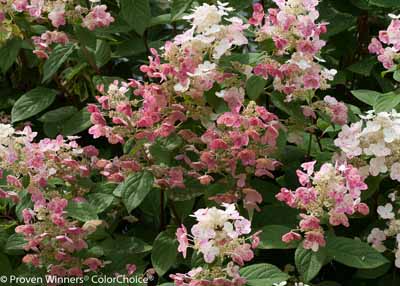
Hydrangea paniculata 'Quick Fire'
Panicle Hydrangea
The first to bloom! 'Quick Fire' blooms about a month before other hardy hydrangea varieties. Flowers open white then turn pink, and will be an extremely dark rosy - pink in the fall. They are produced on new wood and will bloom after even the harshest winters.

Hydrangea paniculata 'Strawberry Sundae'
Panicle Hydrangea
Strawberry Sundae is a delicious new compact hydrangea. Flowers emerge creamy white in mid-summer, change to pink as night temperatures drop. The fantastic flower color lasts well into fall. With its compact habit, this hydrangea adds spectacular color and impressive flowers to small space gardens or containers. It is also excellent for fresh cut and dried flower arrangements. Flower color varies based on climate and growing conditions.
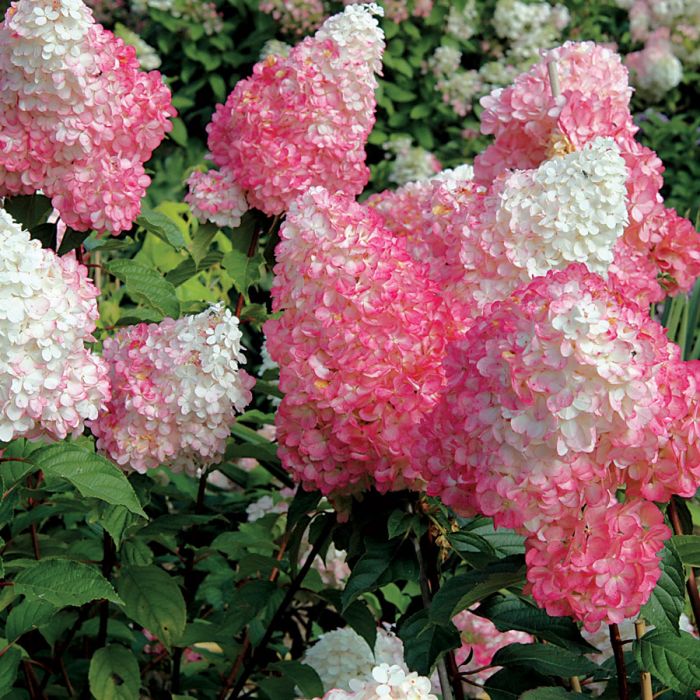
Hydrangea paniculata 'Vanilla Strawberry'
Panicle Hydrangea
The enormous flower heads are a blend of vanilla and strawberry, held upright on red stems. Flowers emerge creamy white in mid-summer, change to pink as the night temperatures drop and finally turn strawberry red. New blooms emerge as older blooms change color, giving the plant a multicolored effect in late summer and early fall. The red coloring lasts at least 3-4 weeks. Plants grow upright, and then cascade later in the season. Excellent for fresh cut and dried flower arrangements. Flower color varies based on climate and growing conditions.
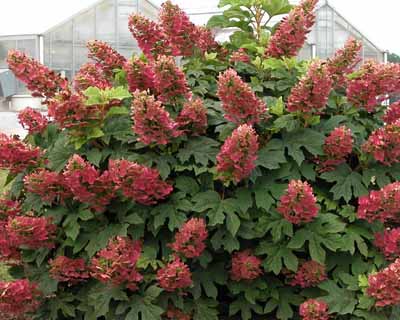
Hydrangea quercifolia 'Ruby Slippers'
Oakleaf Hydrangea
A profusion of exceptionally large, white blooms in summer that quickly age to deep pink. Robust blooms remain upright even after heavy rains. Dark green, deeply lobed oak-like foliage turns brilliant mahogany in fall. The compact form works in smaller landscapes and is useful for mass planting, hedges or borders. Deciduous.

Hydrangea quercifolia 'Snow Queen'
Oak Leaf Hydrangea
Snow Queen is an elegant and showy full - sized oakleaf hydrangea variety, Snow Queen was selected for its plethora of big full bloom trusses which begin their show in July. The dark green oak - like leaves turn a striking red - bronze color in the fall. Exfoliating bark and orange buds create winter interest.
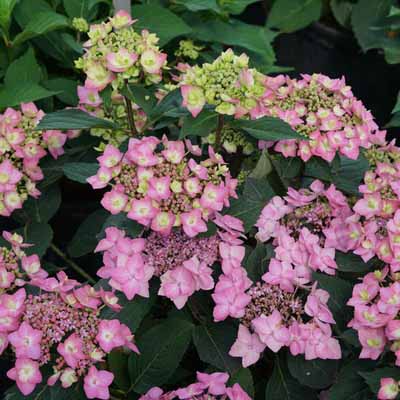
Hydrangea serrata 'Let's Dance Can Do!'
Reblooming Mountain Hydrangea
One look at Let's Dance Can Do hydrangea tells you it's beautiful - but there's more to this innovative new hydrangea than that. It has the unique ability to create flower buds along the entire length of the stem instead of only at the top like other big-leaf hydrangeas. That means that even if winter does its worst and kills back a portion of the plant, there will still be flower buds to open in early summer. It's also what makes Let's Dance Can Do hardy to USDA zone 4 - not only will it survive in such a cold area, it will actually bloom there! Let's Dance Can Do also reblooms quicker than others: in other words, you won't have to wait until fall to see the new flowers. And about those flowers! They are lacecaps, but the size and quantity of the showy sterile florets obscures the tiny fertile florets. Flowers are a luscious strawberry pink in neutral/alkaline soils and a lovely lavender in acidic ones. Salt tolerant.
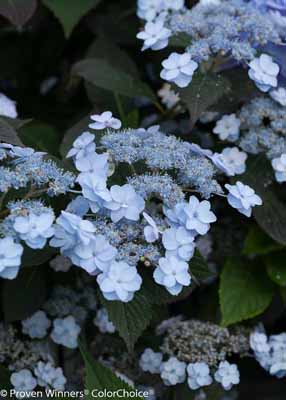
Hydrangea serrata 'Tiny Tuff Stuff'
Mountain Hydrangea
Very hardy reblooming hydrangea! We love Hydrangea serrata because they are so bud hardy and bloom reliably. This is a real beauty, with flowers so delicate and refined that it seems strange to call them tough - but they are. As mentioned, extremely bud-hardy, each year it produces abundant lacecap flowers comprised of doubled sepals. It is a rebloomer. While this plant leans to blue, the flower color may range from blue to pink to white, all soft, delicate shades perfect for refined gardens. The flowers age to an attractive pink, and tip down in a distinctive arching fashion. It has smaller, narrower leaves and an abundance of dainty flowers that cover the plant every summer. Add aluminum sulfate to the soil to encourage blue flower color. Blooms on old and new wood.
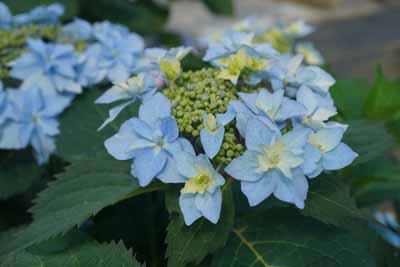
Hydrangea serrata 'Tuff Stuff Ah-Ha'
Reblooming Mountain Hydrangea
One of the most prolific reblooming hydrangeas. All summer long, it devotes its energies to creating flower buds on its new growth so that you have a constant supply of fabulous blooms from early summer through frost. Tuff Stuff Ah-Ha hydrangea will bloom pink or blue, depending on soil chemistry.
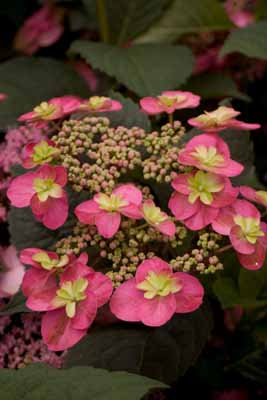
Hydrangea serrata 'Tuff Stuff Red'
Mountain Hydrangea
Colorful, beautiful, reliable. Tuff Stuff Red is the newest edition to the Tuff Stuff series of mountain hydrangeas. These unique hydrangeas fare better in cold weather than their cousins, big-leaf hydrangeas, making them the perfect choice for landscapes and gardens in USDA zones 5 and 6. Large, lacecap flowers are a deep pink-red color which is set off by lustrous, deep green foliage. This reblooming hydrangea begins blooming in early summer on old wood and continues to produce flowers on new wood through autumn, ensuring a showy, abundant display. Small, rounded habit gives Tuff Stuff Red extra versatility in the landscape - grow it as a foundation planting, low hedge, edging, or specimen.

Hydrangea serrata 'Tuff Stuff'
Reblooming Mountain Hydrangea
So pretty, it's hard to believe it's so tough! But indeed, Tuff Stuff mountain hydrangea lives up to its name. It shares the showy blooms and beautiful pink or purple color of big-leaf hydrangeas, but because it grows wild on the chilly mountain tops instead of the mild seaside, it naturally developed substantially better cold tolerance. The sturdy lacecap blooms will be bright pink or deep purple-blue, depending on your soil pH, and the handsome dark green foliage resists wilting. If you've had trouble getting big-leaf hydrangeas to bloom reliably in your landscape, try Tuff Stuff - it's the reblooming hydrangea that really does.
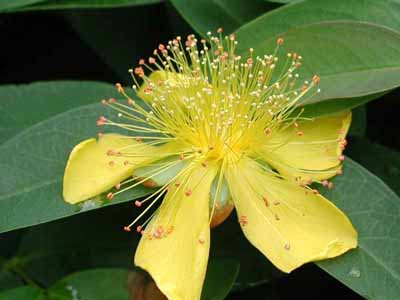
Hypericum 'Hidcote'
St. John's Wort
Brilliant golden yellow 3-inch, cup-shaped flowers bloom on this tidy mounding shrub. Attractive dark green foliage adds contrast to the blooms. Well suited as a low, untrimmed hedge. Stunning color when planted in mass. Grows well in dry, rocky soils.
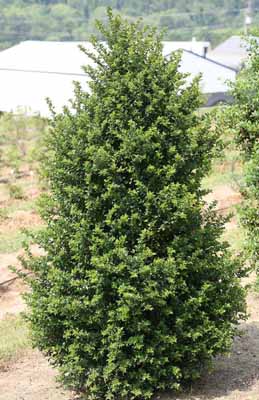
Ilex 'Red Beauty'
Blue Holly
Red Beauty is a distinctive holly that combines dark glossy foliage with an abundance of bright red fruit. 'Blue Prince' is recommended as the male pollinator. More heat tolerant than other blue hollies.

Ilex crenata 'Beehive'
Beehive Japanese Holly
A dense compact mounded form with lustrous dark green leaves.

Ilex crenata 'Bennet's Compact'
Japanese Holly
This crenata or Japanese holly type of ilex is a dense, compact shrub. It has glossy, dark green foliage and grows to about 4' high and 4' wide. This evergreen shrub is low maintenance and is ideal for shrub beds, massing, foundation plantings, and hedges.
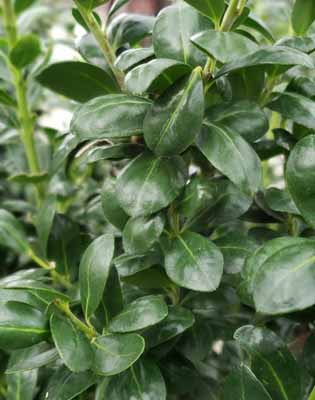
Ilex crenata 'Chesapeake'
Chesapeake Japanese Holly
Lustrous black berries are attractive to birds which feed on them in fall. Excellent carefree shrub for even green background that can be sheared for a formal appearance. Makes a good medium height privacy or wind screen hedge
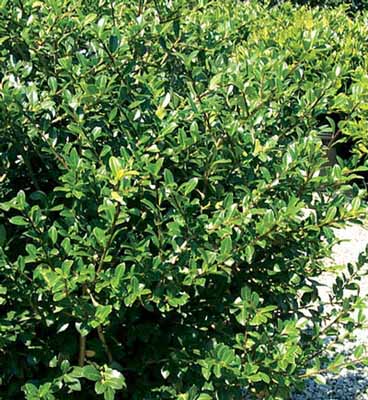
Ilex crenata 'Green Lustre'
Green Lustre Holly
A low growing handsome shrub with dark green lustrous foliage. The growth habit is dense and mounding with a wider spread. The Green Lustre is hardier than many Japanese hollies. Small flowers are inconspicuous followed by black fruit in winter
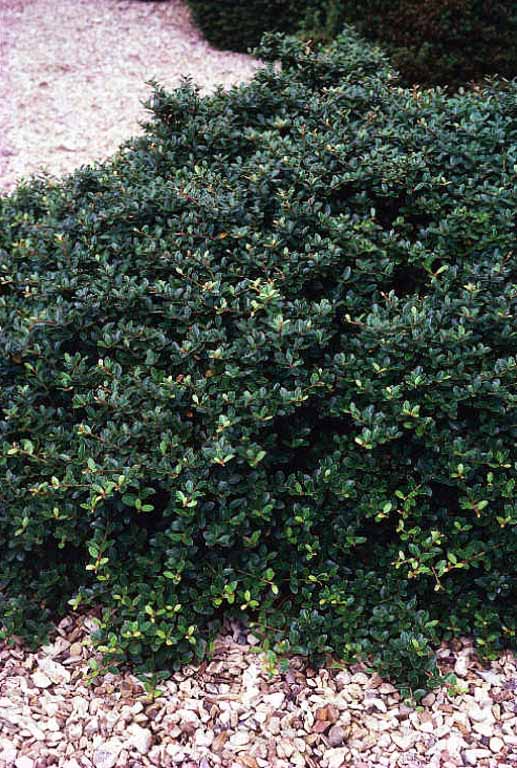
Ilex crenata 'Helleri'
Dwarf Japanese Holly
Beautiful low, dense form! Branching habit is tight and mounding and foliage is small, but deep green. Great for small spaces, low maintenance.
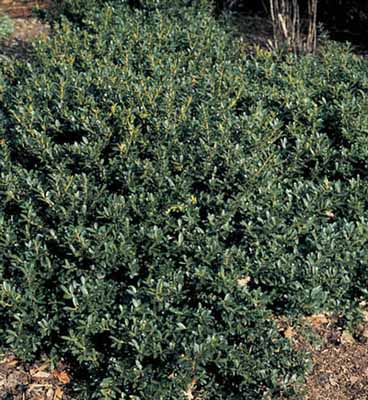
Ilex crenata 'Hoogendorn'
Japanese Holly
A low growing dense, mounding and compact evergreen with excellent dark green shiny flat leaves. Grows twice as wide as it does tall and does well in full sun or partial shade. Little or no pruning is need making this a maintenance free plant. A good foundation plant or border hedge.
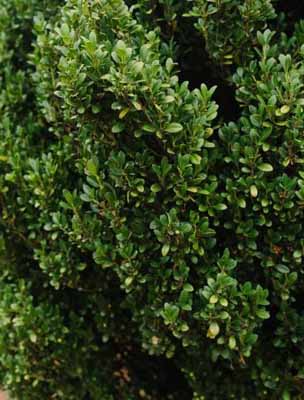
Ilex crenata 'Lucky Marble'
Japanese Holly
Add dependability and some significant texture to your landscape with this easy to grow, the slow-growing evergreen that will certainly grow on you! Dense, compact and rounded, this slow grower features shiny, tiny foliage that you will just love to touch! Easy to grow. Perfect for half-day sun/half-day shade. Tiny, lustrous foliage adds loads of 'touch me' texture to the landscape. Perfect for grouping to form a small border planting and excellent for small landscape spaces.
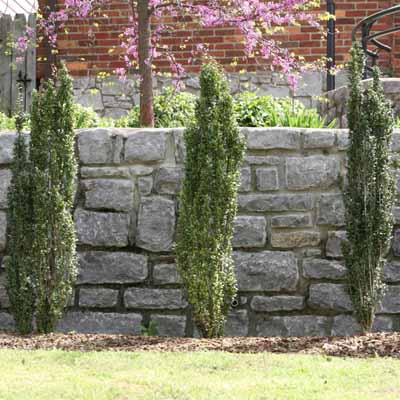
Ilex crenata 'Sky Pencil'
Sky Pencil Japanese Holly
A narrow, columnar form with dark green foliage that stays neat year-round, and often sports small purple berries in fall, with a male pollenizer nearby. Leaves lack sharp points, making it ideal for decks, patios, or entryways as a vertical accent

Ilex crenata 'Soft Touch'
Soft Touch Compact Holly
A dense, mounded, evergreen shrub with soft-textured, glossy green leaves that have an interesting silver mid-vein. Works wonderfully when planted in borders, as an accent, or along walkways
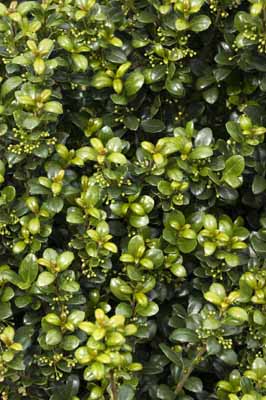
Ilex crenata 'Steeds'
Steeds Upright Holly
An easy-to-grow, densely branched evergreen shrub with an attractive upright, pyramidal form. Dense, lustrous, dark green foliage adds color to the landscape year-round. Tiny white flowers produce ornamental black berries that persist throughout winter
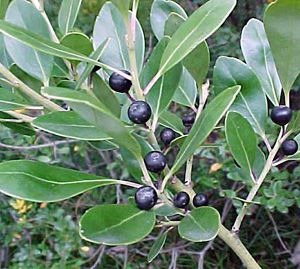
Ilex glabra 'Compacta'
Inkberry
Slower growing, wide, dense upright form of the native Inkberry. Black berries. Native to the eastern USA, this variety has proven to be one of the most reliable of the hollies. Inkberry prefers moist, acid soils and full sun, but it will tolerate partial shade very well. It is the only holly that spreads by underground stems and will form colonies, making it valuable for mass plantings and hillsides. Very tolerant of shearing.
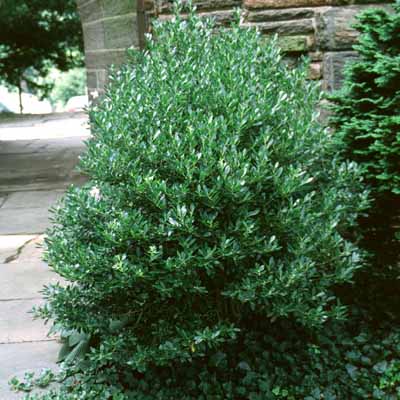
Ilex glabra 'Densa'
Inkberry
This tough, durable broadleaf evergreen is an outstanding plant due to its ability to provide year round cover for a host of native bird species while providing an excellent food source for these same birds with it black berries. What's more, it's an easy keeper that prefers moist, acid soils and full sun, but it will tolerate partial shade very well.
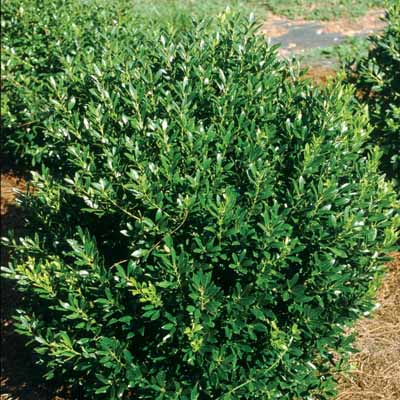
Ilex glabra 'Shamrock'
Inkberry
Shamrock Inkberry is a cultivar of our native Ilex glabra. It is a compact form with lustrous, deep green leaves with the new leaves emerging bright green above the older, darker green foliage. This plant is a good multi - purpose plant for hedges, mass planting, foundations, and use as a specimen.
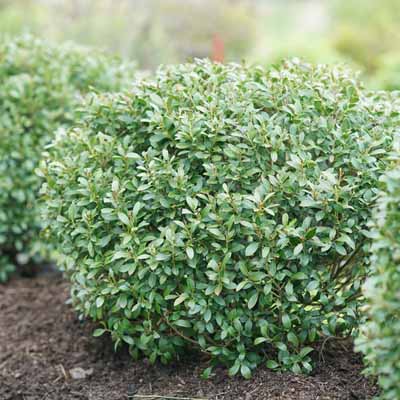
Ilex glabra 'Strongbox'
Inkberry
Native alternative to boxwood. Love boxwood but struggle with disease or winter damage? Plant Strongbox inkberry holly instead. This native evergreen naturally grows as a broadly rounded mound, and keeps its leaves all the way to the ground for the lush, dense look you love. It can be pruned or shaped as you desire, or left to attain its neat natural shape. It's also much faster growing than boxwood, and offers good deer resistance, too.
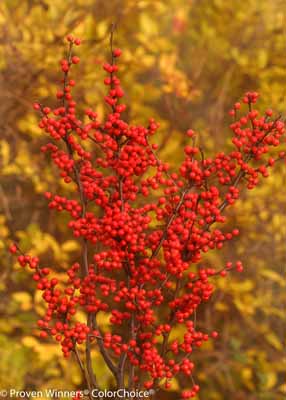
Ilex verticillata 'Berry Heavy'
Winterberry
Heavy berry production for brilliant winter color! Berry Heavy winterberry produces copious amounts of bright red berries that really shine in the fall and winter landscape. It is a deciduous holly, which means it loses its leaves in fall, but this makes that vivid fruit even showier. The berries can also be cut for use in floral arrangements. To produce berries a male and female plant are both required - use Mr. Poppins winterberry holly as the pollinator. Berries are not edible for humans but are relished by birds after they've softened in mid-winter. Native to North America.
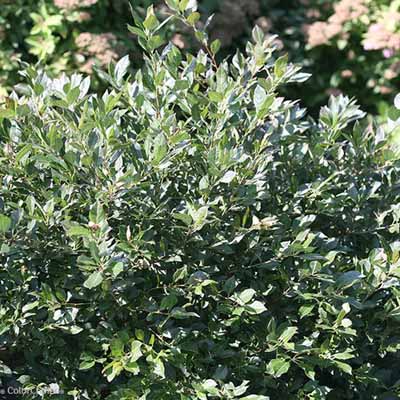
Ilex verticillata 'Little Goblin Guy'
Winterberry Holly
Little Goblin Guy winterberry holly is a male pollinator for Little Goblin Orange and Little Goblin Red. Though it will not bear fruit itself, it plays a crucial role in getting the best from the female varieties. Little Goblin Guy blooms at the same time as the female Little Goblin varieties, guaranteeing a good crop of showy berries all winter long.
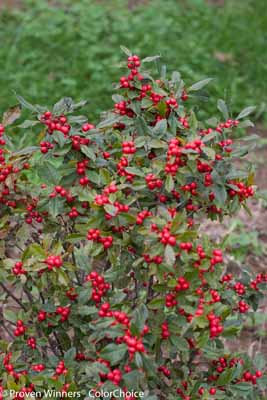
Ilex verticillata 'Little Goblin Red'
Winterberry Holly
This unique winterberry brings you extra big and abundant rich-red berries on a dwarf plant. You will treasure this plant for gardens, mass plantings or as a cut branch. Its compact size makes it ideal for residential landscapes. Native to North America. To produce berries, you'll need a Little Goblin Guy ilex, the male pollinator. One Little Goblin Guy will pollinate up to five Little Goblin Red and/or Little Goblin Orange winterberry hollies; plant within 50'/15.24m of one another.

Ilex verticillata 'Mr. Poppins'
Winterberry
This compact male winterberry is the ideal pollinator for Berry Poppins or any Proven Winners winterberry holly.
Ilex verticillata 'Red Sprite'
Winterberry
Red Sprite' is a compact winterberry holly with glossy foliage and impressive fruit set. Branches may be cut for arrangements but this plant's dwarf habit makes it less suited to cutting than larger plants. For berries on this female selection, a male pollinator is required; use 'Jim Dandy' or Mr. Poppins winterberry holly. Fruit is not edible.
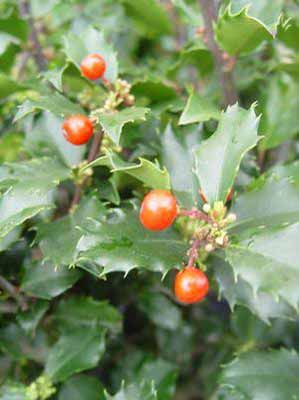
Ilex x meserveae 'Berryific'
Holly
This variety is actually a 'Blue Prince' and 'Blue Princess' holly planted closely together to provide tons of berries reliably every year. 'Berryific' produces a colorful, distinctive, pyramidal evergreen that is ideal for gardeners that are unable to accommodate separate male and female plants.
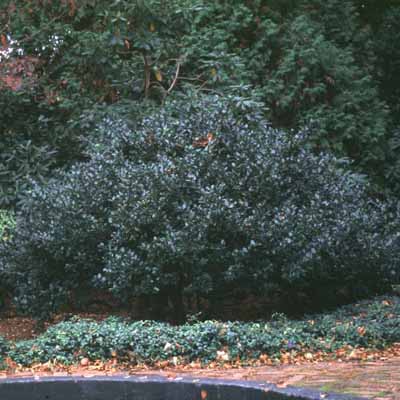
Ilex x meserveae 'Blue Prince'
Holly
Superb dark blue - green leathery foliage on purple stems! This variety, along with its ability to pollinate any female meserveae holly, has great form and texture in the landscape and is extremely hardy.

Ilex x meserveae 'Blue Princess'
Holly
Large, dark blue - green foliage and exceptional berry production make this evergreen holly particularly attractive. The broad growing holly can reach a height of 12ft and 9ft wide. Performs well in full sun or part shade. Requires a male of the species to cross pollinate and set fruit.

Ilex x meserveae 'Castle Spire'
Holly
A superb selection that is more compact and more dense than 'Blue Princess' with a better branching system. This plant's foliage is superb with big lustrous, bluish - green leaves that show off an ample amount of bright red fall berries. Use Ilex 'Castle Wall' to cross pollinate and set fruit.
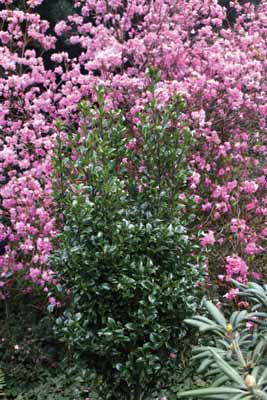
Ilex x meserveae 'Castle Wall'
Holly
This hard - working selection performs double duty by providing the pollen that will ensure that 'Castle Spire' has an abundant supply of berries and by providing a columnar landscape shape. This plant has shiny, deep blue - green foliage on a upright form that makes it ideal for tight spaces.
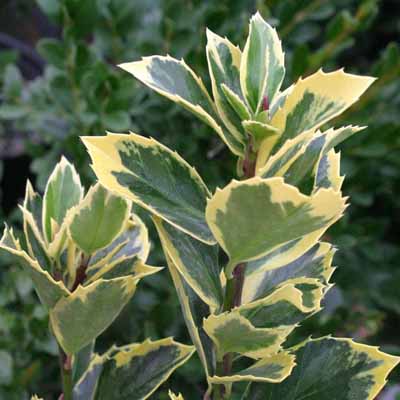
Ilex x meserveae 'Honey Maid'
Blue Holly
A variegated form of Blue Maid holly with very stable yellow and green foliage. This is a female plant which will produce red berries if planted near a male pollinator such as 'Blue Prince' or Castle Wall ilex.
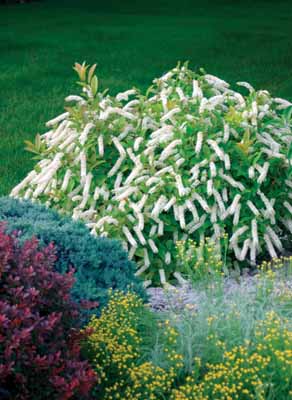
Itea virginica 'Little Henry'
Sweetspire
Little Henry' may sound small, but the landscape show it puts on is anything but small! Low and mound forming, this selection starts the show with an explosion of pure white lightly scented flower spires that shoot out like fireworks in late June that sets it apart from the crowd. In fall the foliage turns a shade of red that may outshine the burning bush.
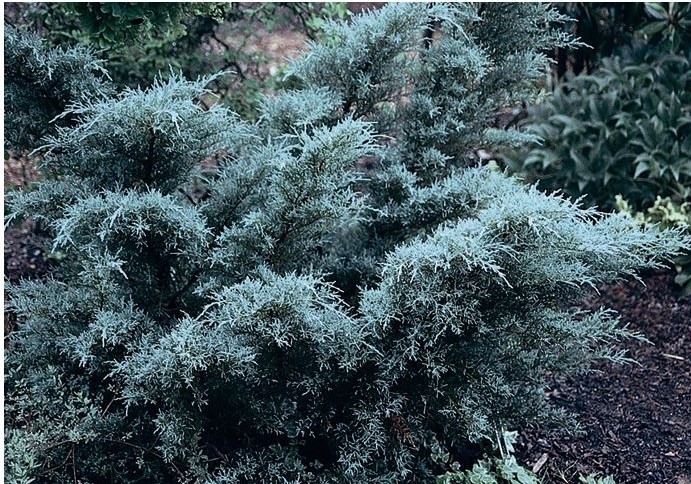
Juniperus chinensis 'Angelica Blue'
Blue Juniper
The bright blue color of the fine-textured foliage is intensified by the cool winter temperatures. Creates excellent texture and color contrast when mixed with dark green foliaged plants. Prefers a well drained soil. Full sun. Evergreen.
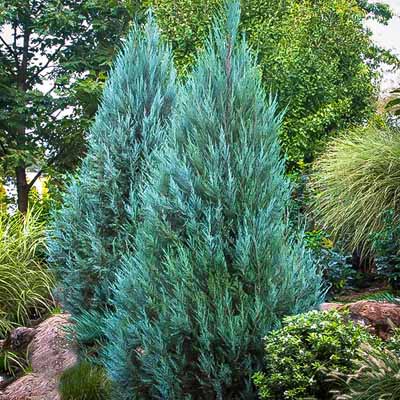
Juniperus chinensis 'Blue Point'
Blue Point Juniper
A favorite for stately lawn specimens and tall screens. Glowing blue-green foliage on a densely branched, broad pyramid form that maintains its natural form well with practically no pruning. Clipped topiary forms make a wonderful formal accent in entrances or on patios. Evergreen.

Juniperus chinensis 'Hollywood'
Juniper
The artistic appearance of its twisted, rustic form makes this a wonderful landscape accent. An excellent evergreen for use as a topiary specimen in containers and formal gardens. Well-suited for cooler coastal regions. Named for its popularity in Los Angeles gardens, this twisted upright beauty is very cold hardy. Its unique form and deep green color is striking against peach or white stucco walls. Use at entries and to mark gateways, and it is very attractive in conjunction with wrought iron gates. Grow on the corners of your house or between windows. It can be lined up in an informal hedge, but this spoils its drama as a single specimen and will not have the manicured appearance of a true hedge. Perfect for Mediterranean, Santa Fe, and Asian inspired gardens.

Juniperus chinensis 'Sargentii'
Juniper
A ground - covering wonder with a strong horizontal branching habit and an aggressive nature, this juniper sports small, medium green, needle - like foliage and a clean, refined look. This is one of the best low growing junipers for grouping on banks en mass..
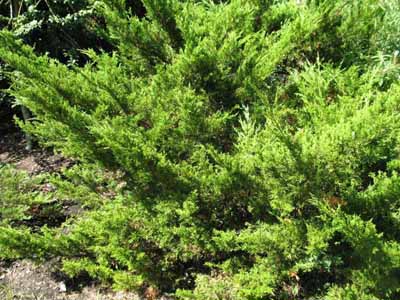
Juniperus chinensis 'Sea Green'
Juniper
A dense, vigorously spreading juniper with attractive, nearly kelly green foliage and a very interesting vase - like to arching form. As with all junipers, it is very tolerant of dry, sandy soils and is quite salt tolerant making it a great plant for road

Juniperus communis 'Gold Cone'
Gold Cone Juniper
Golden new growth appears on this columnar, narrow, upright evergreen. Golden foliage gradually fades to blue-green in winter. Slow growing, easy to grow. Tolerates poor soil conditions
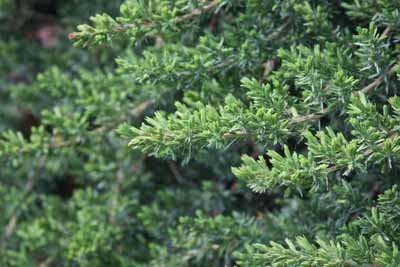
Juniperus conferta 'Blue Pacific'
Juniper
This evergreen groundcover may be short in stature, but its wide trailing habit, aromatic blue - toned needles, and cold, heat, salt, and drought tolerance will win you over. This is one of the more useful and attractive of the junipers with soft low growing foliage and a quick spreader - perfect for hard to landscape places.

Juniperus horizontalis 'Bar Harbor'
Juniper
Known for its rock hardiness, this aggressively spreading groundcover juniper is one of the most functional plants you'll ever use. Deep green summer foliage color turns nearly purple in the winter months, adding an unusual color to the winter landscape. A plant that's very tolerant of poor soil conditions, 'Bar Harbor' is best used in large group plantings. Plant in full to partial sun. Prune in early spring before new growth begins. Do not prune beyond where green growth is; avoid shearing.
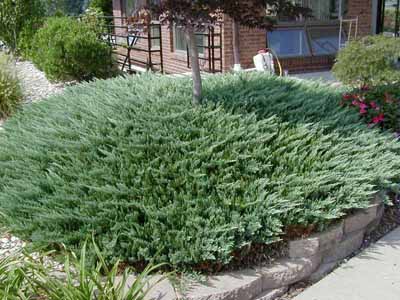
Juniperus horizontalis 'Blue Chip'
Juniper
A vigorous, prostrate growing juniper, 'Blue Chip' is best known for its eye - catching steel blue color and its ability to cover real estate quickly. A perfect plant for groupings and very adaptable to rough, sandy soils and salt conditions.
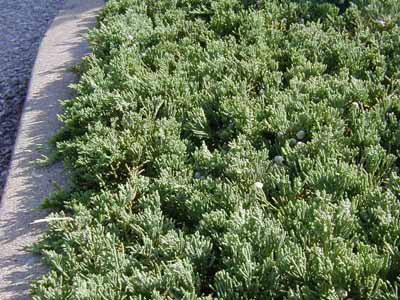
Juniperus horizontalis 'Wiltonii'
Blue Rug Juniper
One of the finest trailing junipers having a uniform, full centered growth habit with intense silver-blue evergreen foliage. Excellent for large scale groundcovers or cascading over walls.
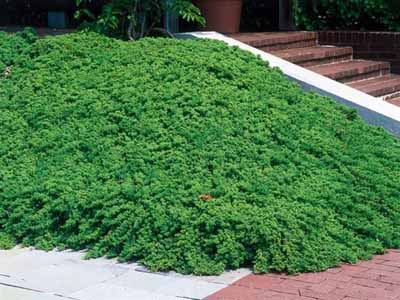
Juniperus procumbens 'Nana Greenmound'
Nana Greenmound Juniper
Very similar to J. 'nana', lower growing with with greener needles. It does not "hump up" in the middle like 'Nana' and has a soft, flat, rug-like texture.
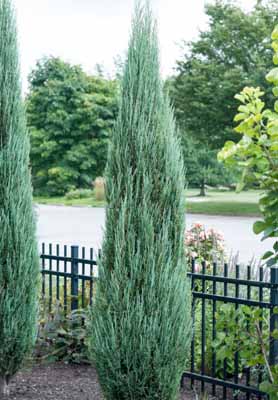
Juniperus scopulorum 'Blue Arrow'
Juniper
An improved selection with tight, bright blue foliage and a very narrow, upright form. Perfect as a tall, narrow screen where space is limited. Makes a colorful addition to the garden. Produces silvery blue berries from late spring to late winter. Evergreen.

Juniperus squamata 'Blue Star'
Juniper
Very slow growing, with a low rounded habit. This spectacular plant remains dense throughout its life and has an extremely eye - catching rich blue color.

Kalmia latifolia 'Carol'
Mountain Laurel
Dense and vigorous with dark evergreen foliage and masses of burgandy-red flower buds that open raspberry-pink in late May. Growth and form make make this plant ideal for woodland group plantings. Beautiful foliage showcases a great display of late May flowers. Shade tolerant. Likes enriched, well-drained soil and mulch. Remove spent flowers. Prune after flowering.
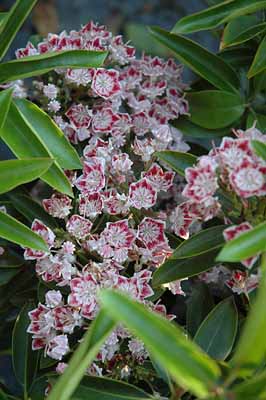
Kalmia latifolia 'Carousel'
Mountain Laurel
Fast - growing, dense and upright, 'Carousel' features burgundy stems holding dark glossy foliage that impresses all year round. Soft pink flower buds open in late May to immaculate clusters of cup - shaped flowers boasting intricate patterns of cinnamon - purple bands on a white background. Dappled sun or shade tolerant.
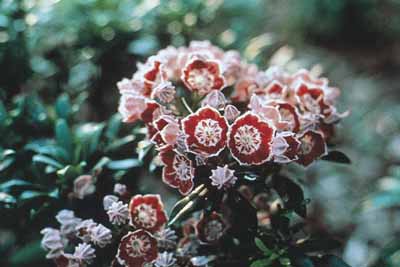
Kalmia latifolia 'Minuet'
Mountain Laurel
Pink buds open to gorgeous white flowers with a striking maroon-red band around the inside edge. Useful as a landscape accent, informal hedge or border where its flowers can be enjoyed. Dwarf, slow growing North America native plant. Evergreen.

Kalmia latifolia 'Nipmuck'
Nipmuck Mountain Laurel
Nipmuck' sets loads of buds that color deep red in late May and burst into color soon after. Flowers open light pink to almost white with a pink petal back that gives this plant's ample bloom a two-tone look that's subtle, yet beautiful
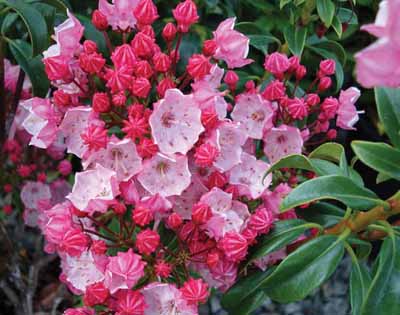
Kalmia latifolia 'Olympic Fire'
Mountain Laurel
Upright, dense and rounded, this evergreen shows twisted, deep green foliage and loads of bright red flower buds that open pink in early to mid-June. Superb for naturalizing in groups as woodland edge border planting. Interesting, showy foliage and eye-turning bloom just before summer begins. Shade tolerant.
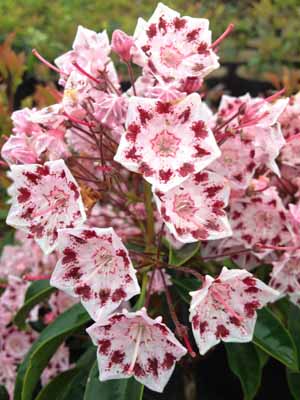
Kalmia latifolia 'Olympic Wedding'
Mountain Laurel
This dependable performer has all the attributes that make people fall in love with Mt. Laurel. Start with deep green, glossy foliage that looks great year round on a vigorous yet dense growing plant. Add in flowers with loads of deep pink buds that open in late May through mid - June to reveal light pink with cinnamon banding and this will become a favorite in your yard.
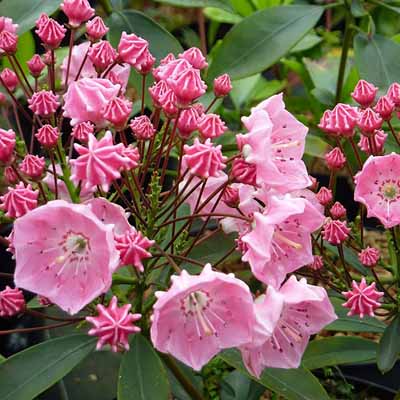
Kalmia latifolia 'Pink Charm'
Pink Charm Mountain Laurel
Deep pink buds open to rich pink flowers with a narrow dark pink ring near the base of the corolla. Ideal for a lightly shaded, woodland setting, providing year round protection for birds. Effective in mixed shrub borders.

Kalmia latifolia 'Raspberry Glow'
Raspberry Glow Mountain Laurel
Dense and vigorous with dark evergreen foliage and masses of burgandy-red flower buds that open raspberry-pink in late May. Growth and form make make this plant ideal for woodland group plantings.Native
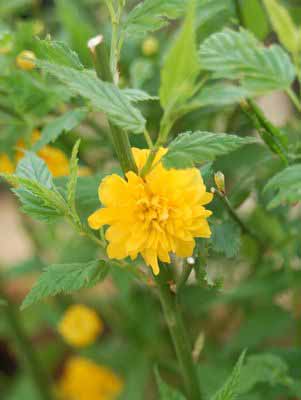
Kerria japonica
Japanese Kerria
A free flowering, fine textured shrub that performs well on borders and tolerates shadier conditions without compromising bloom. Bright yellow blossoms are heaviest in late April to early May but plant will flower sporadically throughout the year. Interesting bright green stems are effective in the winter landscape.
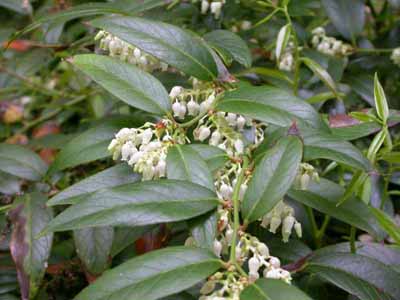
Leucothoe axillaris 'Squirt'
Compact Leucothoe
This evergreen is dense and showy with its rich mahogany and copper-toned new growth that really stands out against the glossy, green leaves. Native bees love the nectar from the fragrant, white, bell-shaped flowers that bloom in May. Its low, spreading form is perfect for grouping in shaded areas.
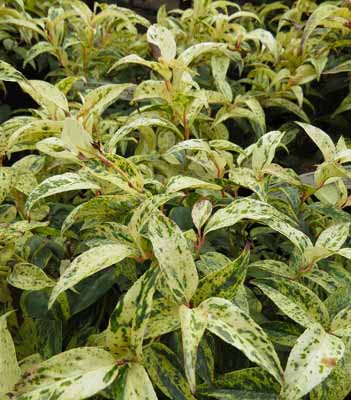
Leucothoe fontanesiana 'Rainbow'
Rainbow Leucothoe
Gracefully arching, striking red stems with colorful, creamy white and green mottled foliage with scarlet accents. A beautiful, natural woodland companion to rhododendrons and ferns. Evergreen.
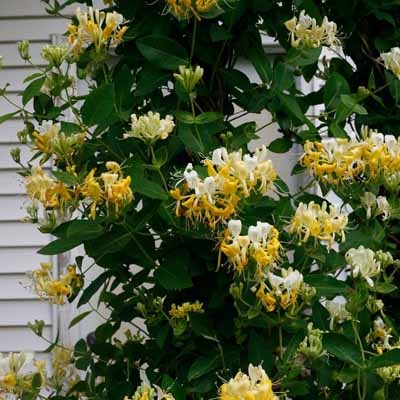
Lonicera 'Scentsation'
Honeysuckle
Scentsation' honeysuckle is a very showy vine with extremely fragrant yellow flowers blooms from mid-spring to late summer, followed by bright red berries. This floriferous honeysuckle has a very long bloom time, and is a wonderful addition to summer gardens, especially when trained up a trellis or fence. Not invasive like other honeysuckles.
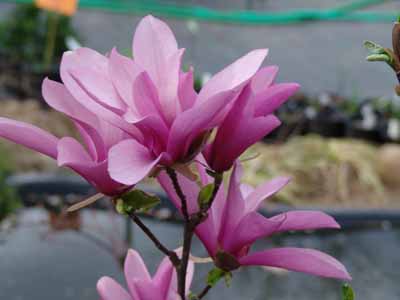
Magnolia 'Betty'
Magnolia
For a spectacular and colorful introduction to summer, the Betty Magnolia cannot be beaten.When the blooms subside, the foliage will begin to emerge with a coppery hue and then transition to a deep forest green
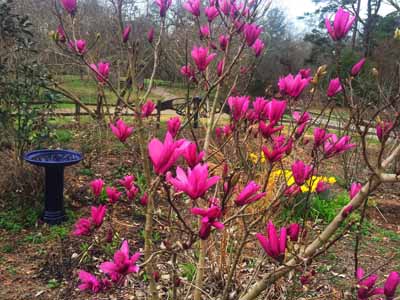
Magnolia 'Jane'
Magnolia
, deliciously fragrant flowers in late April before leaves appear. Rich purple exteriors frame bright white centers on this bloom not only in spring, but all summer long and even into the fall as 'Jane' will surprise you with her charming ways and spontaneous small bursts of blooms even in the off season
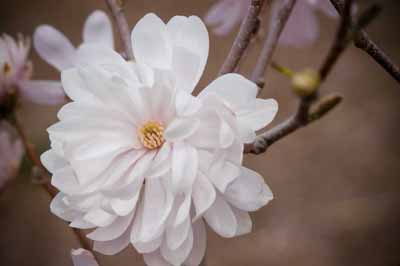
Magnolia stella 'Centennial Blush'
Magnolia
Pink buds open to incredibly full and wonderfully fragrant pale pink flowers in spring. Centennial Blush is a prolific bloomer with flower buds formed at almost every node yielding a fantastic floral display of delicate pink covering the entire plant.

Magnolia virginiana
Sweetbay Magnolia
Native to North America, creamy white flowers appear in late spring followed by red cone shaped fruit in the fall. Immature plants may take a few years to bloom but once established they will bloom prolifically. Moderate growth rate of 1-2 ft per year. Also known as swamp magnolia, they prefer wet soil.

Malus 4 in 1 Cold Climate
4 in 1 Apple
4-in-1 cold climate apple is created from grafting from an assorted selection of cold climate hardy apples. These are the varieties that are used in the grafting: Gravenstein, Red Delicious, Red McIntosh, Yellow Delicious
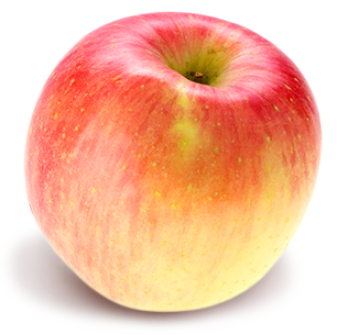
Malus 'Fuji'
Fuji Apple
One of the best home-grown apples, Fuji offers super crisp, sweet, and juicy fruit with skin that ranges from yellow-green with red highlights to mostly red. Exceptional for fresh eating. Stores well; great for baking. Ripens iin October.
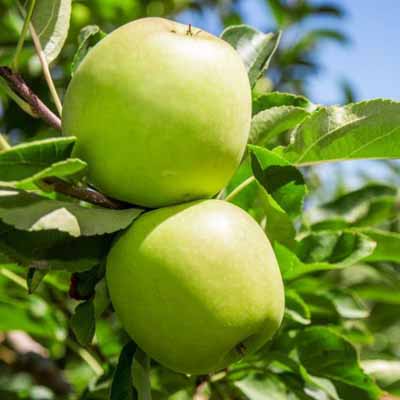
Malus 'Granny Smith'
Granny Smith Apple
One of the best cooking apples, Granny Smith has crisp, tart and juicy fruit with a good balance of acids and sugars. Medium-sized apple.

Malus 'Honeycrisp'
Apple Tree
Great for taste and even better for storage, this sweet - flavored late season selection retains its crispness even after seven months of storage! 'Honeycrisp' is not only becoming an orchard favorite, it's becoming a must have tree for the home gardener. This variety requires a different selection of the same species growing nearby in order to set fruit.
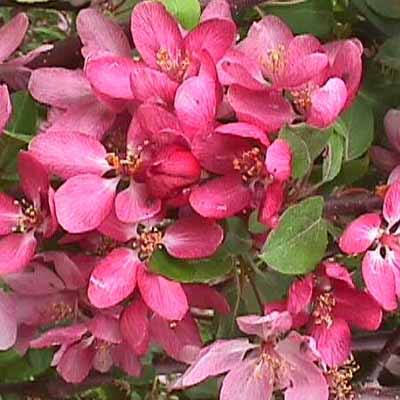
Malus 'Indian Magic'
Crabapple
A showy tree that has buds which open to pink, single flowers in spring. The foliage is dark green and develops an open, round shape. Indian Magic produces red fruit turning to orange. Matures 15 to 20 feet tall and wide. Very disease resistant.
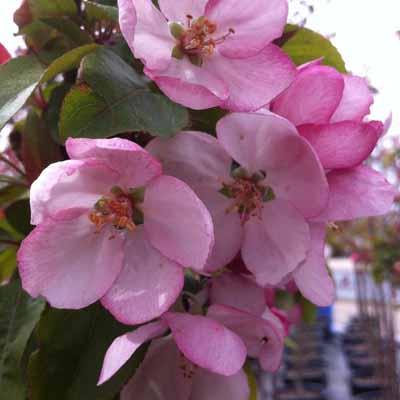
Malus 'Indian Summer'
Crabapple
Crimson buds open to single deep pink flowers before the leaves emerge. Medium red crabapples form after blooming. Foliage turns orange red in the fall.
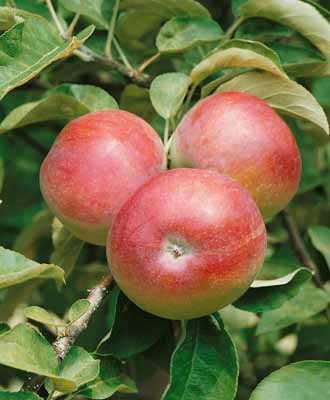
Malus 'McIntosh'
Semi-Dwarf McIntosh Apple
A very productive tree which yields medium-sized, bright red fruit with green background. With a tender, thin skin, these apples are good for fresh eating or cooking.
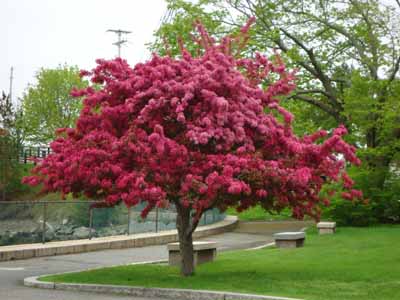
Malus 'Prairie Fire'
Malus 'Prairie Fire'
An outstanding flowering tree with an upright form that becomes rounded with age. Reddish new foliage matures to a dark green. Lovely deep pink spring flowers produce persistent, small, dark red-purple fruit. A colorful accent for smaller landscapes

Malus 'Profusion'
Crabapple
Worthy of its name, this stunning accent tree features showy red flowers in spring and colorful deep red fruit in fall, spreading habit of growth with dark foliage; a very artistic tree for larger landscapes, needs well-drained soil and full sun
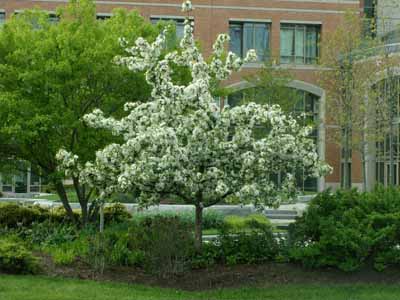
Malus 'Snowdrift'
Snowdrift Crabapple
This compact, rounded beauty bursts into color in early May from red buds that open to white flowers. Adds interest to the landscape all season with spring blooms, nice foliage and summer to fall fruit that persist on the tree and attract birds. Low maintenance and easy to grow. Great for smaller spaces.
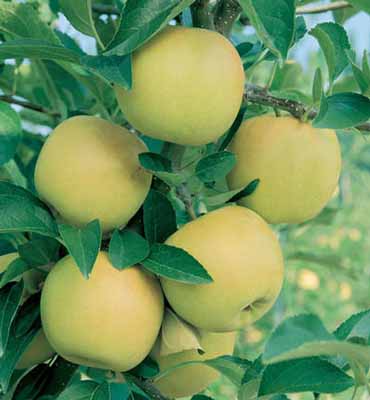
Malus 'Yellow Delicious'
Apple Tree
Pink buds open to white flowers in the spring and by September and October the golden yellow skin fruit begins to ripen. Sweet, full of flavor eaten fresh and in desserts. Excellent pollinator for other apples trees blooming at the same time.
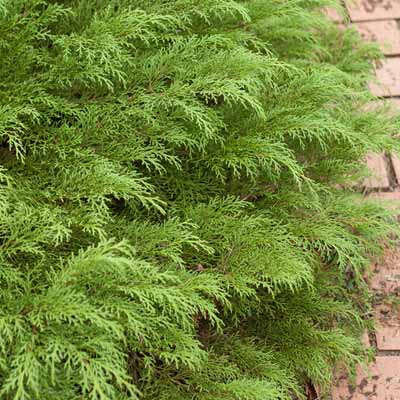
Microbiota 'Celtic Pride'
Siberian Cypress
Looking for an evergreen groundcover with delicate good looks but tough-as-nails performance? Try Celtic Pride Siberian cypress. Its pretty fern-like foliage belies its durable nature. This plant is super hardy (down to USDA zone 2), tolerates light shade, tolerates dry conditions, and is untouched by deer. In winter, the plant takes on a russet-purple tone. Celtic Pride microbiota was selected for its uniform growth and resistance to the tip dieback that often plagues conventional varieties.

Microbiota decussata
Russian Cypress
One of the best groundcover conifers available! Very hardy with a soft, feathery touchable foliage, this selection does great in sun or shade and has a striking bronze fall color.

Miscanthus sinensis 'Adagio'
Dwarf Maiden Grass
An ornamental grass with attitude, the Adagio is one of the showiest dwarf Miscanthus available. This superior form of dwarf maiden grass is finely textured, with narrow silver - gray foliage and flowers that emerge pink and turn white in August. They can be left uncut for winter interest.

Miscanthus sinensis 'Gracillimus'
Maiden or Zebra Grass
Gracillimus' forms a dense clump of gracefully arching narrow leaves. Does well in masses or as a specimen. Coppery flowers appear in October. Also looks great near a pond! Maiden Grass requires a location in the landscape that receives full sun, but can tolerate partial shade.
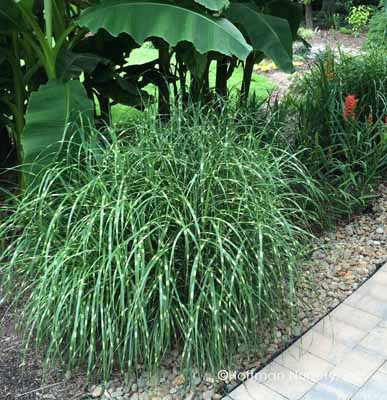
Miscanthus sinensis 'Little Zebra'
Little Zebra Grass
Graceful, arching blades with eye-catching ivory to yellow highlights. Tall, upright flower stems topped with feathery, silver-white, summer plumes that soften and curl as they dr

Miscanthus sinensis 'Morning Light'
Maiden or Zebra Grass
Morning Light' has leaves that have a narrow band of clear white on the leaf margins, causing them to appear silver from a distance. They are clump forming plants with reed - like stems and leaves that are narrow and arch to the ground. The foliage grows 4 to 5 feet tall, with flowers 5 to 6 feet tall. The flowers emerge a reddish - bronze color and dry to a fluffy cream
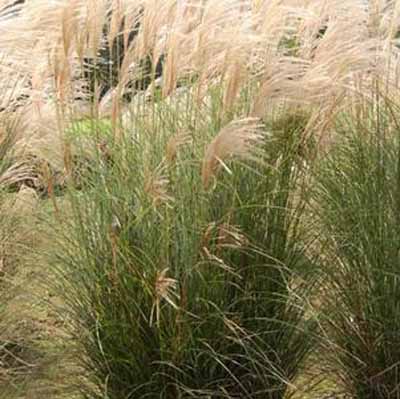
Miscanthus sinensis 'Scout'
Maiden Grass
Long, slender, green blades with white midribs that take on spectacular fall color reach up to 6' by the end of summer to be topped off with fluffy, pink to beige flowers. Scout is an infertile variety from the University of Georgia. Plant in full sun to part shade. Cut back in late winter close to ground; if needed, divide in early spring before new growth emerges. Fertilize in early spring with organic fertilizer.

Miscanthus sinensis 'Silberfeder'
Maiden Grass
Large, feathery seed heads rise high above the foliage. Deep-green foliage has a distinct silver midrib and a gracefully arching shape. Ranks as more cold hardy than most of the Miscanthus species. Prefers well-draining soil.
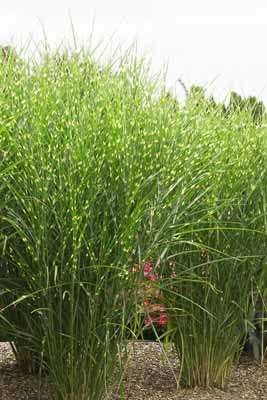
Miscanthus sinensis 'Strictus'
Porcupine Grass
A more upright form to this improved habit; not as relaxed and vase-shaped as 'Zebrinus'. Green foliage is highlighted by dramatic horizontal golden bands. Reddish bronze plumes rise above the foliage in summer. Works well for use as a single specimen or in groupings.

Miscanthus Sinensis 'Variegatus'
Variegated Japanese Silver Grass
Variegatus' has an arching growth habit and can reach 4 - 6' in height with an equal spread. The leaves are 1/4" wide and pale green with creamy white stripes. Too much sun can burn the foliage. 'Variegatus' will bloom late summer with 1 - 2' plume like flowers.
.jpg)
Miscanthus sinensis 'Zebrinus'
Zebra Grass
Pinkish copper tassel-like flowers appear in late summer turning to silvery white showy plumes. Tan winter foliage and white plumes persist for pleasing winter interest
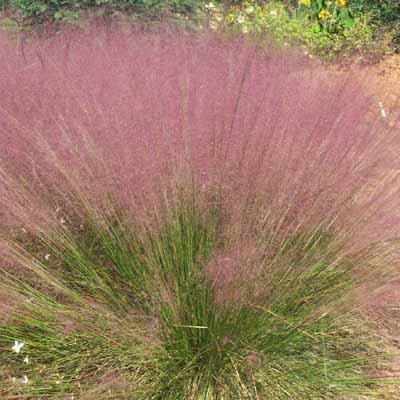
Muhlenbergia capillaris var. filipes
Coastal Muhly Grass
Masses of tall, delicate flower panicles create a vibrant rosy red haze over the fine textured, grassy leaves and are attractive through the winter. Superior groundcover when massed with shrubs and trees.
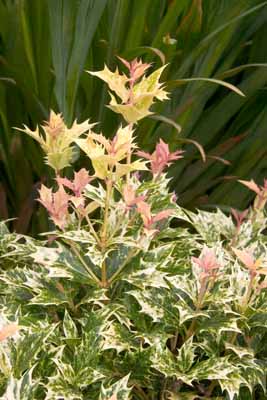
Osmanthus heterophyllus 'Goshiki'
Goshiki False Holly
Goshiki translates from Japanese as "five colors". Its new leaves emerge red and quickly turn green. The green leaves are daubed with spots of creamy white, gray-green, and yellow-green. This lovely evergreen selection makes a great accent.
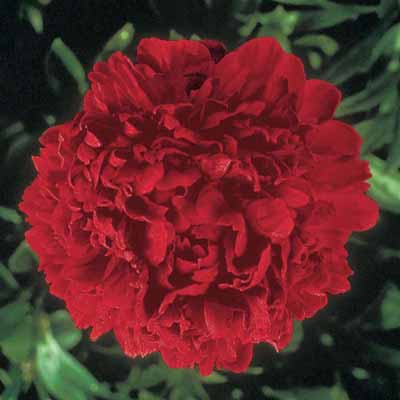
Paeonia 'Double Red'
Peony
Giant double peonies are hardy, fragrant, long-lived, and rarely need dividing. As a bonus, they're superior as cut flowers...it's no wonder peonies are considered "The Queen of Garden Flowers!" Great as focal points in a perennial bed, for hedges or in a spot of their own. Very low care and high performance.
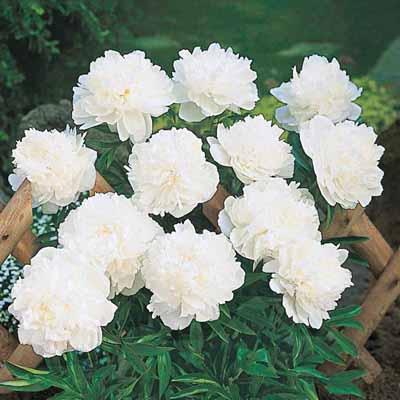
Paeonia 'Double White'
Peony
Giant double peonies are hardy, fragrant, long-lived, and rarely need dividing. As a bonus, they're superior as cut flowers...it's no wonder peonies are considered "The Queen of Garden Flowers!" Great as focal points in a perennial bed, for hedges or in a spot of their own. Very low care and high performance.
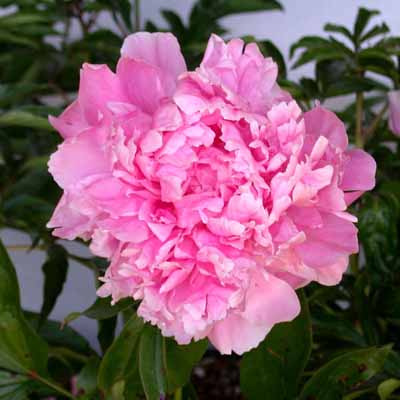
Paeonia 'Dr. Alexander Fleming'
Peony
Fragrant, fully double, pink blossoms abound in early summer. The central petals have a tendency to curl inward, giving the flowers a sphere-like shape. Many side buds are produced, extending the bloom time.

Paeonia 'Duchesse de Nemours'
Peony
This plant has stood the test of time for over 150 years and is still one of the better selections out there. It's hard to beat it when it comes into bloom in mid June above deep green foliage with fat, double, full, fantastic, fragrant pure white flowers with a touch of cream in the middle. Wow indeed!
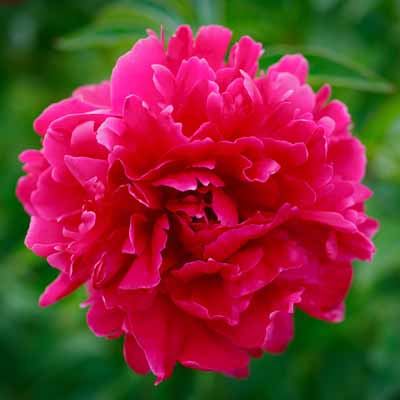
Paeonia 'Kansas'
Peony
Huge, double, carmine red blooms are displayed on the bold, erect stems of this clumping perennial.

Paeonia 'Karl Rosenfield'
Peony
Large, red, double blooms are spectacularly displayed on sturdy, erect stems emerging from beautiful, lush, green foliage on a rounded form. A truly exquisite cut flower.
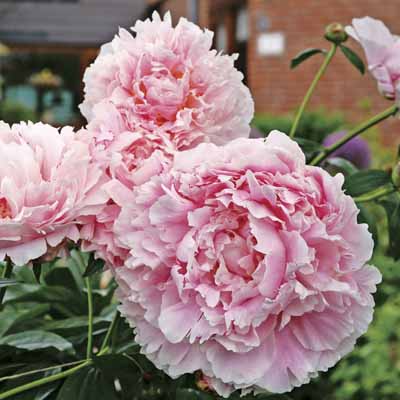
Paeonia 'Sarah Bernhardt'
Peony
Absolutely stunning, with huge, fully double, fresh pink blooms are backed by a lush mound of glossy green, deer resistant foliage.
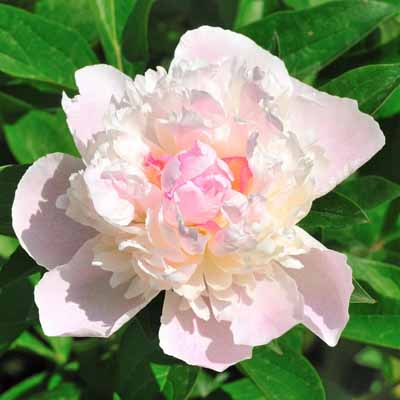
Paeonia 'Shirley Temple'
Peony
Huge, fully double, white blooms with a hint of rose coloring are backed by a lush mound of glossy green, deer resistant foliage. A classic for cut flower arrangements
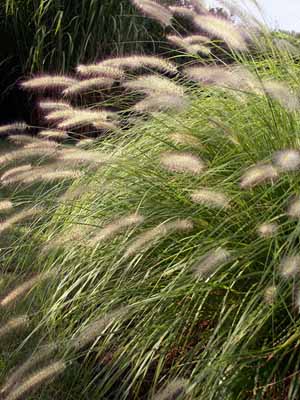
Pennisetum alopecuroides 'Hameln'
Dwarf Fountain Grass
A slender arching grass with graceful puffy plumes of reddish flower from August to October. 'Hameln' has all the beauty of the larger form condensed to a compact size. Wonderful for the smaller garden. Considered deer resistant and drought tolerant once established.
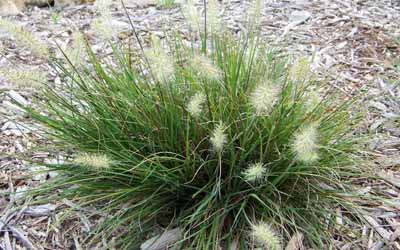
Pennisetum alopecuroides 'Little Bunny'
Dwarf Fountain Grass
The most dwarf of the fountain grasses with fluffy, buff-colored blooms. Terrific contrast for use in rock gardens, borders, foundation plantings, or in perennial beds. Foliage turns golden russet in fall

Pennisetum orientale 'Karley Rose'
Oriental Fountain Grass
Uniform, upright clumps of gracefully arching, deep green foliage erupt into soft rose-purple plumes from early summer until frost. Enjoy its subtle straw color in the winter. Drought tolerant. Deer resistant.

Philadelphus 'Illuminati Tower'
Mockorange
Mockorange is a delightfully old-fashioned plant that has unfortunately fallen out of favor, mostly due to its enormous size. Illuminati Tower mockorange stands to breathe new life into this classic favorite, though, combining a landscape-friendly size with a totally unique space-saving habit. It naturally grows in a very narrow, upright way, each sturdy stem a stack of rugged, deep green leaves that looks like a four-sided tower. In late spring/early summer, hundreds of fragrant white flowers emerge from between the leaves for striking show that truly celebrates the season. Illuminati Tower mockorange will need little pruning - it blooms on old wood, so any pruning you do wish to do should be done after flowering. Deer resistant. Drought tolerant.
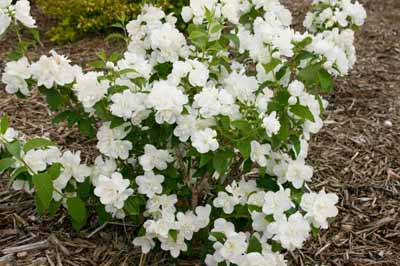
Philadelphus 'Snow White'
Mockorange
Pure white, deliciously fragrant 2" double flowers bloom late spring and again in late summer. Snow White is very useful as a backdrop for roses or perennials, and has exceptional dark green foliage that stands up to summer heat.

Philadelphus 'Snowbelle'
Mockorange
Extra useful, thanks to its compact, low growing habit, 'Snowbelle' mockorange is loaded with fragrant, double white flowers in spring.
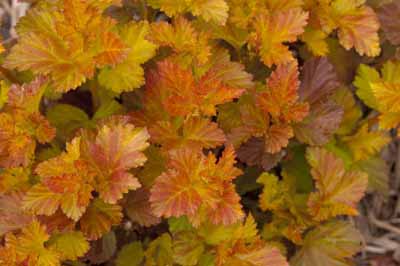
Physocarpus 'Amber Jubilee'
Ninebark
Rounded and dense in habit with a bold array of colors in glowing tones of orange, yellow and gold, Amber Jubilee stands out in the garden border or makes an eye-catching hedge. Clusters of delicate white blooms in spring and fall add extra interest. Plant in full sun for best performance.
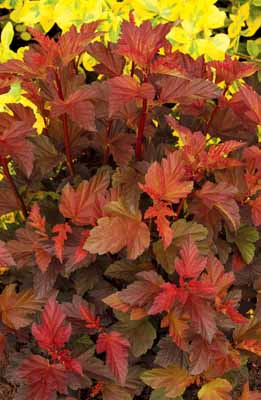
Physocarpus 'Coppertina'
Ninebark
Coppery-orange foliage all season long. White flowers in early summer. Adaptable. Easy to grow. Native. Adaptable to difficult situations. Withstands acidic and alkaline soils. Medium moisture, can tolerate dry conditions once established. Best if pruned immediately after blooming. Best in open areas with good air circulation to prevent foliage problems. Will benefit from a good hard pruning as a young plant. Fertilize in early spring by applying a slow release fertilizer specialized for trees and shrubs.
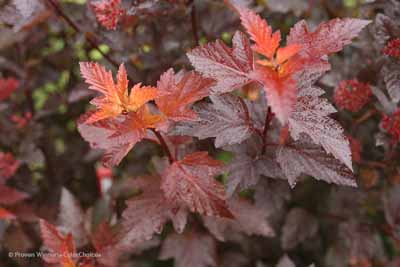
Physocarpus 'Ginger Wine'
Ninebark
Spring to autumn color, without lifting a finger! Ginger Wine ninebark expands the color palette for these easy care, native flowering shrubs. Spring foliage emerges a sunny orange color and matures to sparkling burgundy. Clusters of white flowers cover the plant in late spring, and these age to attractive red seed heads. This disease-resistant shrub does best in full sun locations and cooler climates.
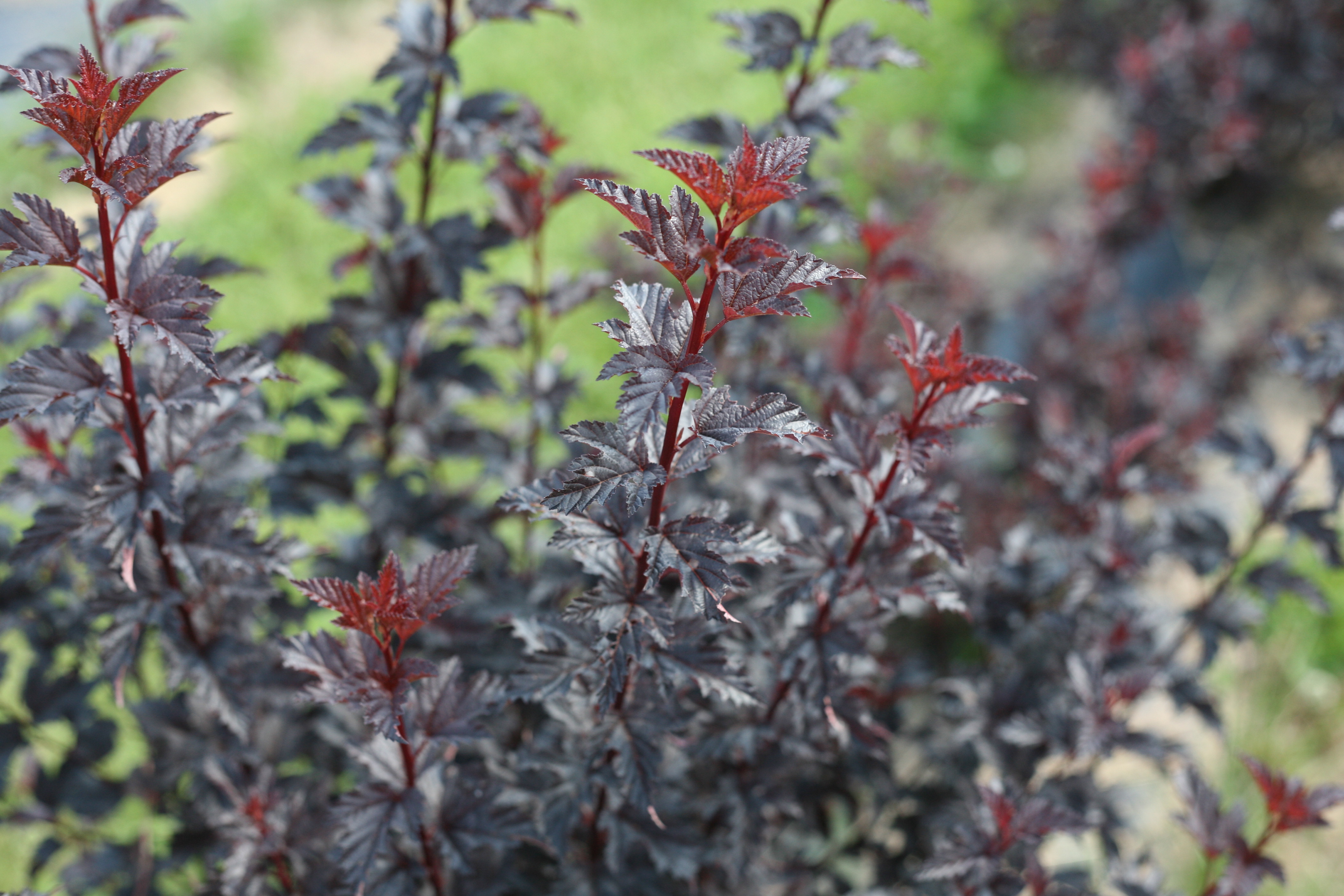
Physocarpus 'Summer Wine Black'
Ninebark
Ninebark, that is - because Summer Wine Black has the darkest, most dramatic foliage yet. With its rich, saturated color and versatile habit, it's the ideal choice for accentuating your home's exterior. Spring brings white flower clusters to contrast with the nearly-black foliage. Upright stems and small foliage gives a fine textural effect. Ninebark is a versatile landscape, but should be sited in full sun with plenty of space around it and good air circulation to avoid any leaf problems. Ninebark is best left unpruned, except for removing any heavy old wood every few years or so. Avoid trimming it back, which will cause it to branch out and distract from its naturally elegant habit. Plant only in full sun.
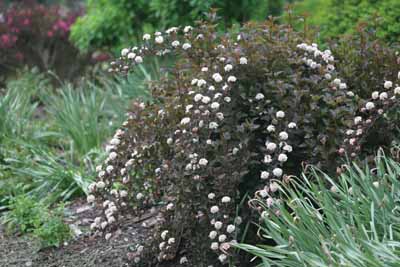
Physocarpus 'Summer Wine'
Ninebark
A striking plant with deep reddish - purple foliage that keeps a dense rounded form that is the perfect size for most landscapes. Its graceful, arching habit makes if very appealing in the landscape. The pure white button - like flowers that form in late May and early June are a perfect contrast to the deep colored foliage. Bark on older plants peels into papery - like strips. This plant loves full sun and tolerates poor soils and extreme cold.
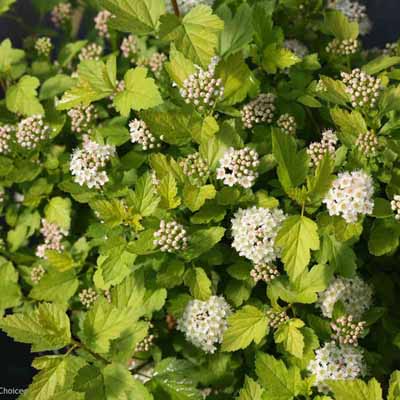
Physocarpus 'Tiny Wine Gold'
Ninebark
Gold new growth for bright landscaping! Tiny Wine Gold offers brilliant yellow new growth, small, refined foliage, and dozens of clusters of white-pink flowers in late spring. A bit smaller than your average ninebark, it's a colorful, easy-care choice for perennial gardens, foundation plantings, and other landscape features. Disease resistant and native to North America. All ninebarks are best left unpruned, as they naturally take on a graceful, appealing habit. If you'd like to prune your plant, do so after it flowers. Plant in full sun; ninebarks are drought tolerant once they are established.
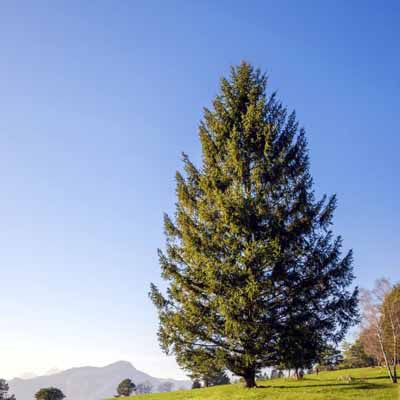
Picea abies
Norway Spruce
Norway spruce is a large, fast-growing evergreen coniferous tree that grows to mature heights of 115 to 180 feet (35 55 m) tall with a trunk up to 3 to 5 feet (1 - 1.5 m) in diameter, measured at breast height. It is fast growing when young, up to 3 feet (1 m) per year for the first 25 years under good conditions, but becomes slower once over 60 feet (20 m) tall.
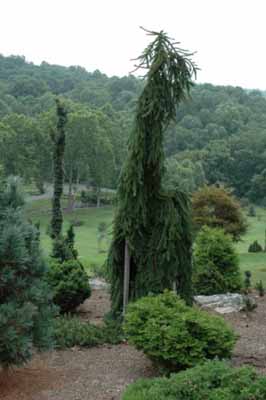
Picea abies 'Frohburg'
Weeping Norway Spruce
Picea abies 'Frohburg' is a vigorous, weeping selection of Norway spruce with strictly weeping, limp side branches and glossy dark-green needles. Older plants will form an impressive wide "skirt" at the plant base. Young plants must be staked to their desired height. From their highest staked point, all further growth will be downward and then out. Terminal branches will increase at an annual rate of 8 to 12 inches
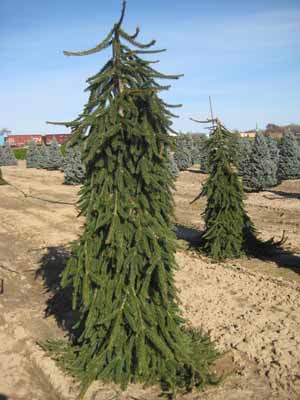
Picea abies 'Pendula'
Weeping Norway Spruce
A choice evergreen with a naturally low growing form composed of weeping branches that trail outward, densely blanketed with rich green needles
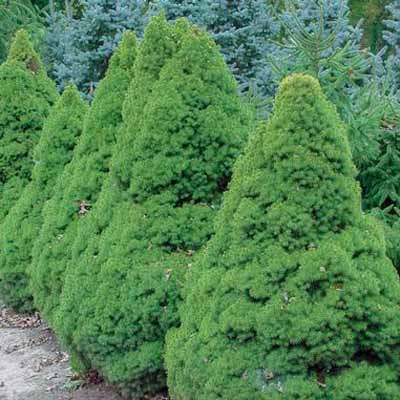
Picea glauca 'Conica'
Dwarf Alberta Spruce
A compact, pyramidal spruce that is very slow - growing. It is widely used in the landscape because of its low maintenance, slow growth habit and rugged dependability.
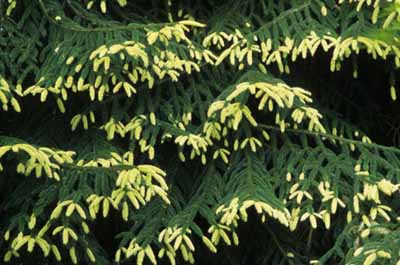
Picea orientalis 'Aureospicata'
Golden Caucasian Spruce
This medium to large form of the Oriental Spruce has dramatic bright gold new growth in the spring, making it a spectacular specimen. The bright colored foliage slowly turns to a medium by late summer. The narrow stature tree will reach 15-20 ft tall in 10 or more years. Reddish-purple cones are produced in late spring that add to the ornamental quality of this tree. A great specimen tree for any yard.
.jpg)
Picea pungens 'Glauca'
Colorado Blue Spruce
This very popular conifer has a handsome pyramidal form with rigid tiered branches densely covered with stiff gray-blue needles. Use as an evergreen windbreak or tall screen, or as a specimen plant in large landscapes.
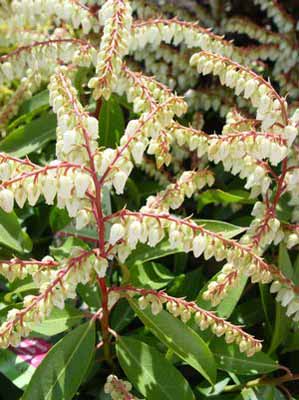
Pieris japonica 'Brouwer's Beauty'
Andromeda
Dense, compact habit. New growth foliage is yellowish green turning dark green and shiny. Purplish red winter forming buds open to white slightly fragrant flowers in April. With its attractive foliage, showy blooms, hardiness, and resistance to deer, 'Brouwer's Beauty' is an excellent addition to partially shaded areas of the garden..
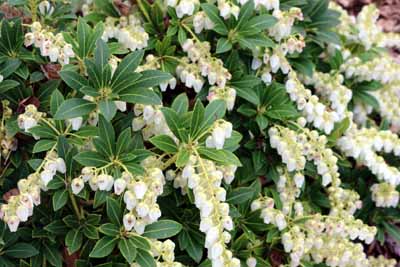
Pieris japonica 'Cavatine'
Cavatine Dwarf Pieris
An exquisite dwarf variety reaching just 2 feet tall in ten years. Numerous green buds open to white bell-shaped flowers in early spring. Lustrous, dark green foliage cloaks the compact, rounded form. Useful in the front of shrub borders.
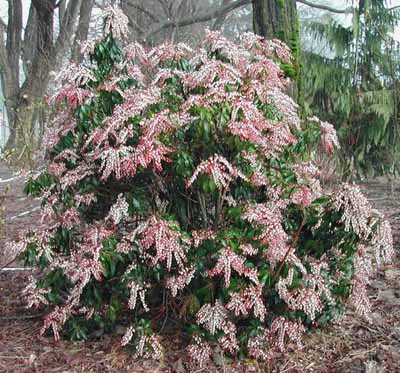
Pieris japonica 'Dorothy Wycoff'
Andromeda
Vigorous, upright growing, somewhat more compact than the species. Glossy dark green foliage turns mahogany - red in winter. Very dark red winter flower buds open to fragrant white flowers with a touch of pink in April. Reddish bronze new growth turns green at maturity. Arching clusters of brown seedpods in fall and winter.
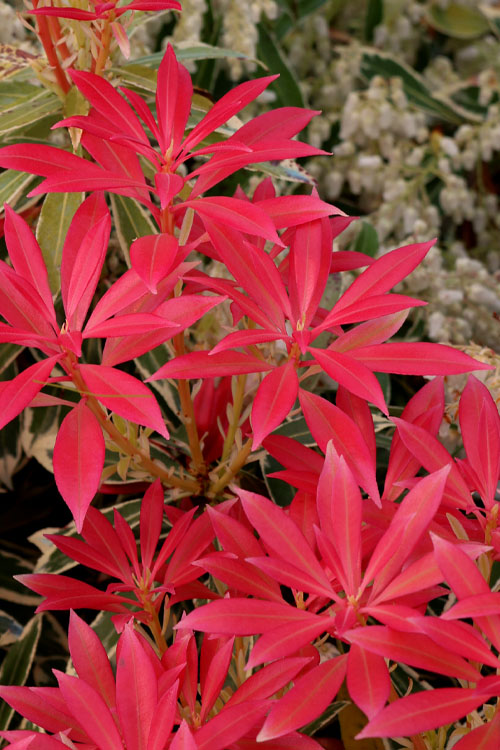
Pieris japonica 'Fire N Ice'
Andromeda
Compact, upright evergreen with glossy green and white foliage. Stem-ending flower buds are white and fragrant. Shade tolerant. Deer resistant.
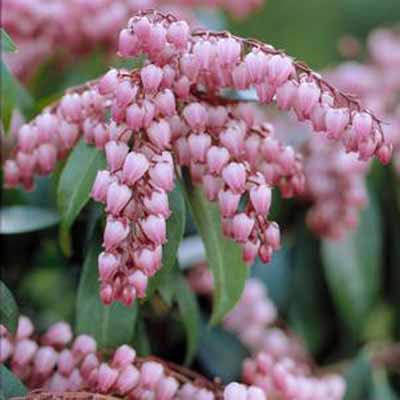
Pieris japonica 'Katsura'
Andromeda
Make your landscape memorable year round with this amazing broadleaf evergreen. 'Katsura' cloaks its dense, rounded form with wide, shiny, deep green foliage and each stem is topped with a string of buds in early spring. The buds open in April to reveal scented white Lily of the Valley bells infused with pink followed by a spectacular show of wine red color on emerging new foliage in May!

Pieris japonica 'Mountain Fire'
Andromeda
Brilliant red new growth in mid - May makes for a stunning landscape feature. Slightly more upright than spreading, this deer - resistant plant is a dependable late March to mid - April bloomer with typical white Pieris flowers.

Pieris japonica 'Prelude'
Prelude Pieris
A useful dwarf selection that flowers later than other varieties. Lovely clusters of pure white flowers on short stalks shine against rich, dark green foliage on a densely branched globe shaped form. New leaves emerges with a pinkish tint
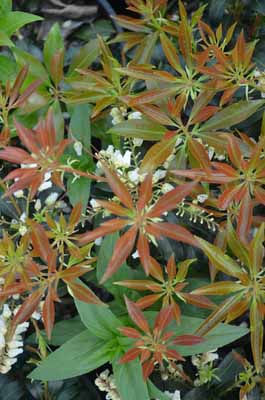
Pieris japonica 'Scarlet O'Hara'
Andromeda
Cascading panicles of lightly fragrant, white flowers emerge early spring. New leaves are bright red maturing to glossy green.
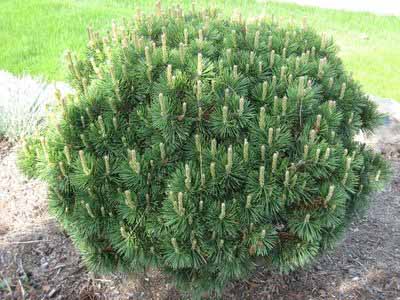
Pinus mugo 'Mughus'
Mugho Pine
Texture and touchability make this durable, slow growing conifer extremely popular. Easy to grow and easy to use, both singly or in groups in the landscape.
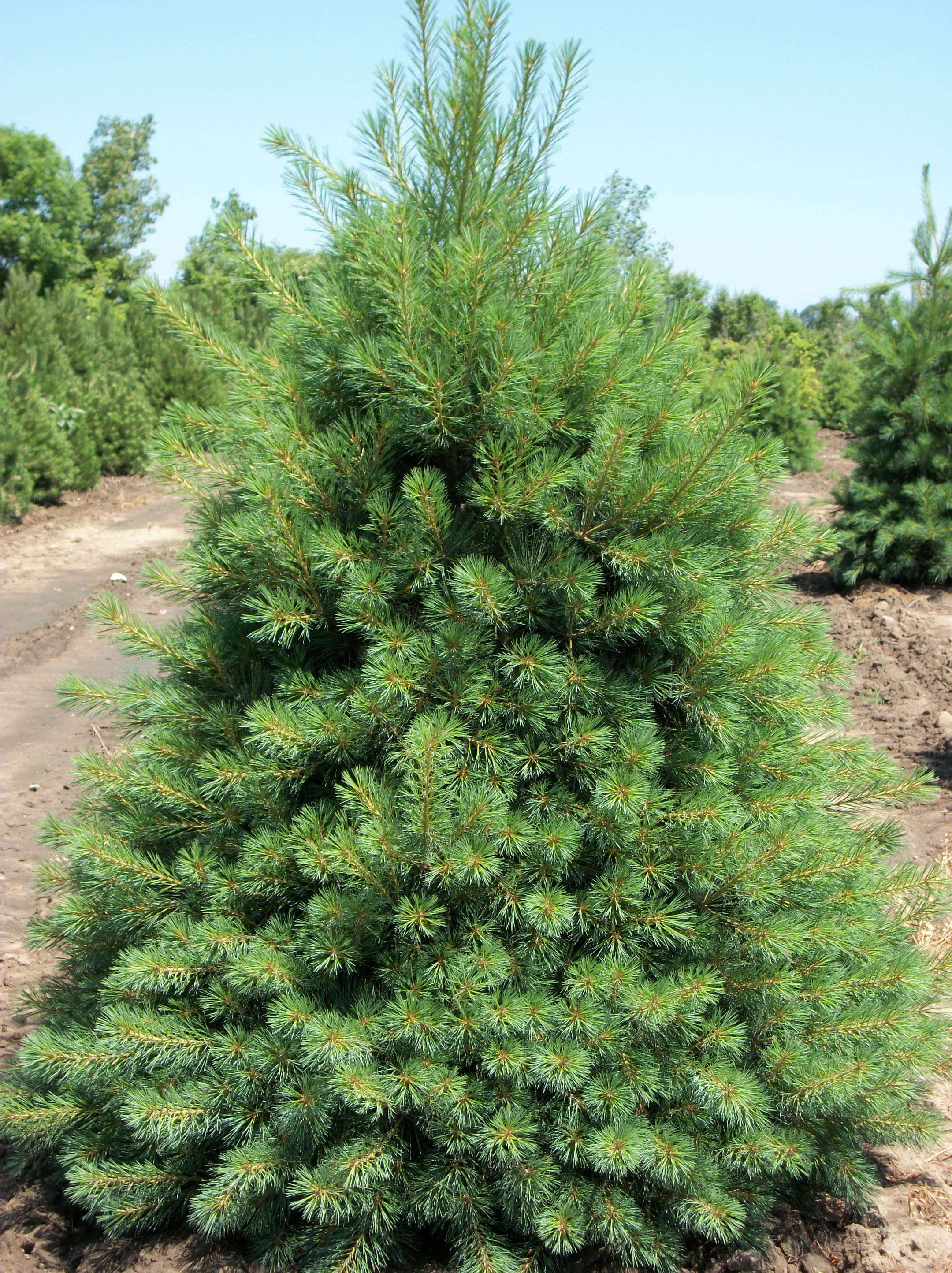
Pinus strobus
Eastern White Pine
An extremely useful, fast growing pine perfect for windbreaks and tall screens.A rugged evergreen that adapts well to poor soils.
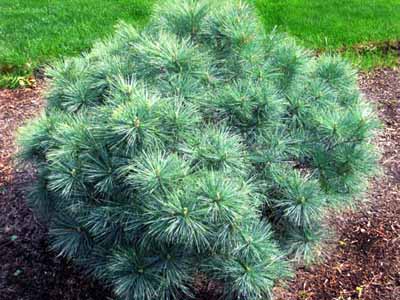
Pinus strobus 'Blue Shag'
Blue Shag Pine
This easy-care conifer has a dense, dwarf habit with short, blue-green needles that are soft to the touch. Adaptable to a wide range of soil conditions and effective in rock gardens, shrub borders or as a small garden specimen
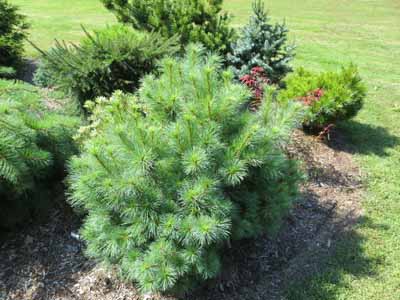
Pinus strobus 'Connecticut Slate'
Dwarf White Pine
Another introduction of the late Dr. Sydney Waxman of the University of Connecticut, 'Connecticut Slate' is a dense, spreading, quicker growing Dwarf White Pine that feautures gray-blue colored needles that make it stand out from the many other varieties on the market currently. The medium length, slate colored needles are tightly packed along the stems giving 'Connecticut Slate' a full appearance even though it is not as tightly dwarf as other types. It's a great plant for a border area, thriving in full sun or partial shade, and it makes a beautiful specimen for a larger foundation area with color and form that is truly memorable.
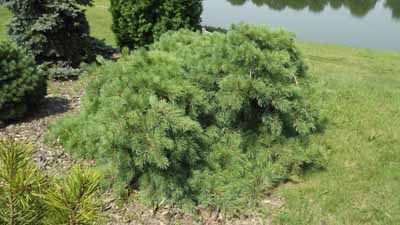
Pinus strobus 'Shaggy Dog'
White Pine
Famous for his groundbreaking work with dwarf White Pines from witch's brooms, the late Sid Waxman from the University of Connecticut introduced this low, irregular, half-upright spreader with long needled, unruly branches in 1993. This new favorite breaks the mold of many of his dense, tight, inpenetrable selections to give us a more open, highly textured plant that is more relaxed, free-form and airy. This sweet textured beauty is perfect for a large location where it can look its 'Shaggy Dog' best, anchoring any sunny, well drained location by growing into a spectacularly different, year round beautiful specimen.
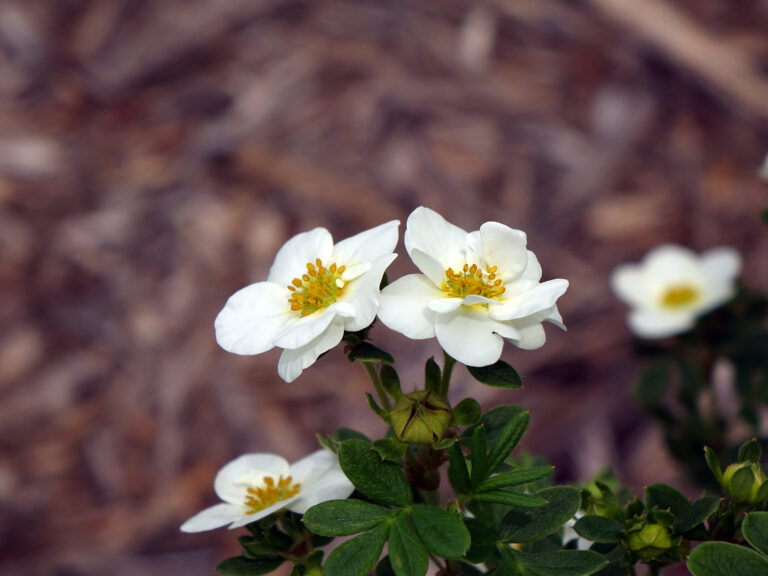
Potentilla 'Creme Brulee'
Potentilla
Add a pop of white to the landscape with this double flowered potentilla. Cr me Brulee showcases bright white blooms on a rounded shrub throughout the entire summer. Its dark green foliage contrasts beautifully with the flowers and its rock-solid performance necessitates little maintenance.
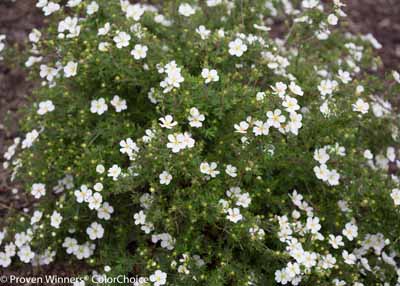
Potentilla 'Happy Face White'
Potentilla
Extra large, pure white flowers adorn this plant from spring to late summer. Happy Face White potentilla has a dense habit with dark green foliage. Excellent for mass plantings and commercial landscapes. Salt tolerant. Deer resistant. Native to North America.
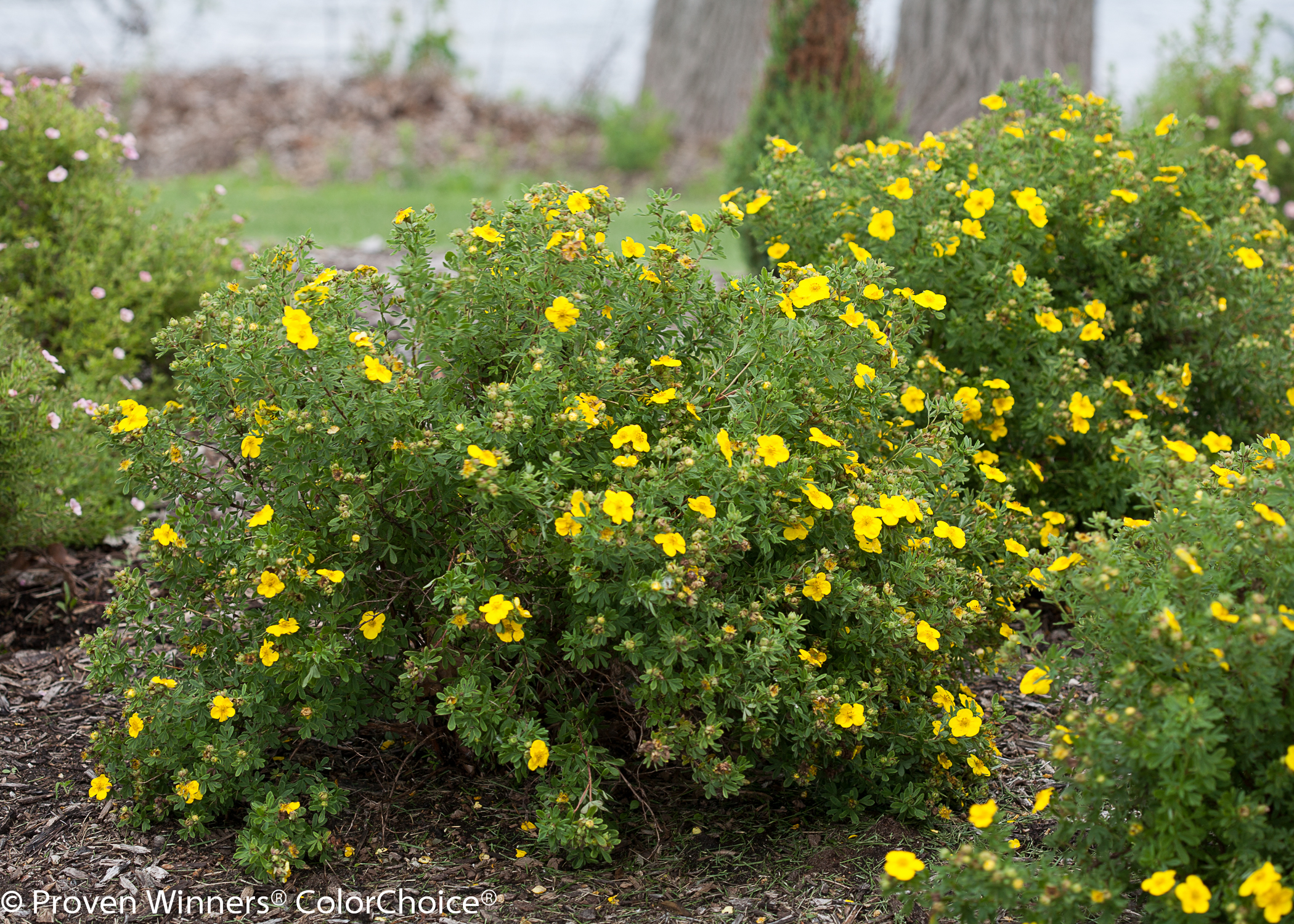
Potentilla 'Happy Face Yellow'
Potentilla
Big, bright flowers make this potentilla anything but dull! Happy Face Yellow potentilla offers extra-large bright yellow flowers, and lots of them. Blooming non-stop from spring to frost, this super durable plant will put a smile on your face. Needs little maintenance and is highly deer resistant. Native to North America. Prefers moist, well drained soils but will tolerate poor, dry conditions once established. Prune off one third of the branches in late winter to keep the habit full and attractive.
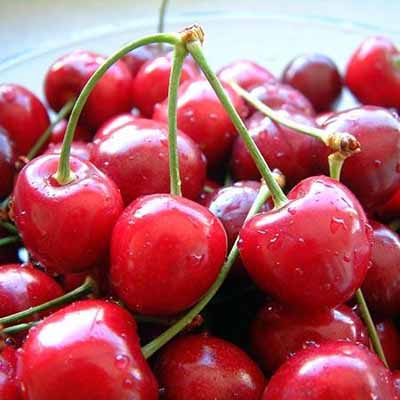
Prunus 'Montmorency'
Tart Cherry Tree
The most widely grown 'sour' or 'pie' cherry, this vigorous cherry is a heavy spring bloomer with clouds of small white, fragrant flowers followed by tons of sizable cherries which mature in July and August. Great for pies and jams. This tree is a self - pollinator.

Prunus 'Redhaven'
Peach Tree
The Redhaven Peach is the peach by which all others are measured. Its a heavy - bearing, cold - hardy, and resists leaf spot, and the July fruit is spectacular. You'll enjoy bushels of big, luscious peaches that have an almost fuzzless skin over firm, creamy yellow flesh. Fruit is medium to large size and is just right for fresh snacks, canning or freezing. Disease resistant and self - fertile.

Prunus 'Snow Fountain'
Weeping Cherry
Magnificent specimen tree will make your neighbors green with envy. It has the appearance of a fountain of snow when covered with snow white blooms in late April. It is drought and heat tolerant, with clean, dark green, disease - tolerant foliage that turns golden to orange/red in the fall. Wit all this, 'Snow Fountain' could possibly be considered the ultimate in ornamental flowering trees.

Prunus 'Stella'
Sweet Cherry Tree
Large, heart - shaped, dark red fruit are produced on this self - pollinating sweet cherry. Sweet, rich flavor on a vigorous, productive tree make this an excellent choice. Moderate crack resistance. Can pollinate other sweet cherries.
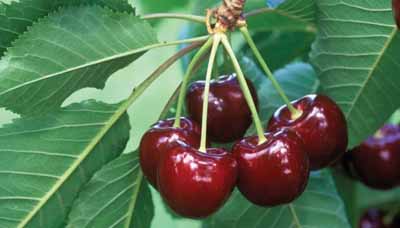
Prunus avium 'Bing'
Sweet Cherry Tree
The most popular sweet cherry variety, known for producing exceptionally large, dark mahogany fruit that is firm, sweet and juicy. Excellent for eating fresh, canning or preserves. Plant a pollenizer such as Stella or Rainier for best production.
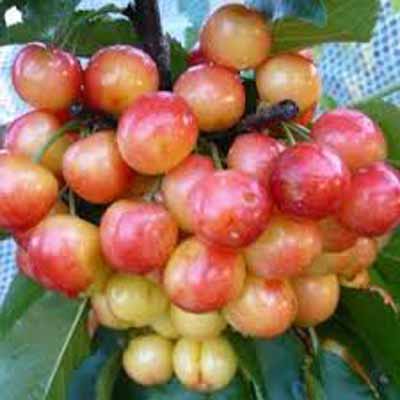
Prunus avium 'Rainier'
Sweet Cherry Tree
Rainier' is a cross between 'Bing' and 'Van', two sweet-red varieties, creating a very vigorous, productive tree for the backyard orchard.a premium quality Cherry that resists cracking while ripening, producing a medium to large sized fruit with red skin blushed yellow. Enjoy the fruit fresh from the tree, canned or even dried for a tasty sweet snack
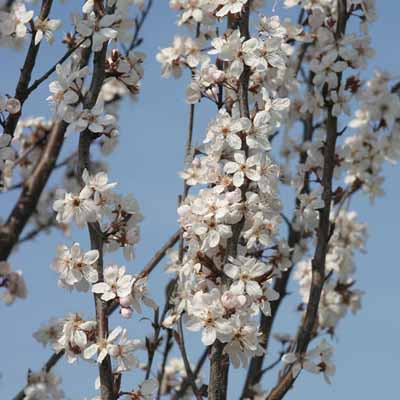
Prunus cerasifera 'Crimson Pointe'
Flowering Plum
This unique narrow tree with a strongly columnar shape is the perfect specimen for smaller landscapes or massed to line expansive drives. White flowers in early spring are followed by showy, glossy, bronze-to-maroon foliage. Produces small ornamental fruit in summer. Deciduous.
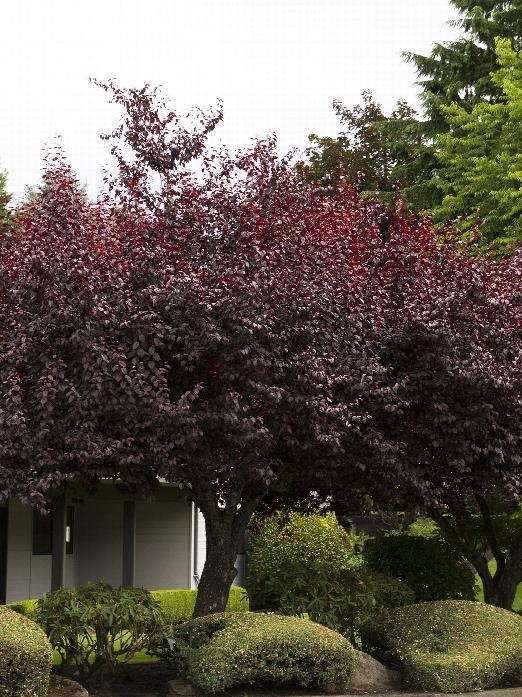
Prunus cerasifera 'Krauter Vesuvius'
Flowering Plum
This remarkable tree is perhaps the most colorful of all flowering plums! Beautiful dark purple-black summer foliage is preceded by a profusion of showy light pink flowers in spring. A phenomenal ornamental accent for landscapes that seldom produces fruit. Deciduous.
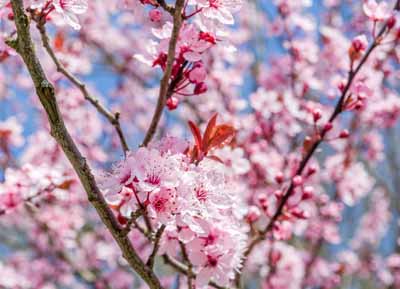
Prunus cerasifera 'Thundercloud'
Flowering Plum
Great summer interest is provided by deep purple foliage on this small specimen tree. Small pink flowers line the branches in early May before foliage emerges. Tolerates sandier soils.

Prunus cistena
Sandcherry
A very tolerant plant with intense purple - red foliage that shows stunningly throughout the summer. Small, single pink flowers line the branches before foliage flushes in late April and are very effective. Good plant for hedging, borders, or as an accent, it thrives in poor sandy soils.
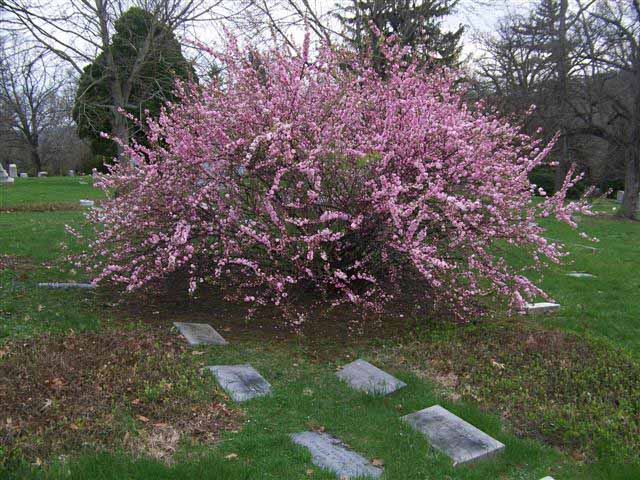
Prunus glandulosa 'Rosea'
Flowering Almond
The Pink Flowering Almond is a small shrub that flowers in early spring when an almost solid mass of petite, ruffled double - pink blooms cover each and every branch before the leaves appear. It grows best in light shade to full sun. It prefers a well drained light garden soil. Very hardy over a wide range. Adaptable to most soil types and moisture levels. Blossoms are double pink and prolific.
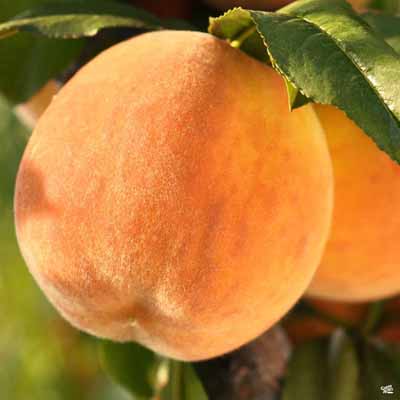
Prunus persica 'Elberta'
Dwarf Elberta Peach
Semi-dwarf. This spreading tree produces large, firm peaches ripening late August. Golden yellow blushed with red. A freestone peach that is self-fertile and resistant to brown rot.
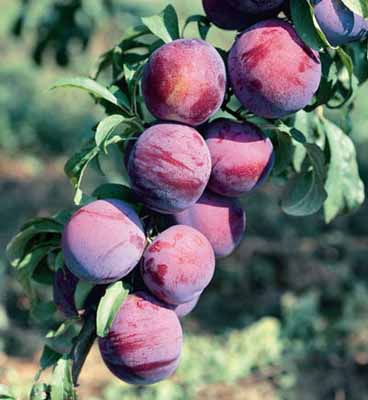
Prunus salicina 'Burbank'
Plum Tree
A semi-dwarf variety with a flat topped habit that produces an abundance of sweet and juicy fruit suitable for canning, baking, desserts or eating fresh. Will pollinate with Satsuma plum.

Prunus salicina 'Santa Rosa'
Semi-Dwarf Santa Rosa Plum
Semi-dwarf. This Japanese variety is a vigorous, fast growing plant that produces large crops of beefy, round fruit with thin, purple-red skin. This tart, sweet fruit ripens in mid-August and is excellent for fresh eating and canning.
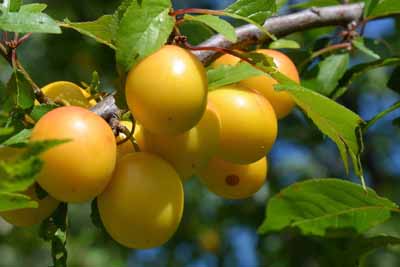
Prunus salicina 'Shiro'
Shiro Japanese Plum
Semi-dwarf. This vigorous, hardy plum is so productive that it will make your mouth water! 'Shiro' is a Japanese selection that ripens in mid-July bearing loads of medium sized, juicy, dark yellow plums that are perfect eating right off the tree. A great addition to the home orchard!
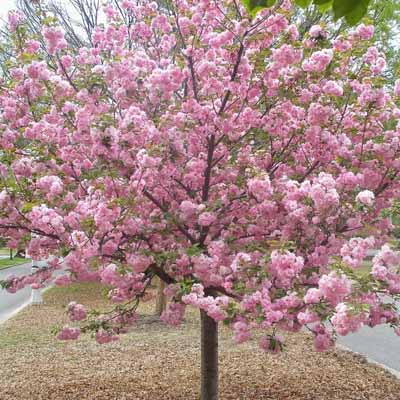
Prunus serrulata 'Kwanzan'
Kwanzan Flowering Cherry
A lovely specimen tree that puts on an incredible early season show with clusters of large, double deep pink blooms backed by bronze-red new growth. An upright, vase-shaped branching habit perfect for lining a road or driveway.
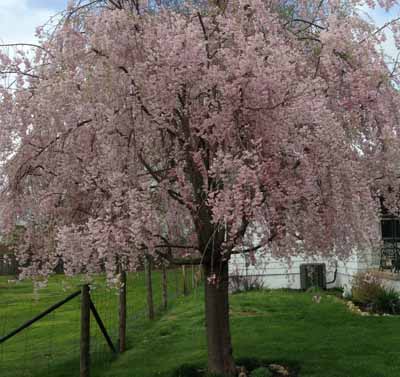
Prunus serrulata 'Pendula'
Japanese Weeping Flowering Cherry
This graceful weeping form is prized in the landscape. Small pink flowers cover the slender, pendulous branches giving a flower fountain appearance in late April to early May.

Prunus subhirtella 'Pendula'
Weeping Cherry
This graceful weeping form is prized in the landscape. Small pink flowers cover the slender the slender, pendulous branches giving a flower fountain apearance in late April to early May. Very hardy.
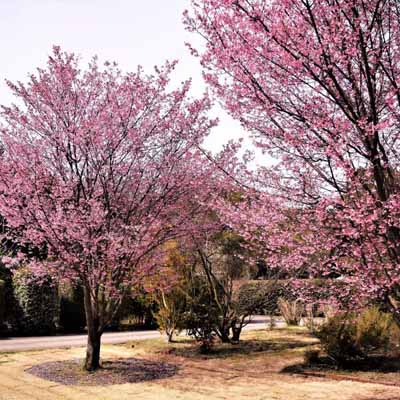
Prunus x 'Okame'
Flowering Cherry Tree
Okame trees are on display each year at the Cherry Blossom Festival in Washington, D.C. Visitors to this annual event will always remember how glorious these trees are in full bloom. Carmine-pink flowers open on bare stems before the leaves emerge.

Prunus x yedoensis 'Yoshino'
Japanese Flowering Cherry
Yoshino cherry, is a hybrid that produces fragrant white flowers in spring, followed by tiny black fruit. This is an upright tree, with a spreading crown that enjoys full sun. Its leaves are serrated and a rich green colour that provide good autumn colour later in the year, as they turn bright shades of orange and red.
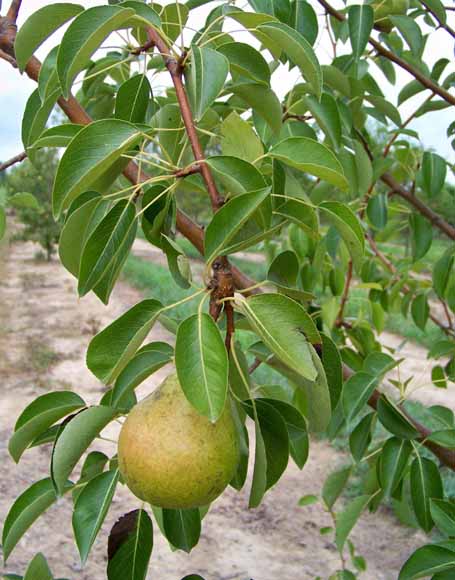
Pyrus 'Bartlett'
Pear Tree
This vigorous, productive tree bears fruit at a young age which ripens well on the trees. Your tree will flower in April - May, and will add a touch of beauty to your yard with its fragrant white flowers. Fruit is large, golden - yellow, with a wonderful quality. Buttery, juicy, highly flavored fruit. This tree is self - pollinating.

Pyrus 'Red d'Anjou'
Pear Tree
This large, vigorous tree produces fruit with mild, fine textured white flesh and a delicate aroma. Great for salads, desserts and fresh eating. Makes a good pollinator and is more cold tolerant. Red D Anjou Pear Tree needs another variety nearby for cross-pollination.
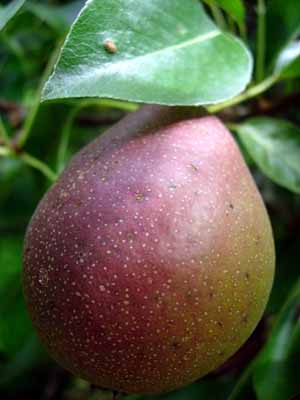
Pyrus 'Seckel'
Pear Tree
This easy-grown tree is very productive. It is cold-hardy and frost resistant. Produces sweet dessert type fruit. Needs at least two cultivars to ensure adequate pollinating.
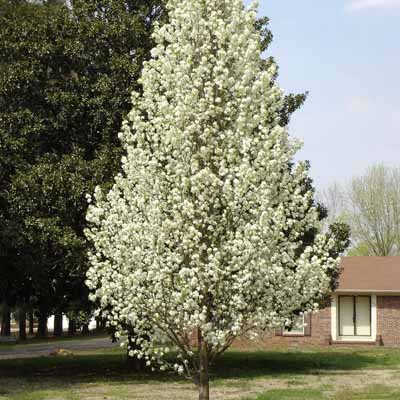
Pyrus calleryana 'Chanticleer'
Flowering Pear
A vastly improved form over Bradford pear with better branch structure and strength. A more tailored appearance that still has a lovely display of white flowers in spring. Shiny dark green summer leaves turn orange or gold-red to red-purple in the fall.
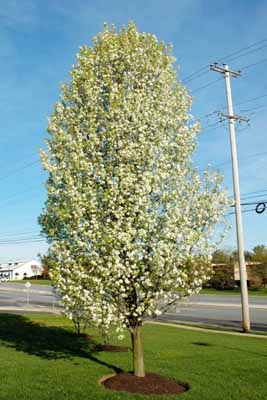
Pyrus calleryana 'Cleveland Select'
Cleveland Select Flowering Pear
A distinctive columnar form makes this a great choice for street or yard planting. Showy clusters of gleaming white blooms in early spring. Dark green summer foliage turns a brilliant purplish red-orange in fall.
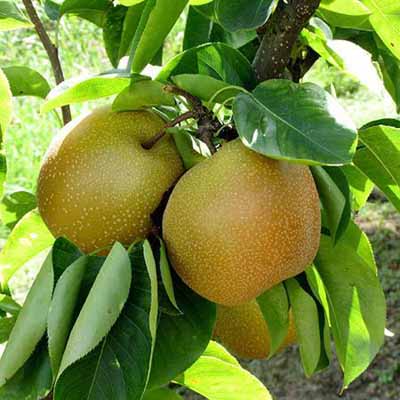
Pyrus pyrifolia 'Shinseiki'
Asian Pear
Produce medium to large, rounded yellow fruit with smooth, sweet, creamy, white flesh. Excellent dessert quality.
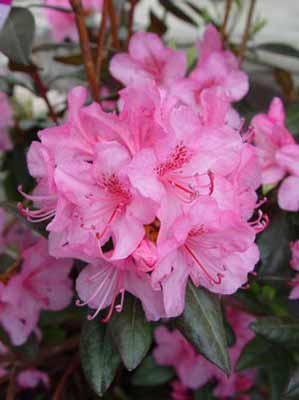
Rhododendron 'Aglo'
Rhododendron
An aromatic plant that produces numerous bright pink flowers that cover the branches in early May. Aromatic, small, glossy, bright green foliage in summer, turns coppery bronze in winter. A hardy, fast - growing plant with a dense, mounding habit, it prefers full sun and well - drained, rich soil. Excellent winter leaf retention.

Rhododendron 'Anah Kruschke'
Rhododendron
Anah Kruschke' seems to have a longer than average bloom time, because the buds are a rich purple before opening. In May & early June it produces large clusters of reddish purple flowers with dark crimson-violet freckling. This super hardy, super floriferous selection has a compact habit with deep green, leathery foliage which compliments its outstanding and long lasting blooms.
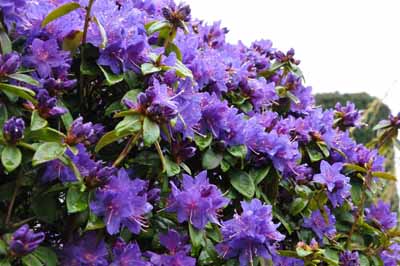
Rhododendron 'Blue Baron'
Rhododendron
Striking, riveting, brilliant blue flowers grace this selection in early May, nearly covering its uniquely small, elongated, shiny foliage. Compact, mounded landscape form is easy to work with and looks good year round, even in winter as its foliage takes on a decidedly reddish-bronze hue

Rhododendron 'Capistrano'
Rhododendron
A dense, rounded form with lustrous, deep green foliage, serves as a backdrop for distinct yellow flower trusses that will easily be the best yellow seen on a Rhododendron in this part of the country.
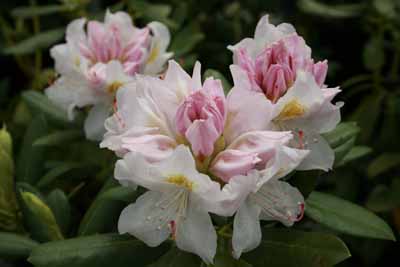
Rhododendron 'Catawbiense Album'
White Catawba Rhododendron
Our hardiest broadleaf white rhododendron, this variety is vigorous growing and dependably sets loads of lilac-tinged flower buds that open pure white with yellow blotches in mid-May.
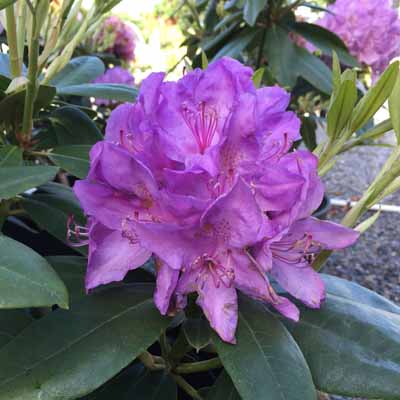
Rhododendron 'Catawbiense Boursault'
Catawbiense Boursault Rhododendron
Dependable and hardy with a round dense shape that lends itself well to any landscape situation. Deep purple buds open lavender in mid-May and put on quite a show!
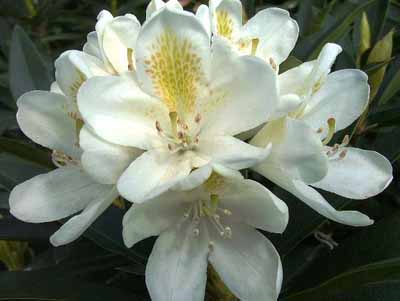
Rhododendron 'Chionoides'
Rhododendron
This variety is a beauty with a dense, compact habit and narrow deep dark green foliage. Later blooming, toward the end of May, it's usually covered with big trusses of white flowers with yellow centers. Although most are adaptable to full sun or full shade, the large - leaf varieties perform best in partial shade with protection from harsh summer and winter sun as well as wind.

Rhododendron 'Cunningham's White'
Rhododendron
Compact growing with great dark green foliage, this selection is easy to grow and a dependable, profuse bloomer with even an occasional fall bloom! Buds are pink, opening to white with a greenish yellow blotch in early May. It will become an anchor plant in your landscape.
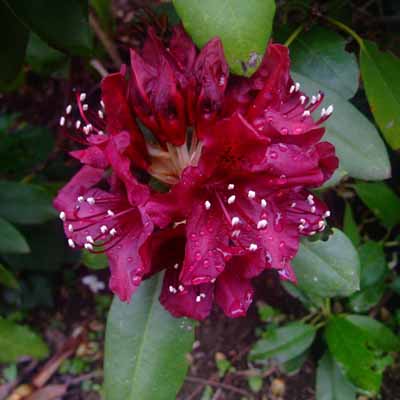
Rhododendron 'Dark Lord'
Rhododendron
Dramatic merlot-red, ruffled blooms emerge on a neat, mounded plant in May. Deep red flowers against glossy, dark green foliage create a show-stopping explosion in your landscape.
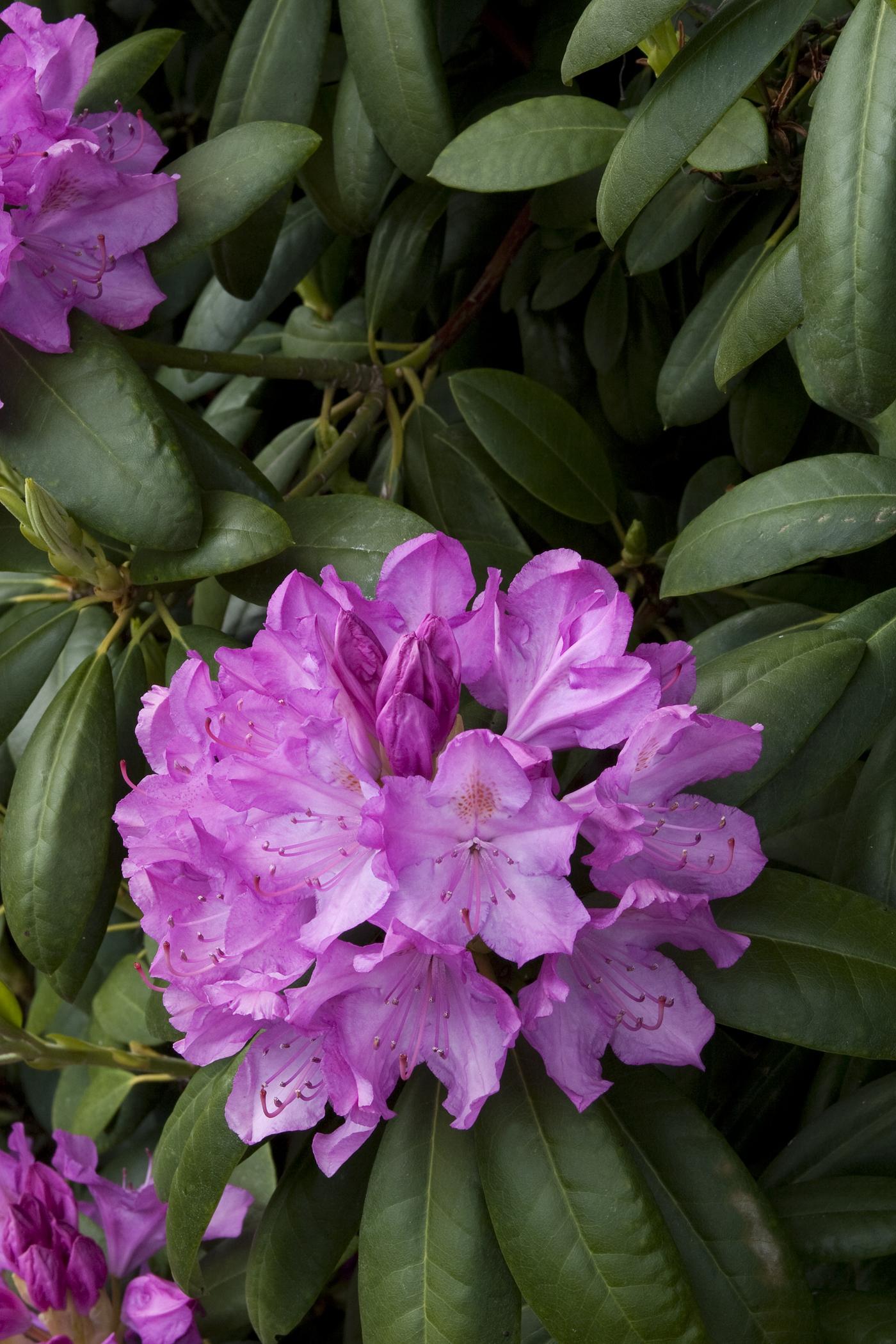
Rhododendron 'English Roseum'
Rhododendron
A beautiful, dense-growing evergreen shrub, prized for its large, elegant trusses of showy rosy pink-purple flowers that stand out against the lustrous dark green foliage. Thrives in cooler regions but benefits from protection from winter winds. An outstanding choice for foundation plantings or for use as an accent specimen. Use this romantic lavender-flowering hybrid at the back of the shrub border with others of its size. Plant as a single accent outside a special window or use to fill a barren corner of the yard. Makes a foolproof front-yard display plant to fill in side-yard gaps and disguise utilities. Makes a good evergreen hedge for privacy or to absorb sound.
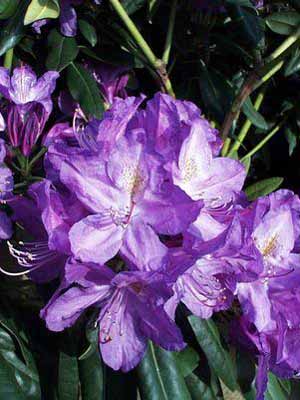
Rhododendron 'Lee's Dark Purple'
Rhododendron
Interesting wavy-edged deep green foliage and dark purple flowers make this variety stand out. Quite hardy and a strong grower, its late May bloom make this plant a knockout.
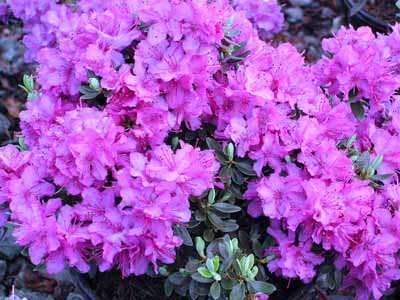
Rhododendron 'Minnetonka'
Rhododendron
A dense and spreading compact shrub with handsome dark green, glossy foliage. This hardy mid-season bloomer heralds spring with deep red-violet buds

Rhododendron 'Miyama Gold Prinz'
Rhododendron
Beautiful glossy dark green foliage with golden-yellow flowers speckled with red. Prefers cooler regions but some protection from winter wind is recommended. Makes an outstanding accent specimen or low, informal hedge.
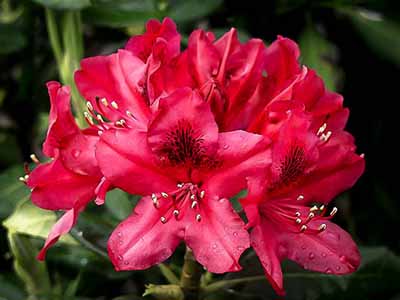
Rhododendron 'Nova Zembla'
Rhododendron
A great, eye-grabbing red flower on a very dependable plant adds up to this variety being extremely popular! Profuse mid-May bloom on this heat and cold tolerant selection and large, upright form make this a great landscape background plant.
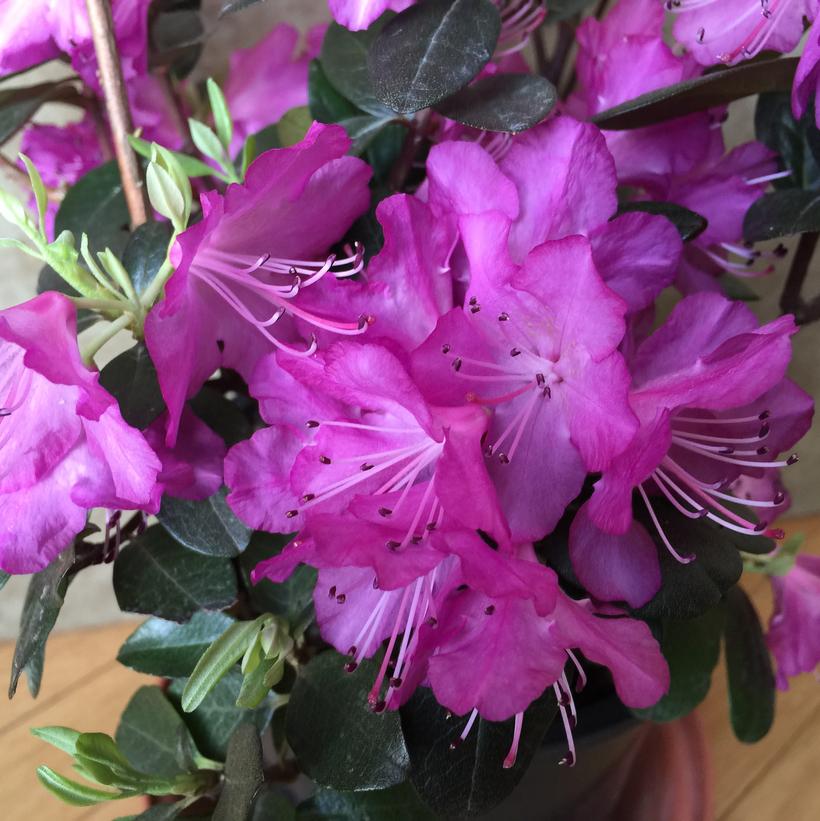
Rhododendron 'PJM Elite Star'
Rhododendron
Super hardy and super compact, this floriferous, denser selection of 'PJM Elite' will light up the landscape with huge clusters of deep lavender-pink flowers in late April and early May. 'PJM Elite Star' is likely the most tolerant Rhody you'll find for cold conditions and will reward you with a consistently breathtaking flower show each spring.
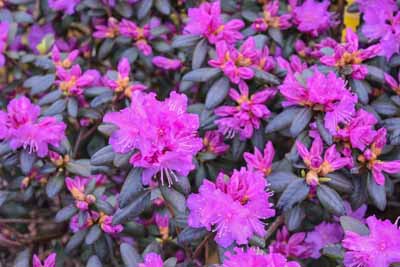
Rhododendron 'PJM Elite'
Rhododendron
A slightly more compact form of PJM, this plant is a landscape stunner both for form and flower. The purple-plum color of the winter foliage serves as a great background for the late April burst of brilliant lavender pink bloom.Extremely hardy!
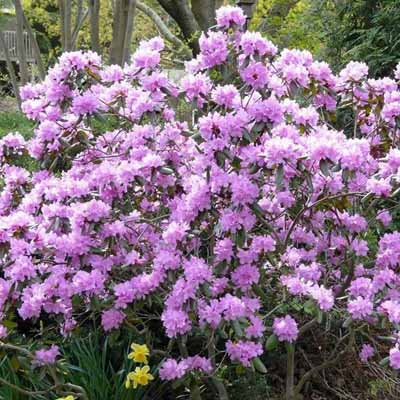
Rhododendron 'PJM'
SmallLeaf Rhododendron
Early flowering. Brilliant lavender - pink flowers cover the entire plant in late April when forsythia is in bloom. Small, rich green, aromatic foliage turns a vibrant dark mahogany winter color from October through April. Even though it seems to be a compact growing plant when young, it will attain a large stature with maturity if allowed to grow unsheared or in partial shade. More sunlight will produce a deeper fall foliage color.

Rhododendron 'Polar Night'
Rhododendron
Unique form, bud color, and flower color will make this Rhododendron an unforgettable landscape experience. Tight, low and spreading, this broadleaf Rhododendron will mature twice as wide as tall with a pleasing form that is perfect where height issues are paramount. Leathery, dark green leaves populate its branches and serve as the backdrop for striking, bulbous, branch ending buds that turn nearly black as they expand in mid to late May to expose the first glimpses of flowers color. When the buds open fully, frilly deep, dark purple flowers form huge trusses that cover the plant with this rare, very showy color. What a sight and what a perfect, well behaved plant for morning sun/afternoon shade conditions!

Rhododendron 'Purple Gem'
Rhododendron
A handsome dwarf evergreen shrub with a dense habit and deep blue-green foliage that develops a bronze tint in winter. Prized for its showy trusses of stunning purple-violet flowers.
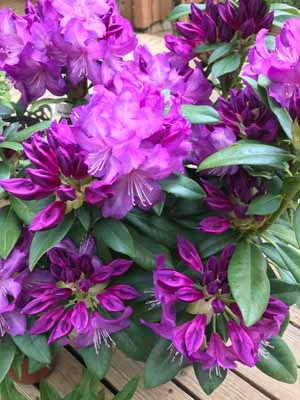
Rhododendron 'Purple Passion'
Rhododendron
Big flower buds burst into bloom in mid to late May with big violet-purple bloom trusses that cover the plant.
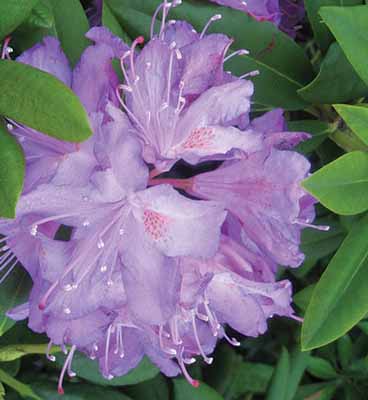
Rhododendron 'Roseum Elegans'
Rhododendron
Roseum Elegans Rhododendron is smothered in stunning clusters of lilac purple trumpet - shaped flowers with shell pink overtones at the ends of the branches in mid spring, which emerge from distinctive purple flower buds. It has green foliage. The large narrow leaves do not develop any appreciable fall color.
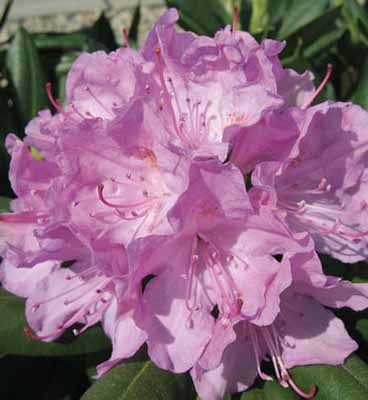
Rhododendron 'Roseum Pink'
Rhododendron
Rounded evergreen shrub with dark green foliage. Clear pale pink flowers with light brown blotches burst forth in late May. Ideal for hedge, accent plant or in natural setting.
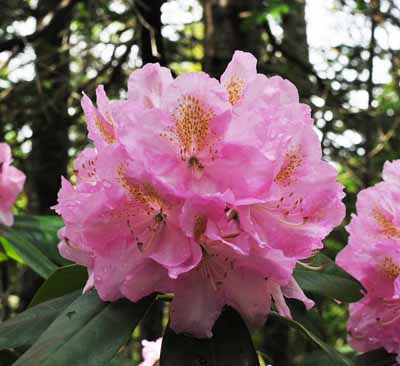
Rhododendron 'Scintillation'
Scintillation Rhododendron
This plant's bloom will take your breath away! Backed by a deep green, shiny foliage and a dense, spreading form, the flowers on this mid-May bloomer are held above the plant in huge, radiant soft pink bunches that are truly remarkable.
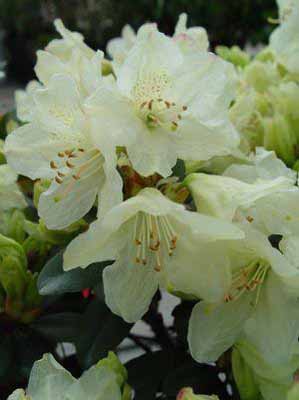
Rhododendron 'Towhead'
Rhododendron
A dense growing beauty with bronze winter foliage, this plant is highlighted in late April with an eye-catching display of profuse, soft yellow flowers. Low and dwarf, this plant deserves a try in any small landscape space.
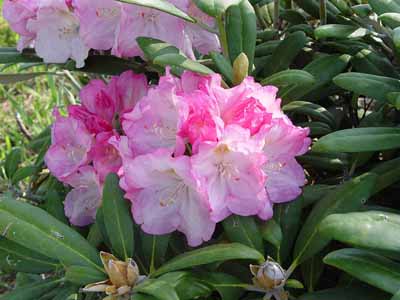
Rhododendron yaku 'Prince'
Rhododendron
Another excellent, compactly formed selection that cries out for wide landscape use. Mid-May bloom is heavy and attractive with a showy, dark pink color that stands out.
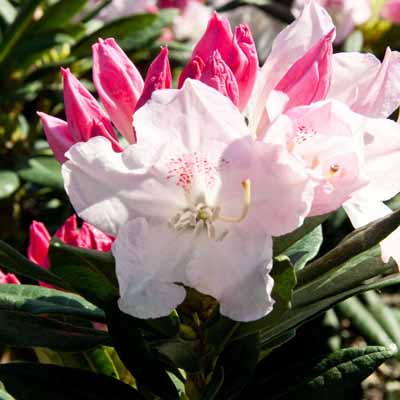
Rhododendron yaku 'Princess'
Rhododendron
Showy pinkish white blooms create a striking contrast against the deep olive green foliage. A vigorous grower and low maintenance
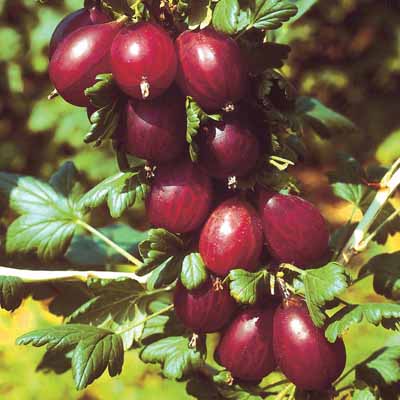
Ribes 'Hinnonmaki Red'
Gooseberry
A unique tart and sweet combination. Tart skin covers the sweet flesh of these tasty, ruby berries, so you can enjoy both flavors. Perfect for making pies and jams. Bushes are heavy producers, even when young. Mildew-resistant and cold-hardy. Ripens in July. Self-pollinating.

Ribes 'Red Lake'
Currant
Red Lake' is appealing not only for its fruit but for its compact, mounding habit and glossy green foliage that makes a stand out ornamental shrub. This selection produces long, pendulous clusters of greenish-yellow flowers that bloom in late April and early May. Flowers give way to long, pendant clusters of bright red Currants, which ripen in July. 'Red Lake', although tart, may be eaten ripe off the shrub, but are perhaps more often harvested to make jams, jellies and pies.
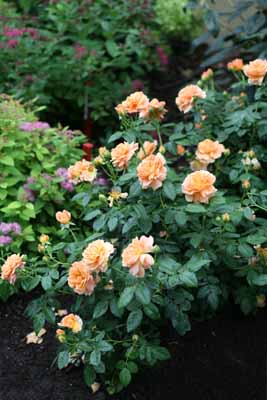
Rosa 'At Last'
Rose
Finally - a fragrant, disease-resistant rose! It's the dawn of a new day for roses: At Last combines all the romance of a fragrant, fully-petaled tea rose with the no-nonsense practicality of a disease-resistant landscape rose. No spraying is required to enjoy a non-stop display of large, sweetly perfumed sunset-orange blossoms from late spring through frost. Handsome, glossy foliage and a vigorous, rounded habit makes it ideal for use in the landscape or the flower garden.
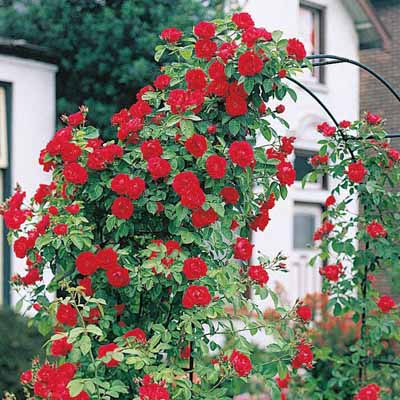
Rosa 'Blaze'
Climbing Rose
Perhaps the most famous, most durable climbing rose available, 'Blaze' is a flower producing machine with big bunches of lightly scented, pure red flowers on aggressive, flowing canes. 'Blaze' keeps the flowers coming throughout the season and blooms on both new and old wood.
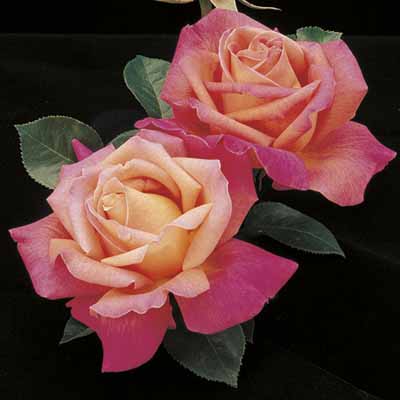
Rosa 'Chicago Peace'
Hybrid Tea Rose
Discovered in the windy city of Chicago, this sport of the world famous Peace rose has large copper-pink blooms that shimmer with a canary-yellow at the base of the petals. Interesting, leathery foliage is disease resistant. Loves hot weather and does well in zones where the winter temperatures are frigid.
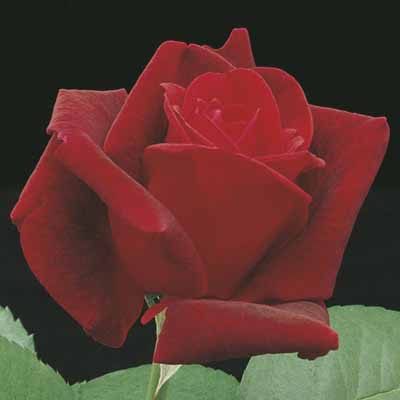
Rosa 'Chrystler Imperial'
Hybrid Tea Rose
An old stand-by that still is the standard by which great Hybrid Teas are judged! Huge, shapely flowers open velvety red with a powerful sweet, spicy fragrance that just fills the yard.
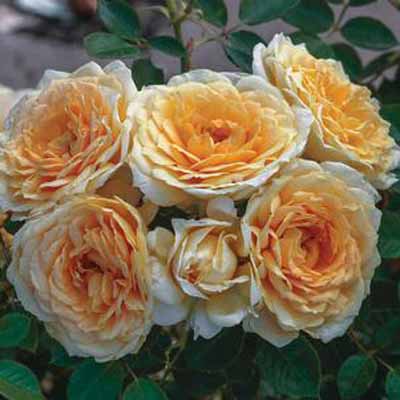
Rosa 'Downton Abbey Edith's Darling'
Rose
This golden, English style shrub rose is appropriately named in honour of Lady Edith's beloved daughter Marigold, producing vibrant clusters of 3" blossoms with over 60 petals each for a dramatic, season-long spectacle. Ruffled, cupped blooms have radiant golden centers, fading to pale yellow at the outer edges with a light fruity fragrance. The shrub's exceptionally compact habit and lush green foliage make it ideal for planting in containers or in the landscape.
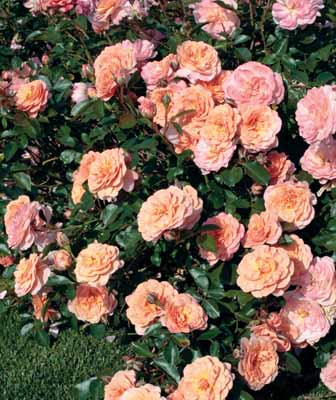
Rosa 'Drift Apricot'
Apricot Drift Rose
Double apricot colored flowers begin blooming in spring and display a season-long show of color. Low maintenance, vigorous and cold hardy. Glossy dark green foliage has excellent disease resistance.
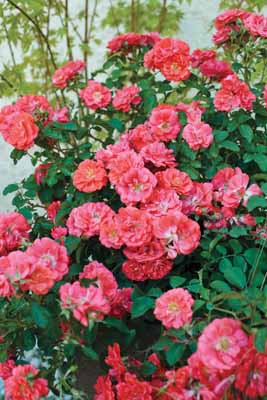
Rosa 'Drift Coral'
Coral Drift Rose
Fill the garden with vibrant, coral-colored flowers from spring to frost. Easy-care, vigorous and cold hardy. Glossy dark green foliage with excellent disease resistance.
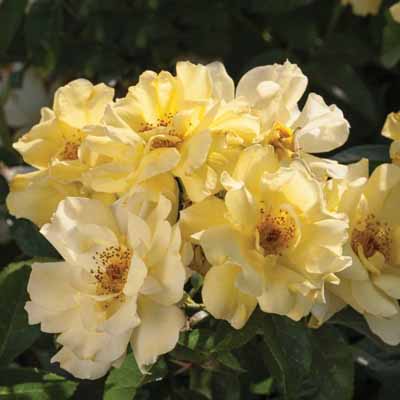
Rosa 'Drift Lemon'
Groundcover Rose
The Lemon Drift Rose is the newest addition to the Drift series. It is a perfect yellow groundcover rose. This rose has a very bushy, compact, and rounded habit.
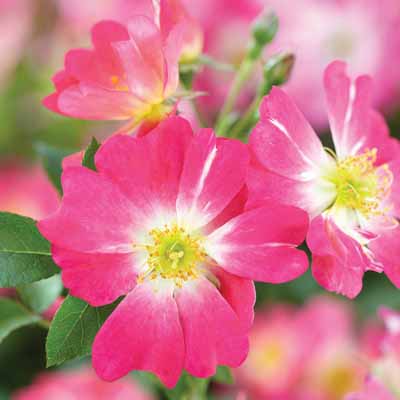
Rosa 'Drift Pink'
Pink Drift Rose
Delightful deep pink flowers with a soft faced center bloom in abundance for an extended season of color. Glossy dark green, disease resistant foliage on a vigorous, hardy and nearly care-free shrub.
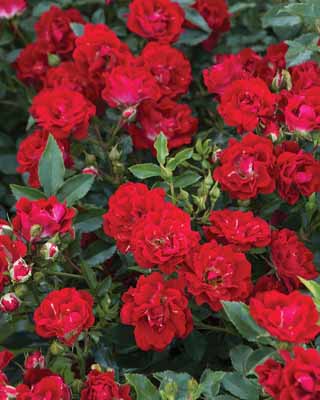
Rosa 'Drift Red'
Red Drift Rose
Clusters of petite flowers bloom in abundance for an extended season of color. Glossy dark green, disease resistant foliage on a vigorous, hardy, carefree shrub.
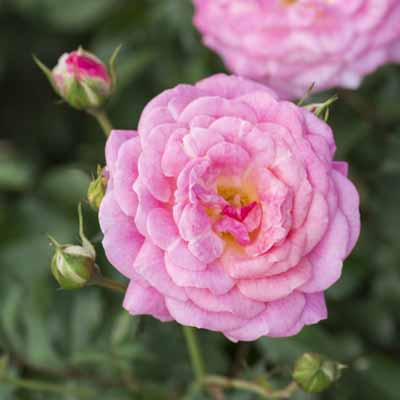
Rosa 'Drift Sweet'
Sweet Drift Rose
Clusters of clear pink double flowers produce an abundant, continuous display throughout the season. Vigorous, exceptionally disease resistant glossy foliage means easy care.
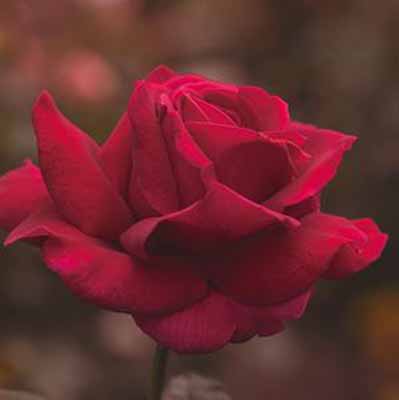
Rosa 'Mister Lincoln'
Mister Lincoln Hybrid Tea Rose
A dependable Hybrid Tea that keeps on giving velvety, rich red flowers with strong demask scent thoughout the growing season.
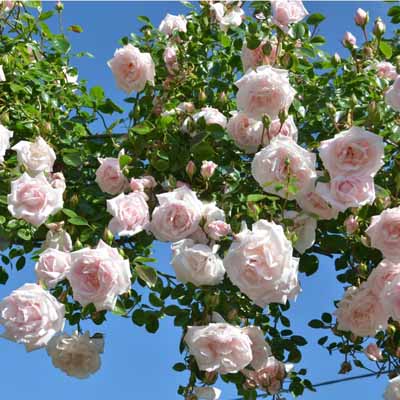
Rosa 'New Dawn'
Climbing Rose
Fragrant, blush pink, double flowers cover this large climbing rose. Glossy dark green foliage and abundant rose hips in autumn add to the show for months of show stopping curb appeal.
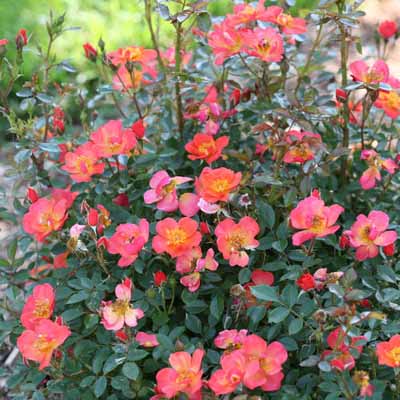
Rosa 'Oso Easy Hot Paprika'
Rose
Spice up your landscape! Oso Easy Paprika rose is a landscape classic - and now, it has a modern update. Meet Oso Easy Hot Paprika - like its namesake, it flowers from early summer through frost on a versatile, low-growing plant. It also shares its outstanding hardiness and disease resistance. Its flowers, however, light up the garden in an electric glowing orange for a bold new look.
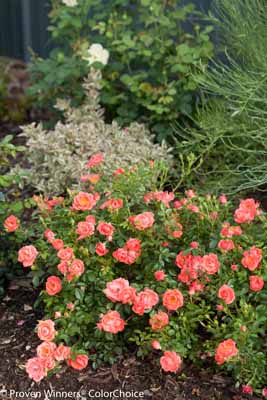
Rosa 'Oso Easy Mango Salsa'
Rose
If you think roses are for very proper, formal gardens, think again. This rebel has intense, amazing color: shades of ruby-red grapefruit, summer sunsets, and those fancy tropical drinks with umbrellas in them. The continuous blooms cover the tidy mound of dark, glossy foliage. This is a wonderful choice for mass plantings or adding unusual color to mixed borders.
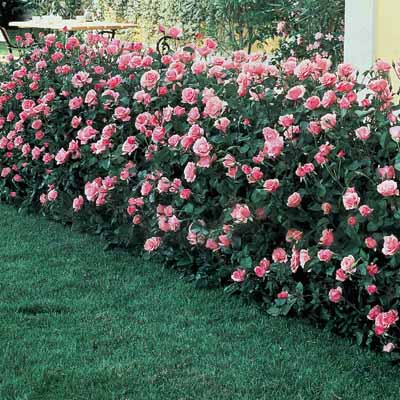
Rosa 'Queen Elizabeth'
Queen Elizabeth Climbing Rose
This regal Glandiflora sets the standard for this rose type with its dependability and profusion of long-stemmed bunches of clear pink blossoms.
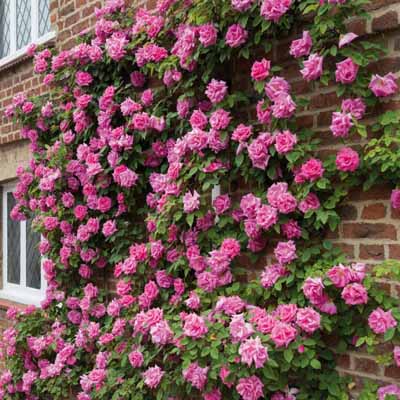
Rosa 'Zepherine Drouhin'
Climbing Rose
Wonderfully scented, deep rose pink blooms. Flowers freely and almost continuously. Thornless climbing rose.
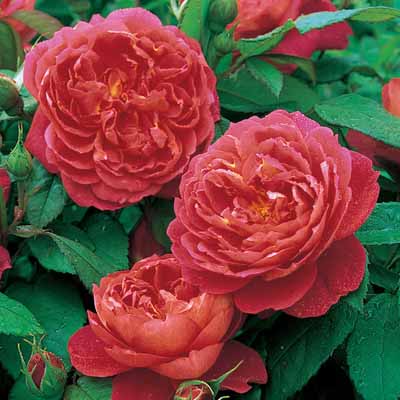
Rosa David Austin 'Benjamin Britten'
English Shrub Rose
A variety of unusual coloring that changes with age to a glowing deep pink-red. The deeply cupped flowers soon open to slightly cupped rosettes. The fragrance is fruity, with aspects of wine and pear drops. It forms a dense, rather upright shrub. REPEAT FLOWERING roses flower in flushes from late spring through to fall.

Rosa David Austin 'Charlotte'
English Shrub Rose
Bears exquisite yellow flowers. These start off beautifully cupped, later opening out to form rosettes. Each bloom is packed with numerous small petals, arranged around a classic button eye. REPEAT FLOWERING roses flower in flushes from late spring through to fall.
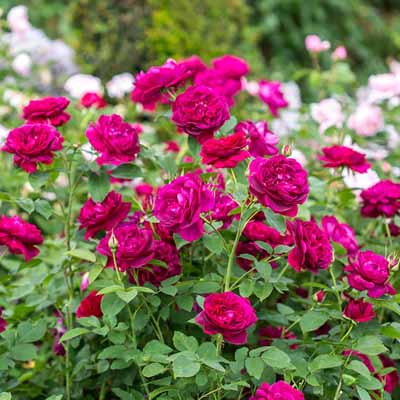
Rosa David Austin 'Darcey Bussell'
English Shrub Rose
When young, the outer petals of each bloom form a perfect ring around an inner cup, gradually opening out to form a perfect, medium-large rosette. The color is a deep, rich crimson-pink, taking on a tinge of mauve just before the petals drop. There is a light-medium fruity scent. It forms a compact shrub with attractive bushy growth. REPEAT FLOWERING roses flower in flushes from late spring through to fall.
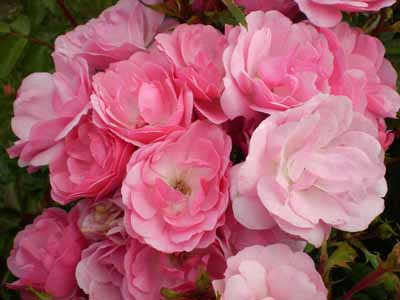
Rosa Easy Elegance 'Pinktopia'
Rose
Pinktopia is an ideal accent or hedge plant. Masses of pink flowers are surrounded by dark green foliage and red new growth, creates a beautiful contrast. Own root.

Rosa Knock Out 'Coral'
Shrub Rose
Brilliant color and superb disease resistance will make this latest addition to the Knock Out Rose family an absolute winner in your landscape. Shiny, deep green foliage serves as the backdrop for rich orange to coral flowers that bloom from spring through fall
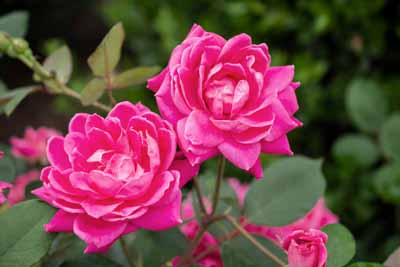
Rosa Knock Out 'Double Pink'
Shrub Rose
Just as gorgeous as 'Double Knockout' only with intense hot pink blooms. The double have twice the number of petals as regular 'Knock Out' roses, presenting a fuller, richer, traditional style rose flower that is simply breathtaking. Blooms maintain a continuous show of color from early June to hard frost, with beautiful foliage almost year round. Compact and upright fashion, more winter hardiness and shade tolerance.

Rosa Knock Out 'Double'
Shrub Rose
The fire - engine - red double blooms of 'Double Knock Out' keep coming until hard frost, and its new growth is a stunning burgundy red. Aptly named, this popular successor to 'Knock Out' is fuller and more floriferous, producing clusters of 2 1/2in, incandescent blooms with 18 - 25 petals. A hardy variety naturally resistant to black spot and other diseases and pests.
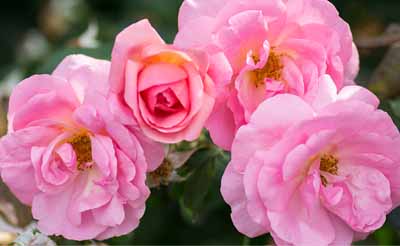
Rosa Knock Out 'Peachy'
Shrub Rose
Blooms from spring through fall with attractive pink flowers. The overall color effect is peach, achieved with the combination of pink petals that become yellow in the center. The color will be much more intense with the cooler temperature in the spring and fall.
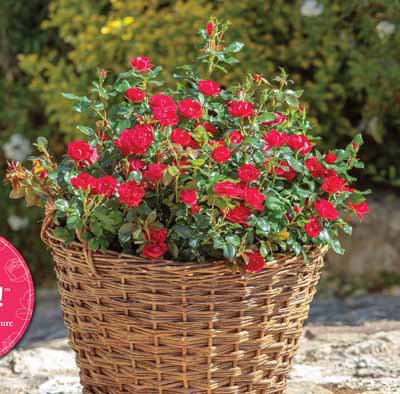
Rosa Knock Out 'Petite'
Shrub Rose
The Petite Knock Out Rose is the first-ever miniature Knock Out Rose! It has the same flower power and easy care as others in The Family, but in an adorable, compact size! Not only is the plant petite, but it displays smaller blooms than other Knock Out Roses. Plant in decorative containers for your porch or patio, or in mass for a dramatic pop of bold red color.
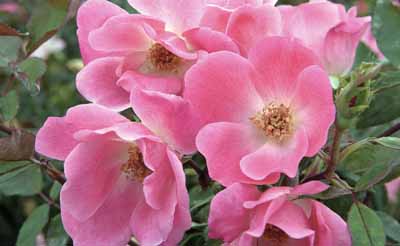
Rosa Knock Out 'Pink'
Shrub Rose
Single petals just like the original 'Knock Out' but in a beautiful shade of bright pink. And like the other members of the family, The Pink 'Knock Out' Rose is black spot resistant, drought tolerant and self - cleaning. A perfect companion to other shrubs, roses and perennials.
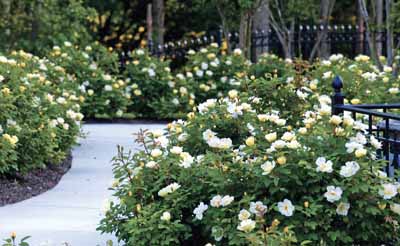
Rosa Knock Out 'Sunny'
Shrub Rose
Loads of buds top deep green foliage from May to October, continually opening to reveal bright yellow, single, 3 diameter flowers that mature to creamy yellow as they age. These are the only fragrant members in The 'Knock Out' Family. The plants clean themselves, dropping their spent petals, and are perfect for groupings or as a stand alone
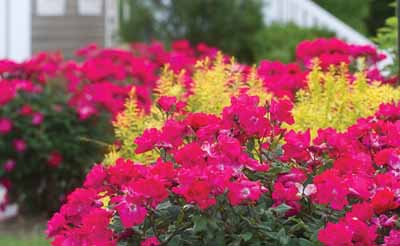
Rosa Knock Out 'The Original'
Shrub Rose
The original member of The Knock Out Family, this shrub rose set a new standard in disease resistance with little to no maintenance required. The bloom cycle produces rich cherry red, hot pink blooms that will continue until the first hard frost. Black spot resistant, drought-tolerant and self-cleaning.
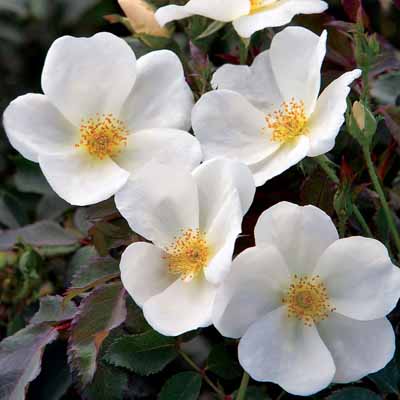
Rosa Knock Out 'White'
Shrub Rose
A compact, exceptionally disease resistant selection with abundant, single white flowers backed by superb dark green, nearly black foliage. This rose re-defines flower power, with nearly non-stop blooming in the mildest climates

Rosa rugosa
Beach Rose
Tough,hardy, native plant that thrives in difficult sites. Used extensively in seashore locations. Large, flowers that bloom somewhat continously all summer.
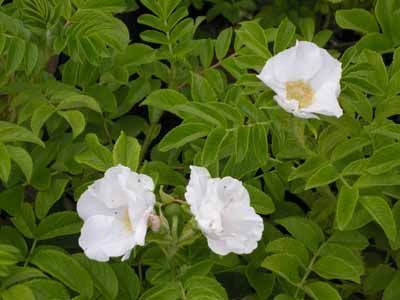
Rosa rugosa 'Alba'
Beach Rose
Pure white, single flowers abound in the spring, recur sporadically throughout the season and fill the air with their sweet scent

Rosa rugosa 'Purple Pavement'
Beach Rose
A dense, rounded mound of a plant with a continuous show of semi-double purple-crimson flowers. Very hardy with bright red, bird attracting hips in the fall and winter months.

Rubus 'Chester'
Thornless Blackberry
A thornless blackberry that yields a productive crop of large, very sweet, high quality fruit. The hardiest thornless blackberry, it does fine in all of Zone 5, and has good resistance to cane blight. Ripens in July.
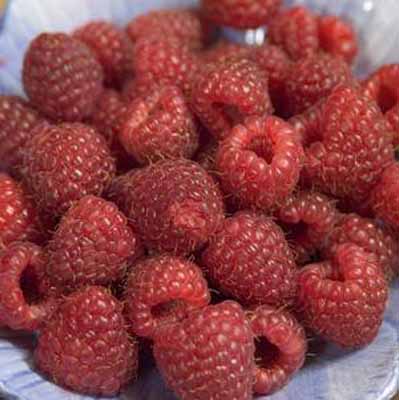
Rubus 'Heritage Red'
Raspberry Bush
Red raspberry with flavorful fruit, producing one crop in mid July and another in early September. Flesh stays firm even when over-ripe.
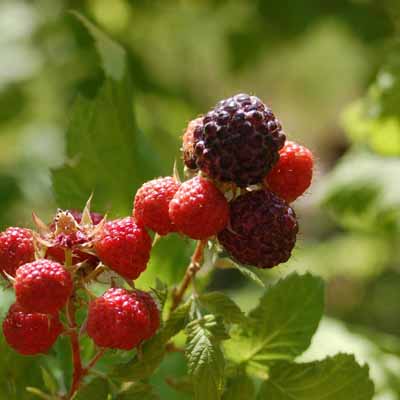
Rubus 'Jewel'
Black Raspberry Bush
Excellent quality black raspberry. Fruit is large, glossy black with superb flavor. 'Jewel' is more disease-resistant than other black raspberry varieties.
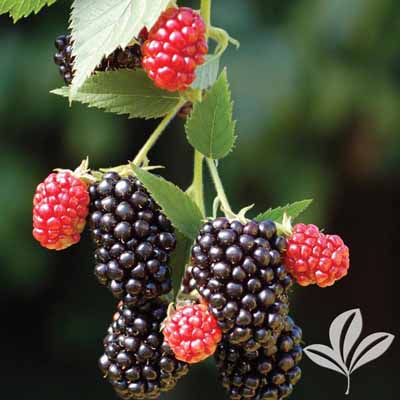
Rubus 'Navaho'
Blackberry
Navaho is an upright,blackberry producer on a thornless shrub. When berries are not in season, there are clusters of pinkish-white blossoms. Excelent snack for a hot summer day when matured in the mid-to-late July, or to use in canning and pies. Get ready to love this variety year after year!

Rubus 'Pink Champagne'
Currant
Get ready for great tasting Currants with a twist different color and different flavor!! 'Pink Champagne' is a cross between White Currant and Red Currant that yields a fruit that is white with a distinct pink blush. To go along with the different color, 'Pink Champagne's' taste will also surprise you with a luscious sweetness that makes it great for fresh eating. While not as tart as Red Currant, 'Pink Champagne' is still a surefire winner when it comes to preserves, jams and jellies just like the rest of this family. Even better, this selection is the perfect home edible garden plant with its dense, full form, its very low maintenance nature, and its extremely high yields for such a compact plant. You'll be picking 'Pink Champagne' by the containerful once this plant gets established!

Salix discolor
Pussy Willow
Vigorous, spreading, deciduous shrub with a multitude of gray, hairy catkins that appear in mid to late March. Attractive red-brown stems and bluish backed foliage. Tolerates wet soil, easy to grow. Perfect for large border plantings.
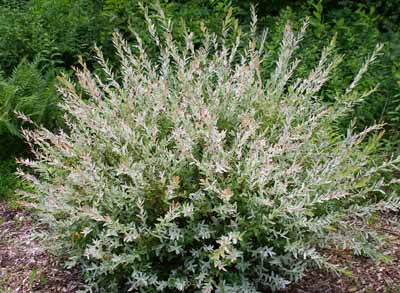
Salix integra 'Hakuro Nishiki'
Dappled Willow
Outstanding tri-color variegation of white, green and pink make this more compact growing pussy willow an interesting landscape addition. Easy to grow, prefers moist soil.
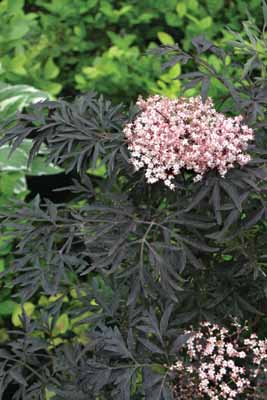
Sambucus nigra 'Black Lace'
Elderberry
Intense purple black foliage is finely cut, giving it an effect similar to that of Japanese maple. Huge 10 diameter creamy pink, fragrant flowers in spring contrast nicely with the dark leaves. They are followed by blackish red fall berries which can be harvested for making wine and jam, or left on the plant to attract birds and other wildlife. 'Black Lace' is very cold hardy and easy to grow, and adaptable to most sites. Full sun is needed for the best color. Tough enough for roadsides or naturalizing. Good in wet soils
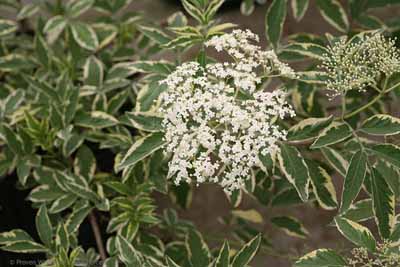
Sambucus nigra 'Instant Karma'
Elderberry
Variegated va-va-voom! Brighten your garden with Instant Karma elderberry. A major improvement over older variegated elderberries, Instant Karma offers neat, clean foliage of interplaying green and white. Large, lacy flower clusters appear in early summer, and if a pollinator variety (like Black Lace or Black Beauty elderberry) is present, you'll get a crop of purple-black fruit in autumn. This versatile plant can be grown as a small tree or large shrub - it even plays nice in a perennial garden if it is cut back each year for a handsome spray of bright foliage.
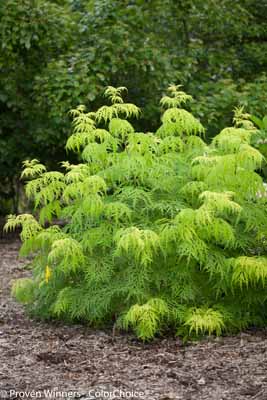
Sambucus racemosa 'Lemony Lace'
Elderberry
Ever wish our popular Black Lace elderberry came in a sunny bright yellow? We are happy to oblige: Lemony Lace offers finely dissected foliage but in a cheery gold color to really light up your landscape. This North American native produces big clusters of white flowers in early spring before the foliage emerges, then bright yellow leaves take over, edged in red. As the foliage ages, it turns an attractive chartreuse. Though it is a large plant, it can be pruned to stay smaller if you'd like. Deer resistant. Native to North America.
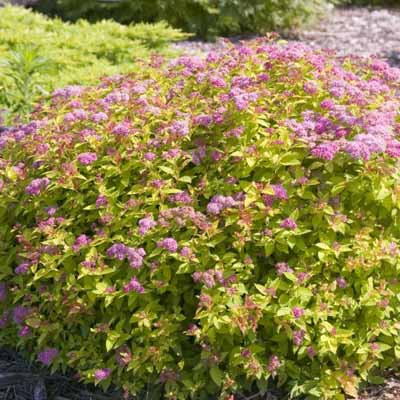
Spiraea x bumalda 'Magic Carpet'
Spirea
A real improvement in gold foliage Spireas, this selection keeps its gold color throughout the summer and blooms heavily from mid - June through July with pink, flat flower heads. Neat compact form makes it easy to use anywhere.

Spirea 'Double Play Big Bang'
Spirea
Japanese spirea comes by its popularity earnestly: durable, super easy to care for, and perfectly pretty pink flowers in spring. Double Play Big Bang spirea does the landscape classic one better with the biggest, pinkest flowers of any Japanese spirea. It also offers super colorful new growth, especially when it emerges in early spring. That's what makes it a perfect Double Play! Like other Japanese spirea, it's drought tolerant, deer resistant, grows and blooms well in partial shade, and maintains a nice, neat shape without pruning.
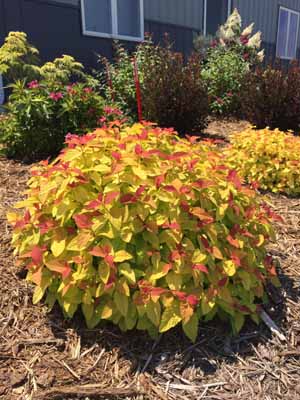
Spirea 'Double Play Candy Corn'
Spirea
Meet the newest and most colorful Proven Winners spirea, Double Play Candy Corn . The show starts in early spring when the new growth emerges bright candy apple red. As it matures, it turns pineapple yellow, and the new growth continues to emerge bright orange all season. Top it off with dark purple flowers in late spring/early summer, and you've got a display you really have to see to believe. Be sure to click the image tab below to see just how showy this low-maintenance spiraea is! Deer resistant.

Spirea 'Double Play Doozie'
Spirea
Like all of the Double Play spirea series, the show begins in early spring, when the foliage emerges in blazing brilliant color - in this case, deep red. By late spring, the flowers begin to emerge, a bright, glowing purple-red that truly sings in the landscape. And as summer comes on, the show doesn't stop: it just keeps flowering, and flowering, and flowering. Because it produces no seeds, it puts all of its energy into flowering! It does it all with the same good looks, drought tolerance, and deer resistance that you expect from spirea, too.

Spirea 'Double Play Gold'
Spirea
Golden foliage is accented by hot pink summer flowers. Deer resistant. Low maintenance. Season long color.
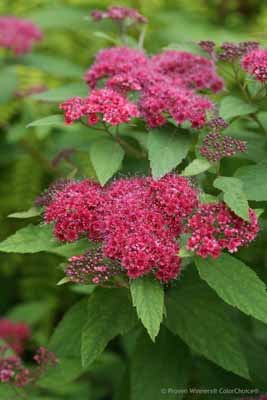
Spirea 'Double Play Red'
Spirea
Double Play spireas have vibrant flowers and stunning foliage. Double Play Red is a flower color breakthrough, with nearly-red flowers. Add in showy dark burgundy spring foliage and you've got the perfect double play!
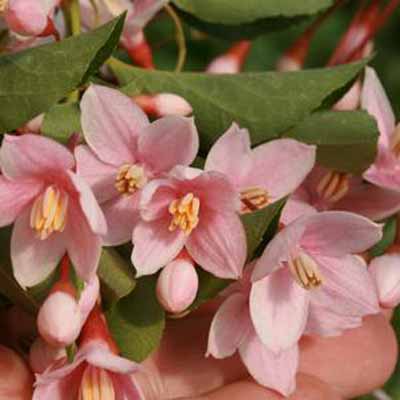
Styrax japonicus 'Marley's Pink'
Japanese Snowbell
Marley s Pink exhibits larger, darker green, and glossier leaves than most cultivars of Snowbell. This tree has a profuse blooming character! Blooms are a pink shade, with light sweet fragrance of cotton candy. The fall color is bright lemon-yellow. This new introduction displays good pest and disease resistance, and is a spectacle and centerpiece in patio containers, small gardens or landscape.
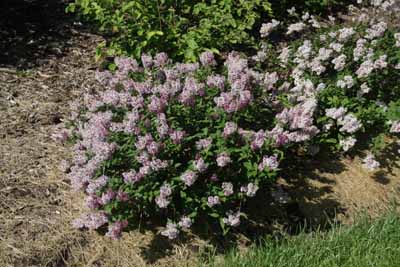
Syringa 'Baby Kim'
Lilac
Yes, you have space for a delightfully fragrant lilac! Baby Kim lilac is our smallest lilac to date, but boy, does it pack in a lot of flower power. Enjoy glossy, dark green foliage, an abundance of fragrant purple blooms that don't fade to white, and a useful rounded habit that fits into just about any sunny spot. It brings all the joy of lilacs into a neater, tidier package so you can enjoy this classic flowering shrub no matter how much - or how little - space you have.

Syringa 'Bloomerang Dark Purple'
Reblooming Lilac
Don't settle for lilacs that bloom just once a year - get Bloomerang lilacs and enjoy months of blooms instead of just weeks. Big, bold, and beautiful - that's Bloomerang Dark Purple lilac. Naturally growing as a handsome, rounded shrub, very large dark purple buds emerge in mid to late spring. These open to a classic deep purple-lilac color and perfume the air for weeks. The plant then takes a brief rest to create new growth before it starts to bloom again in mid to late summer, continuing through frost. Bloomerang lilacs are also noted for their exceptional disease resistance - no worries about ugly white or brown foliage to spoil the floral show. And like other lilacs, it is sun-loving and deer resistant, so it makes an easy care choice for years of beauty.
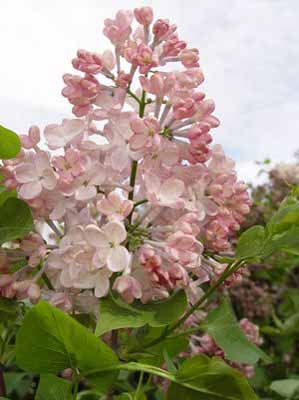
Syringa 'Maiden's Blush'
Lilac
Looking for a pink lilac with the traditional lilac scent? 'Maiden's Blush' is it! This early blooming Lilac blooms about 1 week before the common and French lilacs and is considered the best pink Lilac available on the market. The single, very fragrant blooms are held above a cloud of green leaves in big, attractive cones that will dazzle in early to mid-May. These factors, as well as being able to survive the coldest of winters and maintaining an upright form, makes 'Maiden's Blush' a perfect plant for full sun or partial shade, to be planted alone as a specimen or in groups to create a deliciously fragrant border planting. Try planting 'Maiden's Blush' near a porch or walkway to better enjoy the heavenly scented blooms and beauty.

Syringa meyerii 'Palibin'
Dwarf Korean Lilac
Palibins profusion of delicately perfumed lavender - pink blooms burst forth from dark purple buds in early May. The compact and wide growing shrub is covered in clean foliage that is not susceptible to powdery mildew like so many older varieties.
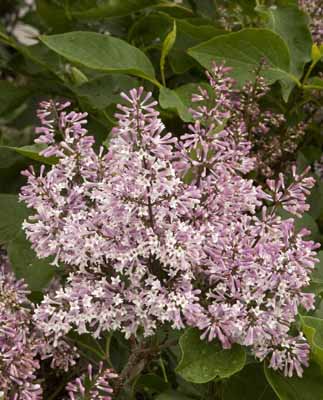
Syringa patula 'Miss Kim'
Lilac
Showy 3 long panicles of fragrant purple flowers grace this dense, full shrub in mid - May. Leaves are deep green and somewhat glossy and tend to keep clean throughout the growing season.
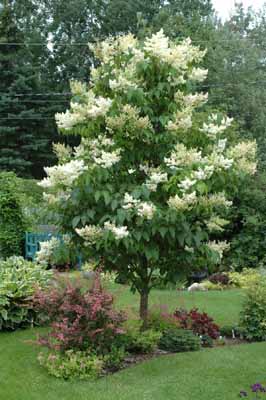
Syringa reticulata 'Ivory Silk'
Ivory Silk Lilac Tree
Trouble free and spectacular, this plant will be a blooming masterpiece in any landscape. Round, dense form is covered with creamy white, 6-12" long panicles of flowers in June. A real beauty!
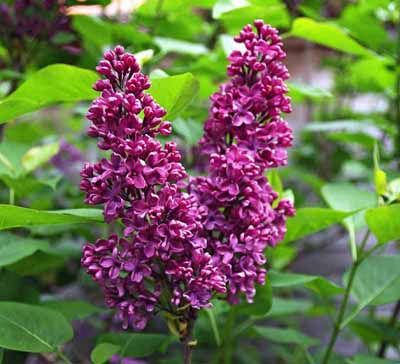
Syringa vulgaris 'Monge'
Lilac
A french hybrid classic lilac with incredibly fragrant blooms that last nearly a month.
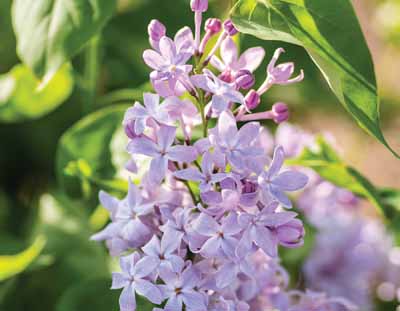
Syringa vulgaris 'New Age Lavender'
Lilac
This compact, unique Lilac is beautiful in both the landscape and containers. It produces fragrant, lavender flowers in the spring, is resistant to mildew, and displays attractive foliage throughout the season.
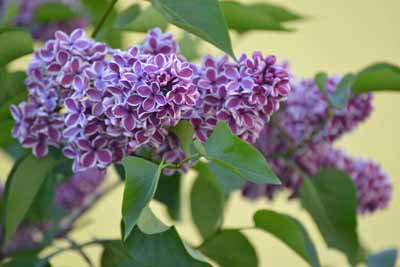
Syringa vulgaris 'Sensation'
Sensation Lilac
Displays unique two-toned flowers of deep purple with white edges, contrasted by lovely, dark green, heart-shaped leaves. A lightly sweet fragrance adds to this individuals appeal: butterflies and hummingbirds cant resist!

Syringa vulgaris 'Yankee Doodle'
Yankee Doodle Lilac
Impress your friends and neighbors with this great selection, boasting the deepest, darkest purple of any other lilac! This profuse blooming beauty loads up with flower buds and bursts into color in early May

Syringa x hyacinthiflora 'Pocahontas'
Lilac
A profuse bloomer, 'Pocahontas' features deep violet - purple buds that open to fragrant, single, deep violet florets throughout the month of May.. Deep green foliage completes this upright and vigorous plant.

Taxus x media 'Densiformis'
Spreading Yew
A very densely growing shrub form of Yew - many times twice as wide as it is tall. Nice deep green needles, with new growth emerging as a brighter green and eventually maturing to deep green. Excellent choice for use as formal hedge, takes very well to pruning / trimming. Will do well in full sun, but will really perform well if given just a bit of shade as a break from high summer heat. Likes well drained soil that is somewhat moist and slightly on the acidic side.
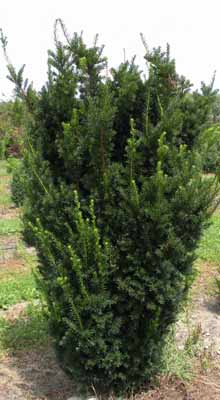
Taxus x media 'Hicksii'
Hicks Yew
This selection is narrowly columnar in habit with needles that are lustrous dark green above and lighter green beneath. Easily grown in average, well-drained soils, and will tolerate full sun to even deep shade

Thuja 'Fire Chief'
Globe Arborvitae
A durable orange globe arborvitae! Fire Chief arborvitae is a sport of 'Rheingold' with much brighter spring foliage and a deeper red tinge to the new growth all season. It is also less prone to splitting. Use it to add bright, year-round color to landscapes.
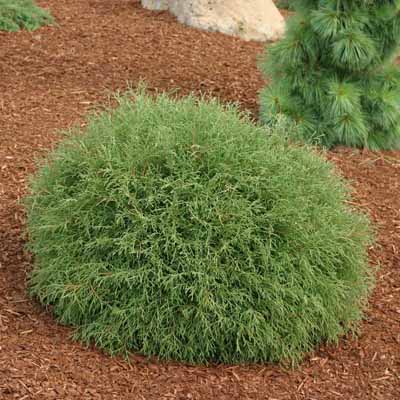
Thuja 'Mr. Bowling Ball'
Globe Arborvitae
True to its name, Mr. Bowling Ball arborvitae is a dwarf, mounded globe with soft, sage-green juvenile foliage. The habit is tight and compact, creating an outstanding landscape or container plant.

Thuja occidentalis 'Anna's Magic Ball'
Arborvitae
Anna's Magic Ball arborvitae is a cute little sphere of cheerful yellow foliage. It was developed in Canada, so you know that this little plant isn't bothered by winter weather and holds its color all year-round. This nifty little native evergreen needs no pruning to keep its tight, rounded shape and makes a nice addition to perennial beds, rock gardens, troughs and containers, or any landscape project. It's petite size and well-behaved manner makes it an especially nice choice for smaller yards and gardens. Native to North America. Shade tolerant
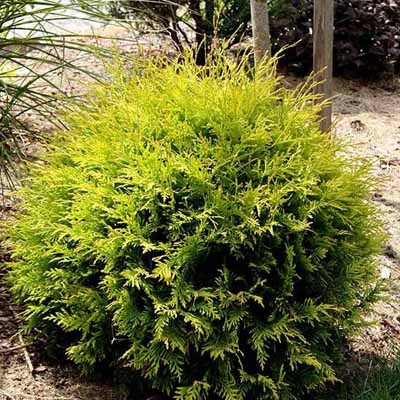
Thuja occidentalis 'Golden Globe'
Arborvitae
This is a golden-yellow, globe-shaped evergreen shrub. It is ideal as a low hedge or as an accent in the landscape. Requires little maintenance.
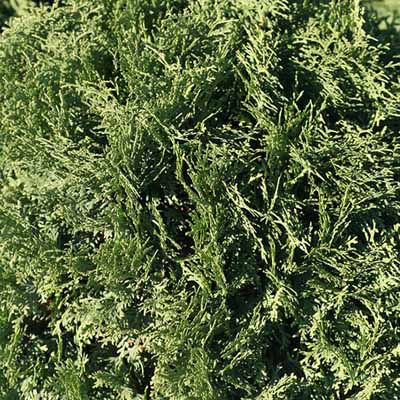
Thuja occidentalis 'Little Giant'
Little Giant Arborvitae
This small, globe-shaped, evergreen shrub is a very versatile and useful plant, noted for holding its color well, even through the winter months.
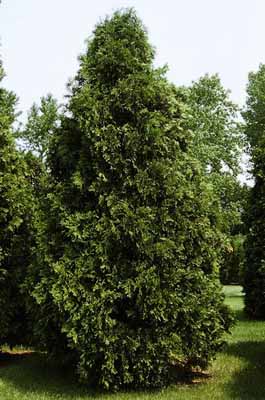
Thuja occidentalis 'Nigra'
Dark American Arborvitae
Growing quickly and having a narrow, upright form, 'Nigra' is covered in densely held, deep green, fan - like foliage. It's small footprint makes it easier to work with. Perfect fro growing in full sun or partial shade, it tolerates all but the wettest of soils. The perfect screening tree with numerous seed capsules and a dense habit that will attract birds.
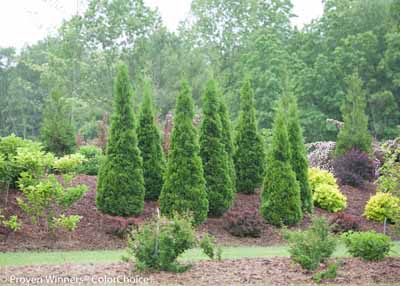
Thuja occidentalis 'North Pole'
Arborvitae
Narrow upright columnar habit is perfect for narrow sites as a specimen or screen. Little care is needed. Evergreen. Hardy, resists winter burn. Excellent landscape plant. Native to North America.
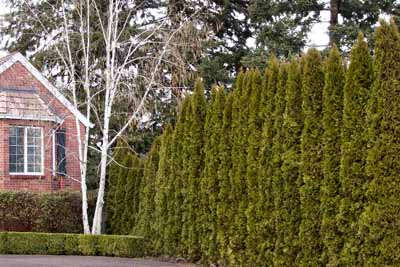
Thuja occidentalis 'Smaragd'
Emerald Green Arborvitae
Very ornamental and deservedly popular because of its narrow, uniform habit, 'Smaragd' also offers glossy, soft, emerald green color in summer and winter. Adaptable and easy to grow.
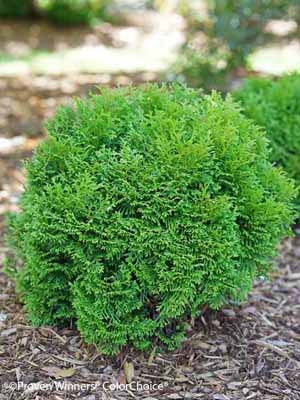
Thuja occidentalis 'Tater Tot'
Arborvitae
Irresistible green globes of cedar-scented, fan-like foliage are virtually maintenance-free! Native to North America, this dwarf evergreen is perfect for year-round beauty in rock gardens, edging a pathway or even a larger container.
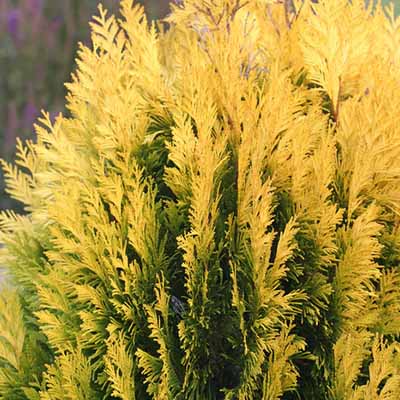
Thuja plicata 'Forever Goldy'
Western Arborvitae
This ever golden compact shrub grows quickly into a stunning display of gold-yellow foliage that will not shed. Both heat and drought-tolerant. Excellent for planting in a container on the patio, or at the back of a border.

Thuja plicata 'Spring Grove'
Western Arborvitae
The solution to deer problems! This fast growing, cold hardy selection of Western Arborvitae shows excellent resistance to deer browsing. Spring Grove was selected for its superior winter color and hardiness. It maintains a dark green, glossy color even in Midwest winters, and has survived -25 degree temperatures. The tight pyramidal habit works nicely in landscape designs, and its hardiness and deer resistance makes it a good choice for many suburban locations, especially for creating fast-growing privacy screens.

Thuja plicata 'Whipcord'
Western Red Cedar
A dense, multi-stemmed evergreen shrub with finely textured, green foliage and gracefully arching branches. Foliage turns bronze in winter. Excellent for use as a specimen plant or in group plantings for added appeal in the landscape.
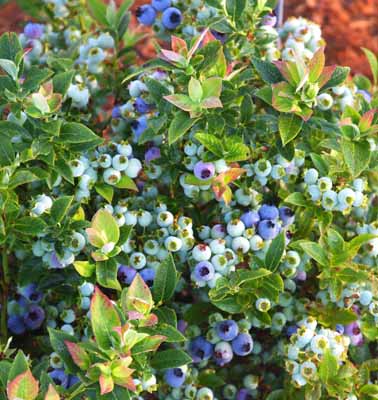
Vaccinium 'Jelly Bean'
Jelly Bean Blueberry
Jelly Bean has large, flavorful blueberries that taste like sweet homemade blueberry jelly. The foliage has unique, elongated green leaves with highlights of red in cooler climates.
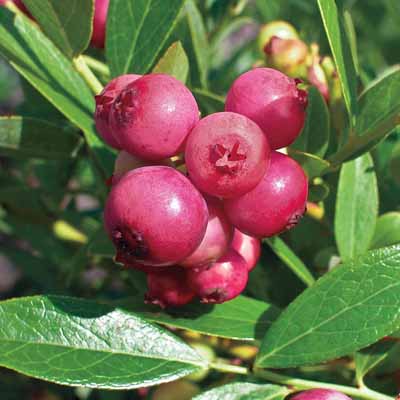
Vaccinium 'Pink Lemonade'
Pink Lemonade Blueberry
Extremely hardy. Unique pink colored fruit stands out. Heavy producer. Early to harvest with good taste and texture. Brilliant fall foliage color.
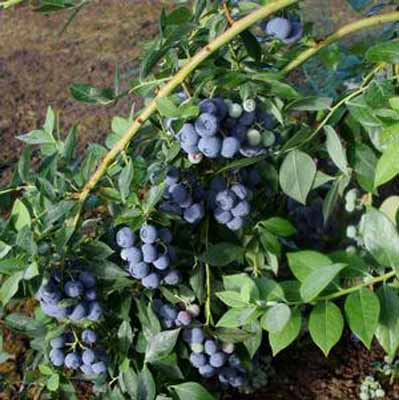
Vaccinium corymbosum 'Berries Gallore'
Highbush Blueberry
A combination planting of 3 different corymosum blueberries. An early, mid and late producer that will ensure a long berry picking season. Provides a "berry" long berry picking season!

Vaccinium corymbosum 'Blue Jay'
Highbush Blueberry
Humans and landscape critters alike will find it hard to resist this American Beauties selection. Robust and rounded, 'Blue Jay' is easy to grow, tolerating dry acidic, poor soils and partial shade while yielding an impressive crop of deep blue, sizable berries in August. Not only do humans love the fruit, countless songbirds and small mammals count it as one of their favorite foods, making it a magnet for wildlife in the landscape while native bees and butterflies seek out the nectar from its May flowering. 'Blue Jay' also provides outstanding cover for these birds and mammals, all while looking great in the landscape with deep green foliage that puts on a remarkable purplish-red fall show.
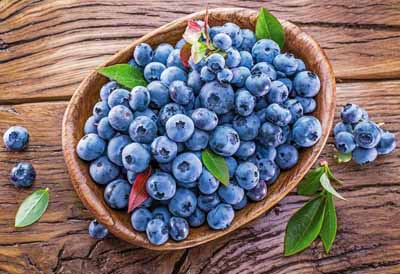
Vaccinium corymbosum 'Blue Ray'
Highbush Blueberry
This highbush blueberry cultivar is an upright, deciduous shrub which typically grows 5 - 8' tall but is more manageable as a fruit crop when pruned to 6' or less. Dainty, waxy, bell - shaped, white flowers appear in May. Flowers are followed by medium sized powder blue blueberries which ripen in mid - season. Ovate, dark green leaves turn brilliant, burgundy red in fall. Reddish stems have better winter color than those of most other blueberry varieties. Blueberries love acid soil.
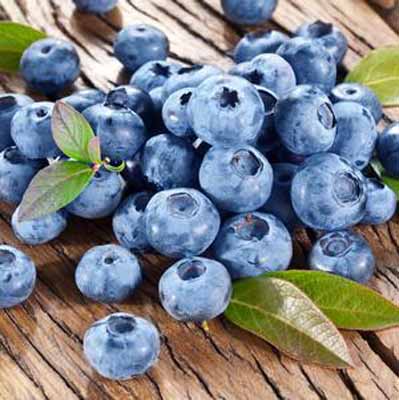
Vaccinium corymbosum 'Bluecrop'
Highbush Blueberry
Midseason - Considered the best all around variety for consistent yields; large, high quality fruit and disease resistance. Bluecrop is an upright, open growing shrub to 5 - 6 feet. There are other varieties with better ornamental value but none better in the garden. The most popular variety in North America. Turn attractive shades of red in fall. Reddish stems can be attractive in winter. Blueberries love acid soil.
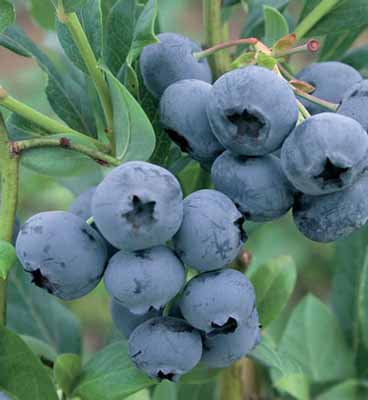
Vaccinium corymbosum 'Duke'
Highbush Blueberry
Slighly tart, very firm berry is perfect for fresh eating but also one of the best berries for freezing allowing you to enjoy 'Duke' long after its profuse crop has been picked
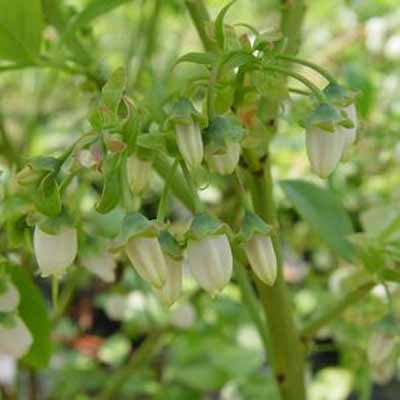
Vaccinium corymbosum 'Jersey'
Highbush Blueberry
Big, burly, and productive, 'Jersey' is an old time variety that keeps on growing. 'Jersey' is laden with huge numbers of small - to medium - sized, sweet, dark blue fruit late in the season and is a consistent producer of perfect fresh eating or pie berries year after year. Blueberries love acid soil.
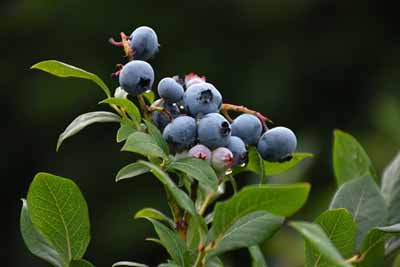
Vaccinium corymbosum 'Northland'
Highbush Blueberry
One of the hardiest Highbush Blueberries available, 'Northland' is also one of the most compact, yielding loads of fruit on a dense, rounded bush. While we humans love the easy to grow nature of blueberries, their great landscape look, and, of course, their luscious fruit, these plants are also an essential part of any living landscape. 'Northland's' May blooming flowers are a great source of early season nectar for native bees and butterflies while its summer fruit is a songbird magnet, so much so you might find it hard to get any yourself! Small mammals also prize the fruit while the plant provides needed cover for birds and mammals for nesting. 'Northland' tolerates dry, acidic, poor soils, grows well even in partial shade, and tops off the year with a riveting display of searing purplish-red fall foliage color. This is one American Beauties plant that everyone will love!
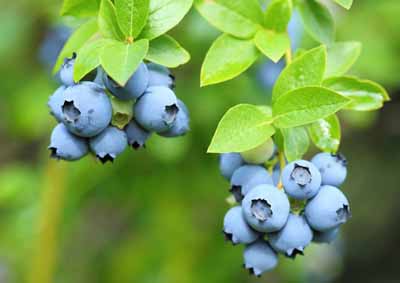
Vaccinium corymbosum 'Patriot'
Highbush Blueberry
This variety bears consistent crops of the largest early season blueberries around - the size of quarters! Production is high, ranging between 10 and 20 pounds at maturity. The berries are dark blue and highly flavored. Patriot is a low growing, spreading shrub to about 4' wide. It is adaptable to many soil types and will perform better in wetter soils than many other varieties. Patriot makes an excellent landscape variety with its showy white blooms in the spring, dark green summer foliage, and fiery orange fall colors. Blueberries love acid soil.
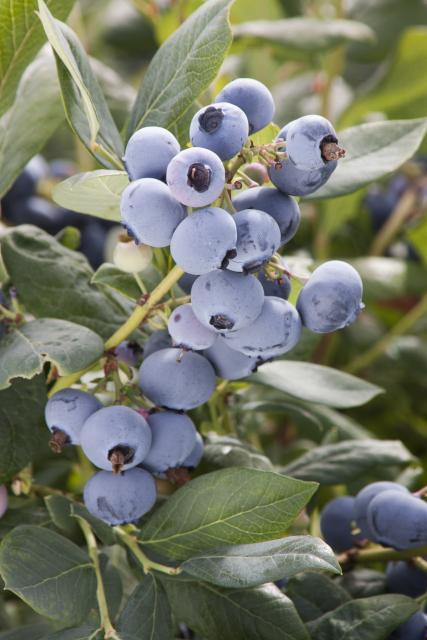
Vaccinium corymbosum 'Sunshine Blue'
Highbush Blueberry
One of the best for mild-winter areas, a low-chill selection perfect for small gardens or large patio tubs. Blue-green foliage and showy pink to white flowers provide ornamental value, followed by an abundant crop of fruit. Self-fruiting, but yields best when planted with another variety.
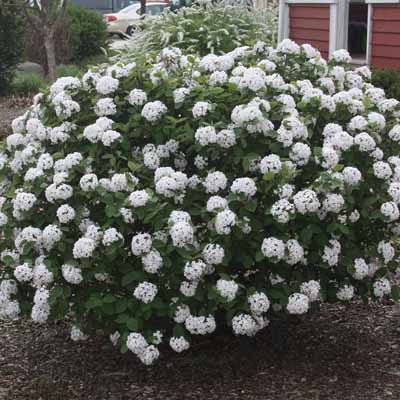
Viburnum carlesii
Korean Spice Viburnum, Arrowwood
A sweet, rich, spicy vanilla flower fragrance makes this variety one of the most sought after viburnums in this region. Bunches of deep pink buds open to mini - snowballs of creamy white flowers in late April. Late summer presents offerings of clustered red fruit that fade to black, drawing chattering birds. Leathery, deep green foliage turns wine - red in autumn. A real landscape gem.

Viburnum carlesii 'Spice Island'
Korean Spice Viburnum
Sweetly fragrant white flowers are in such tight balls they resemble snowballs. Unlike many viburnum carlesii, this variety blooms with its leaves fully expanded as a backdrop, enhancing the beauty of the flowers. Cooler fall weather turns the dark foliage into brilliant shades of burgundy and glowing red. A compact grower, Spice Island is slow to mature, perfect for garden paths, smaller spaces and as a specimen plant.
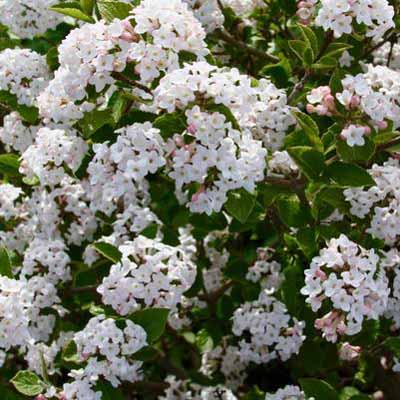
Viburnum carlesii 'Sugar N Spice'
Korean Spice Viburnum
Sweetly scented flowers are extremely fragrant and will fill the air with the sweet-spice scent in early spring. Sugar n' Spice is slow-growing and forms a nice rounded shrub with pleasing red fall color. Easy to grow with great landscape rewards! The fragrant flowers of Sugar n Spice Koreanspice Viburnum attract birds, butterflies, and other pollinators in spring. Thrives in full sun in average to rich, well-drained soil. Prune to shape if needed after flowering in late summer.
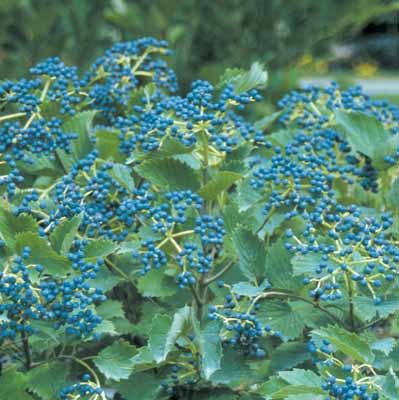
Viburnum dentatum 'Blue Muffin'
Arrowwood Viburnum
This handsome selection of the North American native arrowwood viburnum boasts neat foliage, white spring flowers, and, if a different selection is planted nearby, the namesake blue fruits in autumn. It's ideal as a hedge or specimen plant, and is very low maintenance. At present, there are no Proven Winners varieties that are suitable for pollinating Blue Muffin, so we recommend Chicago Lustre, which is a widely-available selection.
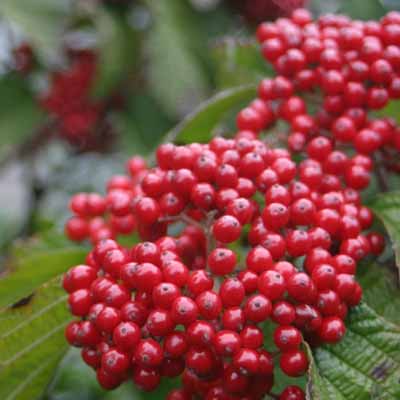
Viburnum dilatatum 'Cardinal Candy'
Linden Viburnum
Cardinal Candy viburnum has improved hardiness compared to other varieties of linden viburnum, so even northern gardeners can finally enjoy the impressive display of bright red berries in fall. Tons of creamy white flowers cover the plant in spring. The plant itself has a nice, well-branched habit, and fits nicely into the landscape. Berries are not edible by humans. Though Cardinal Candy viburnum will set fruit without a pollinator, planting near Tandoori Orange viburnum results in abundant fruit on both.

Viburnum p. t. 'Mariesii'
Doublefile Viburnum
Mariesii is a doublefile viburnum noted for its distinctively layered horizontal branching. Non - fragrant flowers in flat - topped, lacecap - like clusters bloom in profusion along the branches in April or May, causing a magnificent sight when in full bloom. Flower clusters appear in two rows or files along the branch, hence the common name. Flowers give way in summer to red berry - like drupes which eventually mature to black. Dark green healthy leaves turn reddish purple in fall; excellent plant for massing or as a specimen, tolerant of drought.

Viburnum plicatum 'Shasta'
Shasta Doublefile Viburnum
Vigorous and spreading, this selection's symmetrical branching lines up with showy, brilliant white flowers along the tops of branches in late May. Red to black berries follow in summer. Vigorous nature makes it perfect for grouping to form a hedge.
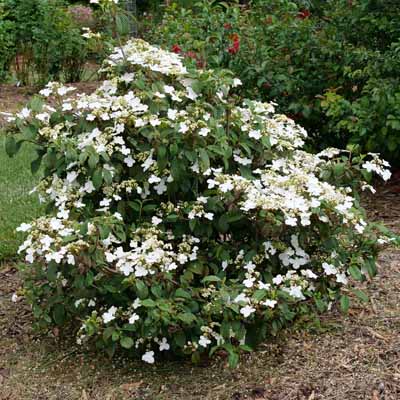
Viburnum plicatum 'Steady Eddy'
Doublefile Viburnum
Not your run of the mill doublefile viburnum! In our trials, it has beaten out 'Summer Snowflake' with improved, stronger blooming. You can see for yourself with its long bloom time in spring and repeat blooming in the summer. Its elegant, lacy blooms are held on a strongly horizontal habit, which brings a unique architectural feature to the landscape. Foliage is dark green, glossy, and has the hallmark deep veining of the species, which altogether looks lovely in the landscape and performs well as a filler for cut flower arrangements. Fall color is a brilliant purplish-burgundy.
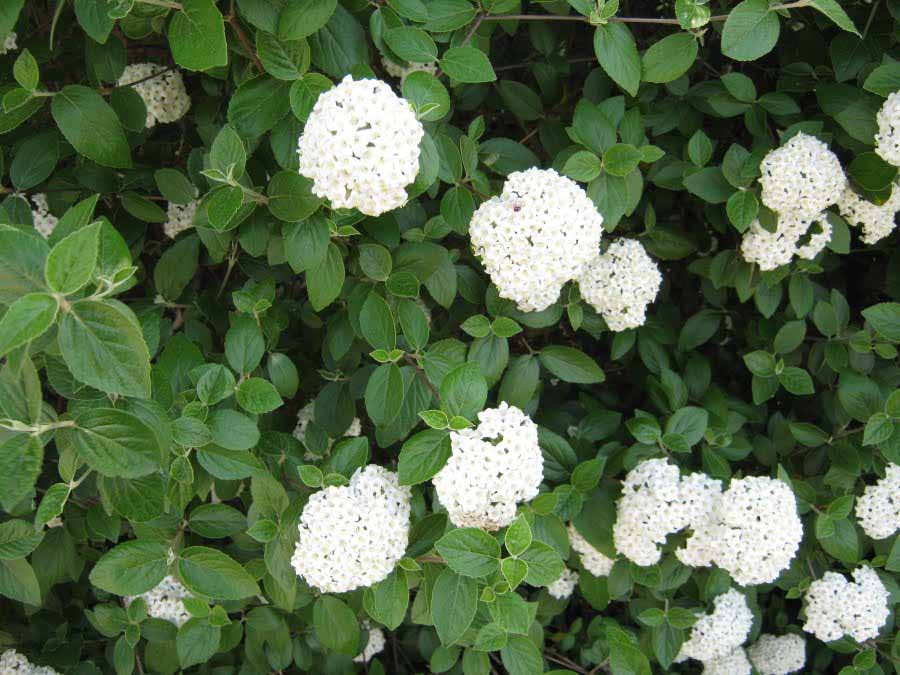
Viburnum x burkwoodii
Burkwood Viburnum
This shrub has a compact, rounded form, growing 8 - 10 feet tall and wide. In early spring, it produces showy lipstick - red buds that open to white flowers. Once open, the flowers scent the air with their spicy, clove - like perfume for another two weeks. The glossy dark green foliage is handsome throughout the growing season and resistant to bacterial leaf spot and powdery mildew. Foliage turns orange - red in autumn.
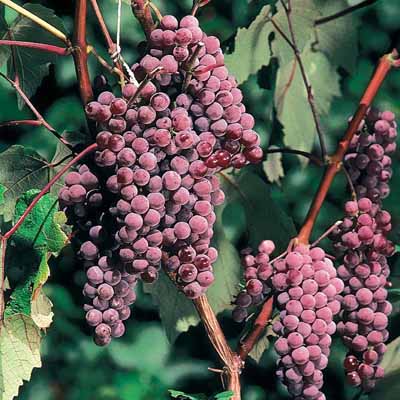
Vitis 'Canadice'
Grapevine
It's hard to beat this grape for taste and ease of growth. The compact clusters of large, seedless red grapes ripen in early to mid September. Easy to grow, 'Canadice', like all grape vines, can get big and it could use a supporting, heavy duty trellis or pergola for best production and ease of care. Grapes need full sunlight and high temperatures to ripen, so plant on southern slopes, the south side of windbreaks, or the south sides of buildings. Birds love grapes, so be sure to plant some to share
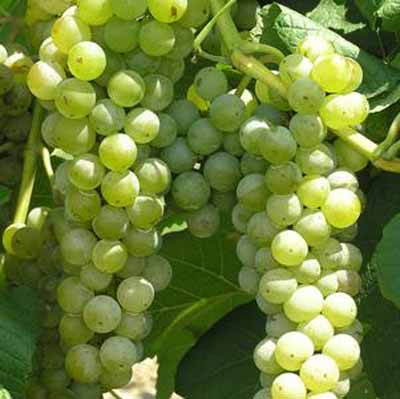
Vitis 'Cayuga White'
White Grape
Developed at Cornell University, this white Grape is perfect for growing in the northern home orchard and an incredibly heavy producer. This selection is widely used for producing a number of different white wines and is one of the easiest Grapes to grow with good disease resistance. September harvest.

Vitis 'Reliance'
Red Seedless Grape
A superb red seedless selection, this introduction features sweet flavored, medium to large clusters of berries. Vigorous, relatively disease resistant, mid-season ripening.

Vitis `Concord`
Grapevine
Vigorous and fruitful, this old, dependable variety still packs a punch with a multitude of medium to large clusters of big, sweet, highly aromatic black - blue grapes, the skins separate easily from the fruit for making jams and juices. Harvest late - August to September. Grape vines can get big and it could use a supporting, heavy duty trellis or pergola for best production and ease of care.
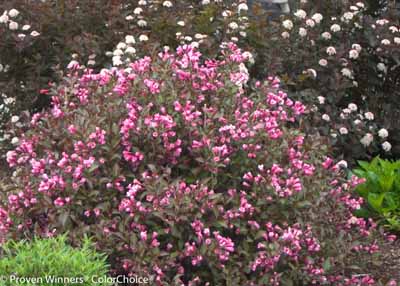
Weigela 'Fine Wine'
Weigela
Rich pink spring flowers often rebloom through summer. Dark purple foliage all season. Good for mixed borders or foundation plantings. Deer resistant. Season-long color.
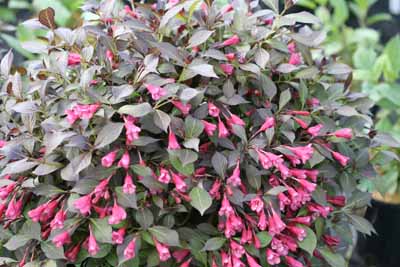
Weigela 'Midnight Wine Shine'
Weigela
Everything you love about Midnight Wine , but with more va-voom than ever! It has darker, shinier leaves which make a huge impact in the landscape from spring to fall. And as for autumn, you'll be relieved to hear that it has had displayed much better hardiness when it comes to tip die-back

Weigela 'Midnight Wine'
Weigela
Take a look at this seductive, burgundy - purple foliage and then watch it explode with masses of deep pink flowers in mid - June. Consider its low, dense, spreading form and you'll wonder why it's not in your garden!

Weigela 'My Monet Purple Effect'
Weigela
My Monet Purple Effect brings new color, more flowers, and better adaptability, while sharing all the charm and beauty of the original My Monet weigela. Its variegated cream and mint green foliage takes on purple (as opposed to pink) tones, and it is much better able to withstand the rigors of both cold and warmer climates. Though it is slightly larger, it can be used in much the same way: as a delightful companion to perennials, as a colorful edging, in a container, or anywhere you need a spot of clear, clean color.
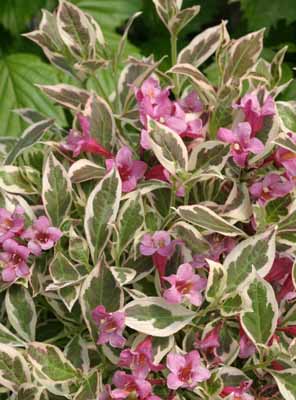
Weigela 'My Monet'
Weigela
This is the first dwarf variegated Weigela to be introduced. Its tight habit and colorful foliage make it very versatile. Variegation changes depending on light exposure - whiter variegation in shade and pink variegation in full sun. Deep reddish - pink flowers add to the mix in late May through June. It's easy to grow, loves full sun, and will brighten any spot in your garden.

Weigela 'Snippet Dark Pink'
Reblooming Weigela
Snippet weigelas are the best thing to happen to this spring-blooming favorite in years: they rebloom abundantly and naturally grow as a dwarf, rounded mound. They fit perfectly in just about any sunny spot in your landscape to add appealing structure and months of color. Snippet Dark Pink weigela has thick, deep green foliage that perfectly sets off the vivid pink blooms. They appear in late spring along with other weigelas, but then they continue to bloom all through summer with waves of fresh flowers. No deadheading required!

Weigela 'Sonic Bloom Pure Pink'
Weigela
Sonic Bloom Pure Pink weigela is the newest addition to this popular collection of top-performing reblooming weigelas. Like the others, its big, bold, trumpet-like flowers appear in late spring along with conventional weigelas, but the show doesn't stop. After a brief rest, waves of perfectly pink flowers appear up through frost. The larger Sonic Bloom weigelas are the perfect choice for a flowering hedge or a backdrop to any landscape or garden. Easy care, long blooming, and deer resistant.
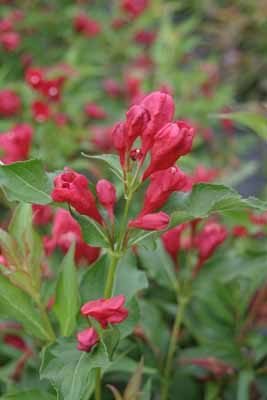
Weigela 'Sonic Bloom Red'
Reblooming Weigela
Lipstick red flowers in spring. Repeat flowers until frost. Reblooms without deadheading. Attracts hummingbirds.
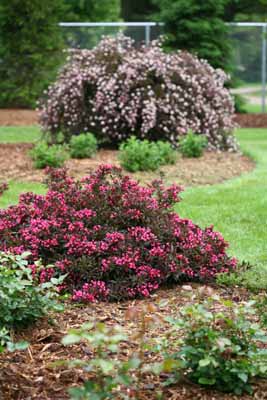
Weigela 'Spilled Wine'
Weigela
Spilled Wine weigela shares the fabulous deep purple foliage and bright pink flowers of the classic Wine & Roses weigela but in a smaller size. This useful plant grows wider than tall, making it the perfect choice for edging beds or walkways and for incorporating under windows in your landscaping. Like all weigela, it is deer resistant and very easy to care for.

Weigela 'Very Fine Wine'
Weigela
Top reasons to grow Very Fine Wine in your garden: Fantastic cold hardiness, less prone to tip dieback. Darker foliage, full season interest. Heavy bloomer.
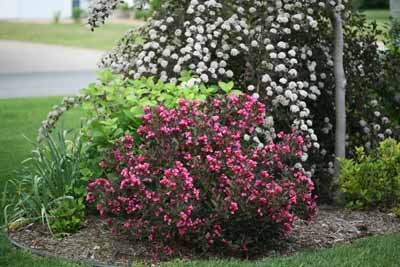
Weigela 'Wine & Roses'
Weigela
Rosy - pink flowers add a touch of romance when displayed against the dark glossy foliage. The foliage is much darker than that of older varieties. It contrasts beautifully with the rosy - pink flowers, making for a high impact display in the garden. This variety produces copious amounts of flowers in spring, and will re - bloom throughout the summer. The trumpet - like flowers are adored by hummingbirds!

Weigela 'Wine and Spirits'
Weigela
An update on our classic Wine & Roses weigela, this vigorous, handsome variety combines even more dramatic dark foliage with crisp white-green flowers. A real showstopper in the landscape. Deer resistant.
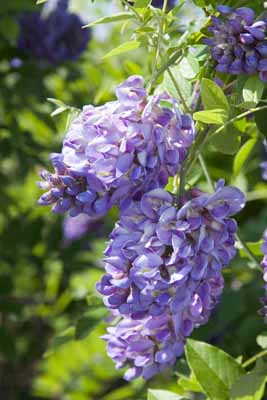
Wisteria 'Amethyst Falls'
Amethyst Falls Wisteria
Perfect for smaller spaces, this gorgeous twining vine grows at about a third of the rate of Asian wisteria. Blooms at an early age, with its lightly fragrant purple racemes weeping gracefully downward. Use in containers for porch or patio, train up an arbor or trellis,

Yucca filamentosa
Yucca, Adam's Needle
Upright sword - like evergreen foliage beneath 3 5 foot flower stalks with bell - shaped creamy white flowers in July and August. Fragrant at night. Prefers a dry, sunny location. Tolerant of poor, dry soils. Well suited to seashore gardens. Deer resistant. A traditional and durable favorite.
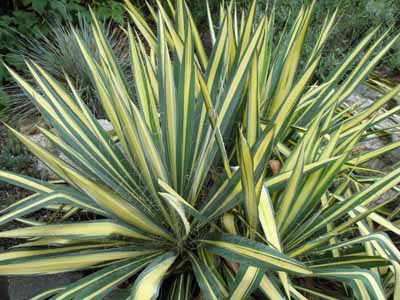
Yucca filamentosa 'Color Guard'
Color Guard Yucca
Slightly arching, sword-shaped, striped foliage of creamy-white against dark green provides great architectural interest. Showy spires of fragrant snow white blooms in summer.
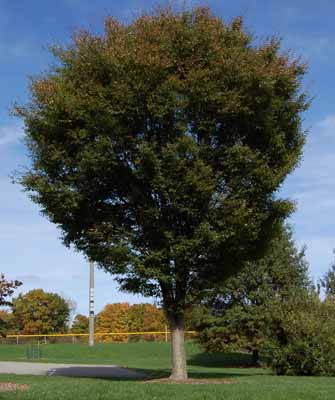
Zelkova serrata 'Green Vase'
Japanese Zelkova
Zelkova serrata 'Green Vase' has the distinctive, broad, vase shape of the typical species but grows almost twice as fast. 'Green Vase' has all of the other desirable characteristics of the species, including a wonderful scaffold of branches for a great winter silhouette, medium-sized, dark green leaves that turn soft yellow, orange and russet in autumn. This is a fine tree for the urban landscape as it has a high tolerance for wind, pollution, drought and compacted soils. Using a cultivar such as this one is effective when a consistent avenue of trees is desired.